Proposal Guidance and Request for Application
FY 2016 LRP Application Guidence and Request for Applications FINAL.docx
USDA Local and Regional Food Aid Procurement Program
Proposal Guidance and Request for Application
OMB: 0551-0046
OMB Control No. 0551-0046
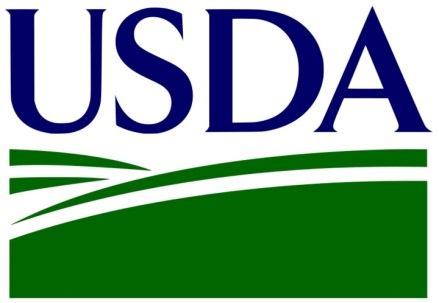
FOREIGN AGRICULTURAL SERVICE

Food Assistance Division
Office of Capacity Building and Development
FY 2016 Food Assistance Proposal
Guidance and Request for Applications
LOCAL REGIONAL PROCUREMENT (LRP) SOLICITATION
July 15, 2016
This page is left blank intentionally for formatting purposes.
U.S. DEPARTMENT OF AGRICULTURE
Foreign Agricultural Service
Notice of Availability of Funds and Funding Opportunity Announcement for the USDA Local Regional Procurement program (LRP)
ANNOUNCEMENT TYPE: Request for Application
FUNDING OPPORTUNITY NUMBER: USDA-FAS-LRP-17
CATALOG OF FEDERAL DOMESTIC ASSISTANCE (CFDA) NUMBER: 10.621
DATES: Applications must be submitted to the United States Department of Agriculture (USDA) through the Food Aid Information System (FAIS) by 5:00 P.M Eastern Standard Time (EST) on August 15, 2016. Applications received after this date will not be considered. The USDA Foreign Agricultural Services (USDA-FAS) advises applicants to begin the process early to allow time to address any difficulties that may arise. There will be no exceptions to this application deadline. Comments regarding this request for applications will be considered to the extent practicable, and should be submitted to [email protected].
EXECUTIVE SUMMARY: USDA- USDA-FAS is soliciting proposals for the LRP program for Fiscal Year (FY) 2016. USDA-FAS is expected to award multiple cooperative agreements totaling up to $5 million under the LRP program. Applications for cooperative agreements will be prioritized for the following countries: Haiti, Laos, Mozambique, and Rwanda. USDA may give preference for funding to eligible entities that have, or are working towards, projects under the McGovern-Dole International Food for Education and Child Nutrition Program (MGD). To fulfill its mandate under the Food, Conservation, and Energy Act of 2008, as amended by the Agricultural Act of 2014, USDA-FAS will enter into cooperative agreements with eligible organizations to implement field-based projects that improves of local or regional procurements of eligible commodities (including strengthen local production) in developing countries to provide development assistance and respond to food crises and disasters. USDA-FAS proposes these Local Regional Procurement Guidelines (guidelines) in accordance with 7 CFR Part 1590.
LIST
OF ACRONYMS
CCC Commodity Credit Corporation
CFR Code of Federal Regulations
CV Curriculum Vitae
DUNS Dun & Bradstreet
FAD Food Assistance Division
FAIS Food Aid Information System
FAO United Nations Food and Agriculture Organization
FAS Foreign Agricultural Service
FFPr Food for Progress
FY Fiscal Year
GDP Gross Domestic Product
IR Intermediate Results
ITSH Internal Transport, Storage, and Handling
LRP Local and Regional Procurement
M & E Monitoring and Evaluation
MCHN Maternal Child Health and Nutrition
MGD McGovern-Dole International Food for Education and Child Nutrition Program
MT Metric Tons
NGO Non-Governmental Organization
NICRA Negotiated Indirect Cost Recovery Agreement
NIFA National Institute of Food and Agriculture
OCBD Office of Capacity Building and Development
OMB Office of Management and Budget
PER Public Expenditure Review
PIN Personal Identification Number
PP Program Participant
PPP Private-Public Partnership
PMP Performance Monitoring Plan
PVO Private Voluntary Organization
RCT Randomized Control Trial
RF Results Framework
SAM System for Award Management
SF Standard Form
SFP School Feeding Program
SMC School Management Committee
SO Strategic Objective
UN United Nations
USAID United States Agency for International Development
USDA United States Department of Agriculture
USG United States Government
WAEMU West Africa Economic and Monetary Union
WB World Bank
WFP World Food Program
TABLE OF CONTENTS
PART I – FUNDING OPPORTUNITY DESCRIPTION 7
C. Purpose of Funding Opportunity 7
D. Priority Countries and Regions 7
PART III – ELIGIBILITY INFORMATION 8
C. System for Award Management 8
PART IV – APPLICATION AND SUBMISSION INFORMATION .9
Concept Paper Content and Format 9
Full Application Content and Format 10
Section I. An introduction and impact analysis 10
Section II. Plan of Operation 11
Section III. Required Appendices 15
Section IV. Project-Level Results Framework 17
Section VI. Monitoring and Evaluation 21
Section VI. Overall Application Quality 21
PART V – APPLICATION REVIEW INFORMATION 22
B. Selection Process…….……………………………………………………………………..23
I. Anticipated Notice on Selection and Award Dates……….…………………...………24
II. Discussion and Award…………………………………………………………………23
PART VI – AWARD ADMINISTRATION INFORMATION 24
D. Work Plan………….…………………………………………………………………….25
E. Administrative Standards and Provisions 25
H. Monitoring and Evaluation 26
APPENDIX A – Budget Narrative 27
APPENDIX B - Budget Template…………...…………………………………………………..31
APPENDIX E – Local and Regional Procurement Standard Indicator Definitions……………. 36
APPENDIX F – Country Specific Guidance…………………………………………………….57
APPENDIX G –Instructions for Submitting Proposals in the Food Aid Information System…..63
End notes 93
PART I – FUNDING OPPORTUNITY DESCRIPTION
The USDA LRP program is authorized by the Conservation, and Energy Act of 2008, as amended by the Agricultural Act of 2014.
The objectives of the USDA LRP program are to ensure the cost effective and timeliness provision of safe, quality foods to populations affected by food crises and disasters, and to strengthen the ability of local and regional farmers, community farmer groups, farmer cooperatives, processors and agribusinesses to provide high quality commodities in support of school feeding programs, development activities, and food crises; increase the capacity of organizations and governments to procure commodities in support of school feeding programs, development activities, and food crises.
Funds provided by USDA-FAS under the USDA LRP program may be used to provide food assistance in the form of development assistance, an emergency response, or both, through a field-based project for a period of not less than one year. Under the USDA LRP program, recipients use USDA-FAS-provided funds to purchase eligible commodities (includes activities to improve the availability of supply) in developing countries and pay for associated administrative and operational costs related to the implementation of field-based projects in a foreign country pursuant to an agreement with USDA-FAS.
Priority Countries and Regions
USDA-FAS may give preference for funding to eligible entities that have, or are working towards, projects under the McGovern-Dole International Food for Education and Child Nutrition program (MGD). Applications will be prioritized for the following countries: Haiti, Laos, Mozambique, and Rwanda.
PART II – AWARD INFORMATION
USDA-FAS anticipates that cooperative agreement(s) will be awarded as a result of this solicitation (reference 2 CFR 200).
Estimated Funding:
USDA-FAS expects to award an estimated $5 million in FY 2016. Individual application should be in the range of $2 million to $2.5 million. Applications may be fully funded under this round, or incrementally funded in subsequent years, subject to the availability of funds. Issuance of this solicitation does not constitute an award or commitment on the part of the U.S Government to make awards, nor does it commit the U.S. Government to pay for costs incurred in the preparation and submission of a concept note or full application.
Anticipated Start Date
Funded projects are anticipated to start in October 2016.
Period of Performance
USDA-FAS seeks proposals for implementation up to a 2 year period, except where indicated under Country Specific Guidance.
PART III – ELIGIBILITY INFORMATION
Applicants must meet eligibility requirements stated in the LRP Program Regulations (7 CFR Part 1590, Part 1590.1 and 1590.3 eligibility and conflicts of interests) and 2 CFR 200.205 and specifically as follows:
An entity (including subcontractors/sub-grantees) will be considered ineligible if they have been designated by the US Government as debarred or suspended from procurements funded by the United States Federal Government or otherwise prohibited by applicable United States law or executive order or United States policies. USDA-FAS will review inter alia:
US State Department, Terrorist Exclusion List: http://www.state.gov/j/ct/rls/other/des/123086.htm
US Department of Treasury, Specially Designated Nationals List: http://www.treasury.gov/resource-center/sanctions/SDN-List/Pages/default.aspx
General Services Administration, System for Award Management (SAM): http://www.sam.gov
Federal Awardee Performance and Integrity Information System
Cost sharing is not required for eligibility but is encouraged to maximize program impacts and elicit in-country sustainability. Applicants must identify and explain any cost sharing in the budget narrative. Applicants must also document these non-USDA-FAS cash or non-cash contributions accordingly on the Standard Form 424 (SF-424) associated with their proposal submission, as per 7 CFR 1590.4(b) (4) (i). If an award is made, the applicant will be responsible for obtaining these resources. These resources will not be borne by USDA-FAS funding.
Applicants must include a valid DUNS number in the organizational unit section of Block 8 of SF-424. All sub-recipients listed in the proposal must have a current DUNS number. Organizations that do not have a DUNS number can obtain a DUNS number at no cost by using the web-based form available at http://fedgov.dnb.com/webform.
In addition to having a current DUNS number, applicants must be registered in the System for Awards Management (SAM) prior to submitting an application to this solicitation. Instructions for registering in SAM can be found at https://www.sam.gov. If awarded a grant, a Program Participant must maintain an active SAM registration number with current information throughout the duration which it has an active federal award or an application under consideration. To remain registered in the SAM database after the initial registration, the Program Participant is required to review and update the registration every 12 months from the date of initial registration to ensure the information is accurate.
PART IV – APPLICATION AND SUBMISSION INFORMATION
To be considered for funding under this solicitation, applications must be able to meet the following requirements for the full application, respectively. Each of the listed sections will require data to be directly entered into FAIS or provided as an attachment. Each proposal will be reviewed and evaluated on its quality and technical merit.
Application Format:
General Format: The application must:
Be written in English;
Be written using Times New Roman, 12 point font;
Be written with 1-inch margins;
Be paginated with each page consecutively numbered; and
Not exceed Fifteen (15) pages. The fifteen page limit does not include the cover page and appendices. Pages in excess of this stated limit will not be considered.
All sources should be cited and/or provide an explanation of the analysis undertaken.
The Application should be developed using the following format:
Cover Page: The Cover Page must include:
Name and address of organization;
Type of organization (e.g., for-profit, non-profit, university, local organization);
Name of project/activity, solicitation number and requested funding amount;
Contact point (lead contact name, relevant telephone, and e-mail information); and
Signature of authorized representative of the applicant.
The Application Content
The application should include:
Section I. An introduction and impact analysis
Proposals must include a comprehensive analysis of the existing needs, challenges, opportunities, and constraints that may impact the implementation of a project in the recipient country. This section should explain the strategy behind the proposed method of intervention and describe how the project will implement this strategy. The analysis will be evaluated based on how well the project is aligned with host government laws, policies, and programs; how well the proposed project will coordinate with United States Government (USG), multilateral, private sector, or other stakeholder development strategies or frameworks; and how the proposed program will complement, and not duplicate, existing projects and programs.
The following must be included in this section:
Identify the targeted beneficiaries, regions, and specific needs of the targeted population, and the rationale on why they were chosen;
Explain how the project will strengthen the ability of local and regional farmers, community farmer groups, farmer cooperatives and associations, processors, and agribusinesses to supply food crises and disasters;
Describe how the program will increase capacity of organizations and governments to procure commodities in support of school feeding programs and responses to food crises and disasters;
Describe how the program will incorporate strategies to improve nutritional status of beneficiaries, and improve access to diverse, nutritional, quality foods;
Explain how the program will reduce food insecurity, while ensuring the expedited provision of safe, quality foods to populations affected by food crises and disasters;.
Explain the working relationship with the recipient government, the collaboration done to develop the proposed project, and how the project would leverage other development resources to achieve their results;
Identify specific in-country constraints, including potential climate change risks, that could obstruct the project’s efforts to address the identified needs; and
Provide a realistic assessment of opportunities to link and synergize with USG and other donor funded activities. Please include any current programs, policies, and strategies of other stakeholders (recipient government, USG, other donors, private sector, etc.) with the strategic objective to increase the capacity of local and regional food market systems in support of school feeding programs and responses to food crises.
Section II. Plan of Operation
Activities: The Plan of Operation must include a list of the activities that would be implemented with a brief statement of the objectives to be accomplished and a detailed description of the activity, including the steps involved in its implementation and the anticipated completion date.
The activities section is evaluated based on the quality and technical merit of the content. It is important to demonstrate how the activities will address the needs identified in (Section I – Introduction and Impact Analysis). The activities should accurately capture the project scope, beneficiaries, and deliverables. Furthermore, this section must detail how these activities will lead to the results stated in the project-level results-framework (RF). The activities should not only identify the project’s targeted interventions, but also demonstrate how the project will complement existing efforts. Thus, the section should distinguish which activities will be implemented only by the Applicant, and those that will be implemented in coordination with other partners. Applicants must provide a brief description of the capacity of all sub-recipients and their role in project implementation.
Procurement Approach: Applicants must present a comprehensive description of their approach to procuring requested commodities, with special attention paid to market impacts and the extent to which requested commodities meet the needs of beneficiaries. This section of the proposal will include:
Method of Procurement: Describe whether local procurement, regional procurement, or vouchers will be used to procure requested commodities and a justification for why the method was chosen.
Market Impact Analysis Provide an analysis of the impact of procurements on markets in the location of the commodity origin and distributions in the project implementation area. The analysis should demonstrate that the proposed intervention is unlikely to do discernible economic harm to key market actors in the market-system, found in the locations of commodity origin, project distribution, and/or the target region. This includes a brief analysis of the current and anticipated future ability of markets in the project and procurement areas to provide adequate food supplies at relatively constant prices. Also, please reference the sources and methodologies used in completing the market impact analysis.
Please also include the following information:
Tonnage and packaging of commodity to be purchased as a percentage of the estimated total tonnage produced (in location of origin) and consumed (in location of distribution), which demonstrates applicants’ understanding of the economic impact of the project. Applicants must demonstrate how the project will take into consideration seasonal fluctuations in agricultural harvests, labor markets, and food commodity prices, including those for same or like products (substitutable commodities);.
Relevant local, regional, and international trading patterns, including trade for further processing of the commodities;
Significant local and regional supply constraints that may affect the proposed project (e.g., other large procurements or institutional purchases, poor harvests, import tariffs, restrictive trade policies). Please include recent supply (production), demand (consumption), import, and export statistics along with sources to support these statements;
Issues with competition at different levels of the market system, and whether the proposed project will negatively impact the market dynamics (e.g., by increasing the power of a few large producers at the expense of smallholders); and
Possible negative impact on stakeholders (e.g., traders, wholesalers, transporters, retailers, local producers, wage laborers, vulnerable non-beneficiaries).
Additional considerations for market analysis of voucher and cash transfer programs: Provide an analysis of the relevant commodity market(s) in the project location, using previous market analyses as references whenever possible. The analysis should demonstrate that vendors can respond to the increased demand that the cash/voucher project will create, without causing a shortage of the commodities in question and/or causing prices to rise for other low-income consumers who are not part of the project. In order for cash transfer or food voucher projects to work successfully, food supplies in the market must already meet or exceed demand and a sudden loss in purchasing power, or demand, should be the primary constraint to meeting acute food security needs. Applicants must demonstrate how the project will take into consideration seasonal fluctuations in agricultural harvests and marketing, labor markets, and food commodity prices.
To assist in developing an analysis, USDA recommends consulting FEWS NET and, as appropriate, using market assessment tools such as:
MIFIRA, or Market Information and Food Insecurity Response Analysis;
EMMA, or Emergency Market Mapping and Analysis;
SCP, or Structure, Conduct and Performance Framework;
FPMA, or Food Price Monitoring and Analysis Tool; or other appropriate tools.
Commodity Quality:
All proposed eligible commodities, processed and unprocessed, must be produced or processed within the target country or region, and must satisfy relevant quality and safety standards.
For grains, legumes and pulses, the commodities must meet national food safety standards. If the country does not have food safety standards, the commodities must adhere to Codex Alimentarius standards.
For commodities other than grains, legumes and pulses, the commodities must adhere to Codex Alimentarius standards.
Cereals, groundnuts, tree nuts or derived food products must be tested for aflatoxins at a government or private laboratory or by an independent inspection company within the region. The maximum acceptable total aflatoxin level is 20 parts per billion.
Unprocessed commodities must be purchased in the target country or another developing country in the target region. It must be ensured that, for processed commodities, both processing and production of the primary commodity take place in the target country or in a developing country in the target region.
A description and justification of the method of procurement: local, regional, or using cash vouchers.
Additionally, the application must provide information on the nutritional contributions (e.g. calories, protein, and micronutrients) of the commodity.
Economic Impact
An application should include a procurement and distribution plan with dates that are sensitive to seasonal market fluctuations in both procurement and distribution markets. The economic benefits identified under the USDA Local and Regional Food Aid Procurement (LRP) Pilot Project during the period of 2009-2012 and documented in an independent evaluation report (http://www.fas.usda.gov/newsroom/local-and-regional-food-aid-procurement-pilot-project-independent-evaluation-report) included: cost savings in transport, shipping, and handling; better match between recipients’ needs and program commodity availability; and time savings between the procurement and delivery of food, which is especially important in emergency situations. Since commodities purchased under the program do not need to be shipped across oceans, the transport, shipping, and handling costs are expected to be lower than in-kind food assistance. Delivery times for emergency food aid under the LRP pilot project yielded faster delivery than in-kind food aid shipped from the United States. As a result of the LRP pilot project, small-scale producers and suppliers began pooling resources to achieve economies of scale to increase their profitability. The USDA LRP program is expected to maximize the impact of food assistance by realizing similar results achieved under the pilot. The Applicant will also assert that procurement of commodities will not, to the best of its knowledge, have undue impact on world prices or normal patterns of commercial trade. If applicable, the plan must provide information on the extent to which any sale or barter of the requested commodities would displace or interfere with any sales that may otherwise be made by the Applicant or any other entity in the target country (Executive Order 12866 and 13563).
In order to show the summary of the Economic Impact, applications should show the following:
Timeliness: Timeliness is important for local regional procurement. Applicants must demonstrate timeliness by providing analysis of using the LRP approach versus actual transoceanic food aid deliveries to the same country, and during the same time period. This analysis should take procurement type, infrastructure, climate conditions, geography (landlocked versus coastal), regulations in procurement locations and distribution zones, commodity type, capacity of suppliers, and other relevant factors into consideration.
Cost Effectiveness: Provide estimate of cost‐effectiveness by comparing LRP activities (including procurement type) against transoceanic deliveries to the same country matched in time, and by commodity. In generating cost‐effectiveness estimates, include the cost of the purchased commodity, ocean freight, and ITSH for food aid shipments from the US using USDA commodity and ocean freight costs. Please note that while voucher programs do not incur storage or handling costs, they do involve other costs such as printing, distribution, monitoring, and training which must be taken into account.
Special Needs & Distribution Methods
Each proposal must include detailed information on special needs and distribution of commodities.
Transportation and Storage
The Applicant must provide a clear description of any port, transportation, storage, and warehouse facilities that would be used with sufficient detail to demonstrate that the facilities would be adequate to handle the requested commodities without undue spoilage or waste, and, in the cases where the applicant proposes to distribute some or all of the requested commodities, a clear description of how they would transport commodities from the procurement market to the point at which distribution is made to the beneficiaries (7 CFR Part 1599.4(d)(13)). The Applicant must address inland transportation, handling and storage (at all levels) of the procured commodities.
Processing or Packaging
The Applicant must provide information on any reprocessing or repackaging of the requested commodities that would take place prior to the distribution.
Duty-Free Entry (1590.5 (e.3))
The Applicant must indicate that commodities procured regionally for direct distribution will be imported and distributed free from all customs, duties, tolls, and taxes. Additionally, the applicant must provide information on the action it has taken or will take to ensure that any requested commodities for direct distribution will be imported and distributed free from all customs, duties, tolls, and taxes.
Commodity Selection, Justification to target Beneficiaries
The Applicant must provide a clear explanation of how the requested commodity helps address the nutritional and micronutrient deficiencies of the intended beneficiaries. The Applicant must explain the intended (per serving) nutritional contribution from the ration such as calories, protein, and key micronutrients that are age appropriate Applicants must also explain how the commodity selection was determined in the context of other feeding programs in the region or country and for the appropriateness of the local diet. Once the Applicant has chosen the commodities, the total amount of each commodity needed for the project should be calculated. Please use the following formula to calculate the number of metric tons (MT) needed for each commodity:
MT of each commodity = (Grams per student per day x Total number of students receiving commodity x the Number of days the ration will be provided) divided by 1,000,000.
Impact on Other Sales
The Applicant must provide information that demonstrates that commercial markets and local production will not be adversely affected by the sale of commodities.
Section III. Required Appendices
Organizational Capacity and Staffing:
The Applicant must clearly demonstrate its organizational capabilities to develop, manage, implement, monitor, report on, and provide accountability for the proposed project in the target country (7 CFR 1599.3(a)(1)). Information provided should include the applicant’s project management capability and current and past experience in implementing food aid (7 CFR 1599.4(c) (4)), education, or health and nutrition projects, including its experience within the target country.
Applicants should propose an overall staffing pattern that demonstrates technical expertise required for efficient and effective project administration and management. The staffing plan should demonstrate a solid understanding of key technical and organizational requirements and an appropriate mix of skills, while avoiding excessive staffing. USDA-FAS may request changes to the final staffing plan during award negotiation or project implementation as necessary. The applicant must attach an appropriate and adequate project organizational chart. The organizational chart must include and note key personnel positions and the roles and responsibilities of each position. Key personnel positions are deemed essential to the successful operation of the project and completion of all proposed activities and deliverables. The applicant should refer to their internal administrative policies for determining key personnel, and may include positions such as the following: Chief of Party/Country Director, Monitoring and Evaluation Specialist, Education/Literacy Program Manager, Health and Nutrition Manager, Logistics Manager, and Finance Director.
The Applicant must identify any sub-recipient that would be involved and provide a description of each sub-recipient’s responsibilities and its capability to perform those responsibilities. Sub-recipient means a non-Federal entity that receives procured commodities, USDA-FAS-provided funds, program income, sale proceeds, or other resources from the recipient for the purpose of implementing, in the target country, activities described in the agreement, and that is accountable to the recipient for the use of such commodities, funds, program income, sale proceeds or resources.
Curriculum Vitae (CV) for Chief of Party or Country Director
As part of the proposal, the Applicant must attach the CV for the lead project manager (e.g. Chief of Party, Country Director, etc.) for the proposed project. This person should provide major oversight of the proposed project. The CV must clearly demonstrate the lead project manager’s relevant work experience and qualifications. CVs for other designated key personnel are not required during proposal submission; however, they will be required after award announcements are made.
Staffing Plan
The staffing structure should be as cost effective as possible. The applicant must submit a supporting narrative which should include a brief description of all long-term staff positions and level of experience. Description of the role of short-term technical staff including the proposed level of effort and the process to be used for selecting them should be indicated. Applicants should propose an overall staffing pattern that demonstrates technical and regional/national expertise and experience required for successful project implementation, administration, and management. The staffing plan should demonstrate a solid understanding of key technical and organizational requirements and an appropriate mix of skills, while avoiding excessive staffing and duplication of staff deployment.
A detailed organizational and management chart that clearly delineates lines of management, supervisory authority, technical roles and responsibilities, level of effort for each position, and justifies the composition and organization structure of the entire project team is also required as part of the application. Roles and responsibilities of proposed partners, including sub-grantees, should be included. The Applicant must specify their key personnel in the appropriate FAIS section and provide the percentage allocation of each position to the proposed project for these positions.
In-Country Registration
Applicant must disclose its registration status in the targeted country. If the Applicant is not registered, it must include a plan to become registered and a timeline to complete the registration process (7 CFR 1590.4(c)(3)).
Past Performance Records
Applicants should attach past performance records for no more than three grants or contracts implemented by the organization. Applicants are encouraged to include past performance records of grants or contracts that are similar to the scope and size of programming in the applicant’s proposal, including those of grants or contracts implemented in the proposed country and/or specifically mentioned in the Applicant’s introduction section of the proposal. Applicants are strongly encouraged to submit past performance record for grants or contracts other than for past or active MGD and Food for Progress (FFPr) awards.
AD-3030
All domestic applicants that are corporations should complete, sign, and attach the one-page AD-3030 form: “Representations Regarding Felony Conviction and Tax Delinquent Status for Corporate Applicants.” A corporation is defined as any entity that has filed articles of incorporation in one of the 50 States, the District of Columbia, or the various territories of the United States including American Samoa, Federated States of Micronesia, Guam, Midway Islands, Northern Mariana Islands, Puerto Rico, Republic of Palau, Republic of the Marshall Islands, or the U.S. Virgin Islands. Corporations include both for profit and non-profit entities. An unsigned AD-3030 will not be accepted. Applicants can download a form at: http://www.fas.usda.gov/grants/forms/default.asp.
Guidance for Audited Financial Statements
Applicants should attach the organization’s most recent audited financial statements. If the applicant is subject to the audit requirements contained under 2 CFR Part 200, Subpart F the submitted financial statements should contain this supplemental document.
Section IV: Project-Level Results Framework (RF)
All Applicants are required to submit, as an attachment, a project-level RF. A RF is a graphical representation of the project’s theory of change, describing the cause-and-effect linkages outlined in Section I. The RF must clearly identify and articulate how the proposed project will contribute to the USDA LRP RF, as shown in Appendix C – Local and Regional Procurement Results Framework and Illustrative Examples of Foundational Results.
RFs should:
Serve as a graphical representation of the set of intermediate results that must be attained in order to achieve the highest level result or Strategic Objective (SO);
Identify intermediate results (IR) which are necessary and sufficient to achieve the SO;
Identify critical assumptions;
Provide a cause-and-effect theory of change citing existing research, as appropriate
Activities lead to achievement of initial results
Lower-level results support achievement of higher-level results;
Create the basis for measuring, analyzing, and reporting results;
Contain well-defined results; and
Provide a framework for designing and conducting evaluations.
RFs should contain well-defined results. Results should be:
A statement of result, not a process or activity;
Unidimensional, generally one element per result statement;
Precise and clearly understood as a stand-alone document that does not require additional references (i.e., indicators or other project documents for definition); and
Measurable and objectively verifiable so that it can be monitored and used for management purposes.
The application must also include a discussion of critical and killer assumptions. Critical assumptions are defined as external conditions that are necessary for success of the project, over which the project implementers have little or no control. Assumptions that have a high probability of occurring, and if realized, would prohibit the project from achieving its desired results, are defined as killer assumptions. Generally, projects should not have killer assumptions.
Indicators
Applicants must identify and submit a table of both standard and custom performance indicators and annual and life of project targets for each indicator. Performance indicators identify how to recognize the success of the project and help to clarify results. Applicants should include, at a minimum, these columns in the table: Performance Indicator, Standard or Custom, Baseline Value, Year 1 Target, Year 2 Target, and Life of Project Target.
If an application includes an activity that has a corresponding standard indicator, the Applicant must include the corresponding LRP standard indicator. Furthermore, Applicants must propose corresponding indicators to measure project performance. USDA-FAS does not require a specific number of indicators, however the proposed indicators should be sufficient for monitoring the proposed project’s performance. Each project performance indicator must meet a basic level of standard. As defined in the Food Aid Division Monitoring and Evaluation Policy, high-quality performance indicators should be direct, objective, adequate, and practical. Data must be gender disaggregated and gender impacts should be included in the overall analysis of the project results. The recipient must use effective and efficient mechanisms to monitor progress, and determine success of the activities. USDA-FAS expects the recipient to be innovative and creative in their efforts to capture, document, and report all the outcomes of the program.
Table 1: Standard Local and Regional Procurement Program Indicators
Indicator Number |
Indicator Type |
Indicator |
Unit |
1 |
Output |
Number of individuals benefiting directly from USDA-funded interventions |
Number |
2 |
Output |
Number of individuals benefiting indirectly from USDA-funded interventions |
Number |
3 |
Outcome |
Value of sales by project beneficiaries |
US Dollars |
4 |
Output |
Volume of commodities (metric tons) sold by project beneficiaries |
Metric Tons |
5 |
Output |
Number of public-private partnerships formed as a result of USDA assistance |
Number |
6 |
Output |
Value of public and private sector investments leveraged as a result of USDA assistance |
US Dollars |
7 |
Output |
Total increase in installed storage capacity (dry or cold storage) as a result of USDA assistance |
Total Cubic Meters |
8 |
Output and Outcome |
Number of policies, regulations and/or administrative procedures in each of the following stages of development as a result of USDA assistance |
Number |
9 |
Output |
Quantity of commodity procured (MT) as a result of USDA assistance (by commodity and source country) |
Metric Tons |
10 |
Output |
Cost of commodity procured as a result of USDA assistance (by commodity and source country) |
US Dollars |
11 |
Output |
Number of people trained in disaster preparedness as a result of USDA assistance |
Number |
12 |
Output |
Cost of transport, storage and handling of commodity procured as a result of USDA assistance (by commodity) |
US Dollars |
13 |
Output |
Number of social assistance beneficiaries participating in productive safety nets as a result of USDA assistance |
Number |
14 |
Output |
Number of individuals who have received short-term agricultural sector productivity or food security training as a result of USDA assistance |
Number |
If an award is made, the Applicant will be required to submit a full performance monitoring plan (PMP), which will include additional detail and information regarding indicator definitions, units of measurement, data sources, frequency of data collection, roles and responsibility for data collection, and how and when the data will be used. The Applicant will also be required to submit an evaluation plan. Each evaluation plan should include a comprehensive approach to evaluating the project’s performance and impact.
Section V. Budget
As per 7 CFR 1590.4(b)(6), the Applicant must submit a budget that details the amount of any sale proceeds, income, and USDA- -FAS-provided funds that the Applicant proposes to use to fund the administrative costs; inland transportation, storage and handling costs; and activity costs. In order to assess the overall cost effectiveness of a proposal, USDA--FAS requires all Applicants to provide the following budgetary materials:
A budget summary (see table below) that presents the proposed overall funding for Administrative, ITSH, and Activity expenses, and shows funding amounts for the specific line items that make up those expense categories;
A budget narrative that demonstrates in greater detail the composition of each line item, the budget’s overall cost effectiveness, and an adherence to applicable cost principles;
If applicable, a current Negotiated Indirect Cost Rate Agreement (NICRA) that details the organization’s current indirect rates; and
A completed and signed SF 424.
Budget Summary
The budget summary should contain all elements shown in Appendix X :and adhere to the same format. It must be uploaded as a proposal attachment in either .xml or .pdf format.
Budget Narrative
Applicants should provide a budget narrative that provides justification for the costs of the proposed project. The narrative should focus on how each budget line item is needed to achieve the results of the proposed project and how the estimated costs for the budget line items were calculated. Additionally, an explanation is required for any cash or non-cash contributions that the applicant expects to receive from non-CCC/USDA--FAS sources that are critical to the implementation of the proposed activities or enhance the implementation of the activities. If possible, provide an estimated dollar amount.
Please refer to Appendix A – Budget Narrative for additional guidance on entering the budget narrative in the proper format, and the composition of each section. Please refer to Appendix B – Budget Template for additional guidance on entering the budget.
NICRA
Applicants should attach the organization’s most up-to-date NICRA. If your organization does not have a NICRA, attach a brief note explaining why it does not have this document.
Guidance for SF-424
Applicants must complete, sign, and upload the SF-424. Please note that an unsigned SF-424 will not be accepted. Applicants can download a blank SF-424 on the USDA-FAS website at: http://www.fas.usda.gov/grants/forms/default.asp.
Section VI. Monitoring and Evaluation
USDA- FAS Food Assistance Division has published a “Monitoring and Evaluation Policy” which explains the required elements of the monitoring and evaluation protocols for cooperative agreements. Please follow the USDA- FAS Food Aid Division Monitoring and Evaluation Policy.
Section VII. Overall Application Quality
The proposal will be evaluated on the consistency of all sections as well as the extent to which it is clearly and concisely written.
Other Details
All applicants must complete an Other Details section regarding the results entered in their proposal. Applicants should use the following guidance for this information:
Method of Educating the Public: State the methods of notifying consumers in the recipient country of the source of funding for program activities. In cases where beneficiaries will receive commodities directly, describe how they will be educated regarding preparation and consumption.
Method of Choosing Beneficiaries: Briefly identify the criteria and methodology used to target the geographic area(s) and the beneficiary group(s). Criteria and methodology should help to distinguish why some regions or beneficiary groups will receive resources (funds or agricultural products) while others may not. Applicants should consider the following questions when preparing a response:
Why and with what methodology did you select the particular geographic area(s), institutions, and/or beneficiaries?
Which sources of information did you use (i.e. government agency survey, computer database, interviews, assessments, etc.)?
With whom did you collaborate to target particular regions, institutions, or beneficiaries?
Target Geographic Area: List the targeted geographic areas where the proposed activities will take place; the inclusion of maps for illustration is encouraged.
PART V – APPLICATION REVIEW AND SELECTION
USDA-FAS will review all complete applications that are submitted by the deadline. USDA-FAS will invite comments from other USG agencies on its award recommendations, but USDA-FAS will make the final determination on which applications to fund. Applications are evaluated on the areas of criteria and merit in Table 2.
Table 2: Criteria Review and Merit
Criteria |
Merit |
Introduction and Impact Analysis |
10 |
Project-Level Results Framework |
10 |
Activities |
15 |
Procurement Approach |
10 |
Organizational Capacity and Staffing |
10 |
PVO Budget |
10 |
Commodity Selection and Management |
10 |
Monitoring and Evaluation |
10 |
Economic Impact |
10 |
Overall Application Quality |
5 |
USDA-FAS seriously considers an Applicant’s past performance on both agency and USG-wide programs. To determine suitability for receiving and responsibly managing federal awards, the following negative factors will be considered for each Applicant:
USDA- FAS has terminated an agreement with the Applicant within the past three years as a result of a violation of the agreement by the Applicant.
The Applicant has failed to pay a single substantial debt, or a number of outstanding debts (not including sums owed to the Federal Government under the Internal Revenue Code) owed to any Federal agency or instrumentality, provided the debt is uncontested by the Applicant or, if contested, provided that the Applicant’s legal and administrative remedies have been exhausted.
The Applicant has failed to submit to USDA-FAS, or has submitted more than five business days after the due date, at least two required reports within the past three years. Required documentation includes logmon/semi-annual performance reports, financial reports, evaluation plans, baseline data, interim and final evaluations, A-133 audits, sub-recipient agreements and all other documentation required in the Applicant’s agreement.
The Applicant has, on at least two occasions within the past three years, failed to respond, or responded more than five business days late, to an USDA- FAS deadline for documents required during a compliance review or during the close-out of an agreement.
The Applicant has been designated high-risk by USDA-FAS, another Federal Government Agency, or external auditor within the past three years and/or the organization’s most recent A-133 identifies material weaknesses.
Positive Factors
Although not required in the proposal submission, if there is a well-reasoned cost sharing component that will maximize program impacts and elicit in-country program sustainability, the Applicant is encouraged to include this in the application.
USDA-FAS supports the 2014 Executive Order on Climate Resilient International Development and encourages Applicants to consider climate resilience in their strategic analyses.
USDA will consider the following program policy factors in the selection process:
It is desirable to select projects for award that build upon existing McGovern-Dole Food for Education and Child Nutrition program activities in order to support the procurement of commodities for school feeding programs.
It may be desirable to select projects that collectively represent diverse countries, types of projects, and sizes of applicant organizations.
It may be desirable to select projects for award based on the Applicant’s past Federal Award performance with respect to achieving program results.
USDA-FAS anticipates notifying Applicants that have been selected for award in August 2016 and finalizing agreements by September 2016.
II. Discussion and Award
Prior to signing the cooperative agreement, USDA-FAS will enter into negotiations with the selected Program Participants. These negotiations may include but are not limited to:
Developing a reasonable and appropriate budget;
A revision of the operational plan; and
Additional information to determine that the Program Participant is capable of complying with the requirements in 7 C.F.R. 1599; and/or special terms and conditions are required.
Failure to satisfactorily resolve such elements of the agreement identified by USDA-FAS may prevent a timely signing of agreement.
PART VI – AWARD ADMINISTRATION INFORMATION
USDA-FAS will notify each Program Participant in writing of the final decision via email. Once the approved Program Participant accepts the award, USDA-FAS will begin negotiations with the Program Participant to develop a cooperative agreement. The selection of this funding instrument entails substantial involvement. Substantial involvement exists when responsibility for the management, control, direction, or performance of the agreement is shared by USDA-UFAS and the Program Participant. The agreement will incorporate the details of the project as approved by USDA-FAS and in accordance with the LRP regulations, 7 C.F.R. part 1590. Substantial involvement may include, but is not limited to, the following:
USDA-FAS specifies the manner, method, performance, or timing of the work in an approved work plan;
USDA-FAS review and approval of one stage of work before a subsequent stage may begin during the performance period;
USDA-FAS review and approval of an evaluation plan;
USDA-FAS review and approval of monetization plan, if applicable;
USDA- FAS review and approval of proposed sub-grants and contracts, prior to award;
USDA- FAS participation in the selection and approval of the individuals or organizations that will conduct all required evaluations;
USDA- FAS participation in data collection and analysis for required evaluations and other performance reports;
USDA- FAS approval of an organizational chart identifying the names, roles and responsibilities of all of the Program Participant’s key personnel and any subsequent changes or absences; and
USDA- FAS provides specific direction or redirection of the work during the period of performance.
Upon signature by both parties, USDA- FAS requires that a Program Participant receive approval for key personnel in the form of an organization chart, which must be submitted within 30 days. USDA- FAS considers any staff that have general management responsibility to be key personnel such as the Chief of Party/Country Director, Monitoring and Evaluation Specialist, Education/Literacy Program Manager, Health and Nutrition Manager, Logistics Manager, and Finance Director, and critical technical staff who oversee activity implementation. After approval of these staffing positions, the Program Participant must notify USDA-FAS within one week of the departure of any key personnel and must obtain written approval prior to either their absence for more than three months or for a reduction of level of effort equal to or surpassing 25 percent. These notifications are in accordance with 7 C.F.R. section 3019.25(c)(3).
Applicants are required to provide a budget summary and budget narrative as part of their proposal(s).
Workplan
Within 30 days from the signing of the agreement, the Program Participant will provide a detailed annual work plan for the project, to be approved by USDA-FAS that will describe all activities, their sequence and timeframes, all outputs and results, and will give milestones and key performance indicators with targets. A participatory work planning process is envisioned. Subsequent annual work plans will be due on September 1 of each year.
The cooperative agreements awarded under the Local and Regional program are administered under 7CFR Part 1590 and 2 CFR Part 200.
In addition, to the above regulations participants in the Local Regional Procurement program agrees to:
Comply with the applicable provisions of 2 CFR Parts 180 and 417, Nonprocurement Debarment and Suspension, and 7 CFR Part 3021, Government Requirements for Drug-Free Workplace (Financial Assistance)
Comply with 2 CFR Part 25, Universal Identifier and Central Contractor Registration
Comply with 2 CFR Section 175.15(b), Trafficking in Persons
Comply with OMB Guidelines to Agencies on Government Debarment and Suspension (Nonprocurement) implemented by FAS in 2 CFR Part 417
Certify that it is in compliance with and will comply with all applicable laws, regulations, Executive Orders, and generally applicable requirements, including those set out in 7 CFR Section 3015.205(b)
Certify that it will comply with Foreign Agricultural Service Terrorists Financing Certification for Food Aid Grant Agreements.
A Program Participant shall submit to USDA-FAS, in the manner specified in the agreement, an annual financial audit in accordance with 2 CFR Part 200.50 and 2 CFR Part 200, Subpart F. The Program Participant must comply with the timeframes established in those regulations for the submission of their audits to the Federal Audit Clearinghouse. Program Participants must provide a copy of each single audit conducted within the timeframe of the USDA-FAS-funded project to FAIS at the time it is submitted to the Federal Audit Clearinghouse. In addition, if USDA-FAS requires an annual financial audit with respect to a particular agreement, and USDA-FAS provides funds for this purpose, the program Participant shall arrange for such audit and submit it to USDA-FAS, in the manner specified in the agreement.
An Program Participant receiving funding under LRP will be required to provide the following: semi-annual financial reports, semi-annual performance reports, an evaluation plan, a PMP, a baseline study, a final evaluation, a work plan, an annual travel plan, organizational chart identifying the names, roles and responsibilities of all of the participant’s key personnel and any subsequent changes or absences, and sub-recipient and subcontractor agreements as provided in the cooperative agreement. All reports must be submitted using FAIS and Program Participants must follow a reporting cycle with required deadlines on specific reports. All Program Participants receiving funding will be required to report against the indicators in the agreement at each reporting cycle. Changes in the original project timelines and adjustments within project budgets must be approved by USDA-FAS prior to their implementation.
A Program Participant shall, as provided in the agreement and in accordance with the terms laid out in the USDA-FAS Monitoring and Evaluation Policy and in accordance with 7 CFR 1590 (13), submit to USDA-FAS an evaluation plan, a baseline study, a PMP, and a mid-term and final evaluation of the agreement implementation. The Program Participant shall provide to USDA-FAS additional information or reports relating to the agreement if requested by USDA-FAS.
USDA-FAS reserves the right to conduct an evaluation of the project through its own third-party evaluation contractor hired and managed by USDA-FAS at any time during the implementation of the project. The evaluation may be funded directly by USDA-FAS and will not be included in the funding of this agreement unless otherwise specified in the agreement. The evaluation will be managed by the USDA-FAS Monitoring and Evaluation Staff. The Program Participant is expected to take part in such an evaluation to the capacity deemed appropriate by USDA-FAS or the USDA-FAS managed third-party evaluation contractor.
PART VII – AGENCY CONTACT
For general questions related to LRP, Applicants and other interested parties are encouraged to contact:
Ingrid Ardjosoediro, Chief School Feeding and Humanitarian Branch
Food Assistance Division/Office of Capacity Building and Development
Foreign Agricultural Service U.S Department of Agriculture
Address: 1400 Independence Ave, SW, STOP 1034
Washington, DC 20250 Phone: (202) 720-2637 At: [email protected]
APPENDIX A – Budget Narrative Instructions
Program: LRP Applicant:
Country:
OVERVIEW
The Budget Narrative provides an opportunity for the applicant to demonstrate the Program Participant’s capabilities to manage project finances in accordance with 2 CFR Part 200-Subpart E Cost Principles, as well as to detail the cost-effectiveness of this particular proposal. The budget narrative should explain how the costs relate to the implementation of the project as outlined in the application. Narratives should be written is such a way that someone not specifically familiar with the project can conceptually understand the rationale, purpose, and calculation of the anticipated costs identified.
The budget narrative should clearly correspond to the associated budget summary and each budget line item should include all subcomponents of the line item; the amount budgeted for each subcomponent; and the manner in which calculations were made. In the interest of consistency, USDA-FAS requests that applicants, adhere to the below outline:
SECTION 1: General Explanatory Comments
Please describe other general and cross-cutting issues, for example: cost escalations expected during this project, and the manner in which they are accounted for in the budget; and an explanation of any program income which may be earned by the proposed project. Summarize the indirect rates applied the proposed budget and their base of application across Administrative, ITSH, and Activity expenses.
SECTION 2: Administrative
This section should be used to describe costs that are project-wide, or standard “costs of doing business” that are not connected to any specific task. In general, these are the costs incurred by headquarters and/or the primary overseas project office.
Use this section to clearly articulate and detail each applicable Administrative line item as contained in the budget summary as listed below. Show the amount budgeted for each subcomponent, and describe the manner in which calculations were made (see examples).
Salaries
Positions should include the Chief of Party, finance team, monitoring and evaluation staff, and monetization and logistics staff; these positions should not be charged to the Activities section. Do not include staff whose time is covered by professional services contracts or subcontracts.
The Deputy Chief of Party, Grants Officers, and others may also be included in this section if their work cuts across multiple activity areas.
Please identify the total level of effort percentage that each position will spend on the project.
Benefits (Fringe)
Depending on the Program Participant, this may include FICA, COLA, danger pay, housing, children’s education tuition allowance, home leave, R & R, training, sick and vacation time, bonuses, etc.
Professional Services
Professional services apply to work that is done via contracts. This may include audits, monetization services, and the baseline, mid-term, and final evaluations. It could include sub-recipients, but they are generally included under activities.
Please include only the total amount for each subcontract. The subcontract amount should include the subcontractor’s indirect costs as a direct cost. The prime contractor’s indirect cost should be charged on this line item in accordance to the prime contractor’s NICRA. Itemization is not necessary.
Office
Include all office-related expenses. Examples of costs in this activity include: rent for main field office, office supplies, communication costs (Internet, telephone, mobile phone charges), bank fees, postage/shipping fees, insurance, furniture, office utilities, equipment that costs less than $5,000, and repair and maintenance of office equipment.
Equipment
Include equipment purchases over $5,000 that are not tied to a specific Activity. Include vehicles, vehicle repair, and maintenance.
Travel
Include travel performed by staff billing their time to the Administrative section (for example, monitoring trips by home office staff and international travel by the Chief or Party or home office staff). Include vehicle fuel here.
Supplies
This category includes supplies that are not for the office and cost less than $5,000.
Administrative Indirect
Describe the indirect costs for the Administrative category.
Cost Share and In-Kind Contributions
Describe any cost share or in-kind contributions that fit in the Administrative category.
Commodity Procurement
Describe purchases of commodities in-country.
Cash Transfers
Describe cash transfers for providing food assistance.
Food Vouchers
Describe food vouchers used for providing food assistance.
SECTION 3: Internal Transportation, Shipping, and Handling (ITSH)
Use this section to clearly articulate and detail each applicable ITSH line item as contained in the budget summary, including:
Salaries
Include salaries of staff related to the transportation and storage of commodities paid for under this award.
Benefits
Include associated benefits with the salaries for ITSH staff.
Warehouse storage costs
Internal Transportation
Include all costs associated with internal distribution of commodities.
Professional Services
This includes services not covered under Internal Transportation.
ITSH Indirect
Describe the indirect costs for the Administrative category.
Cost Share and In-Kind Contributions
Describe any cost share or in-kind contributions that fit in the ITSH category.
SECTION 4: Activities
For each activity, please describe the following costs. Please group all costs for a given activity together.
Salaries
Positions should include technical specialists and other staff who are dedicated to a specific activity. Do not include staff whose time is covered by professional services contracts or subcontracts. Do not include salaries for the Chief of Party, finance team, monitoring and evaluation staff, or monetization and logistics staff.
Please identify the total -amount of time each position will spend on each activity as a percentage.
Benefits (Fringe)
Depending on the program Participant, this may include FICA, COLA, danger pay, housing, children’s education tuition allowance, home leave, R & R, training, sick and vacation time, bonuses, etc.
Professional Services
Professional services apply to work that is done via contracts. Most sub-recipients will be included here.
Please include only the total amount for each subcontract. Itemization is not necessary.
Please include the subcontractor’s indirect cost as a direct cost. Only charge the prime contractor’s indirect costs in accordance with its NICRA.
Office
Include all office-related expenses for an office that is dedicated to a specific activity (include field office expenses here). Examples of costs in this activity include: rent for main field office, office supplies, communication costs (Internet, telephone, mobile phone charges), bank fees, postage/shipping fees, insurance, furniture, office utilities, equipment that costs less than $5,000, and repair and maintenance of office equipment.
Equipment
Include equipment purchases over $5,000 that are tied to a specific Activity. Include vehicle repair and maintenance.
Travel
Include travel for day-to-day project work. Include vehicle fuel here.
Supplies
This category includes supplies that are not for the office and cost less than $5,000.
Activities Indirect
Describe the indirect costs for the Activities category.
Cost Share and In-Kind Contributions
Describe any cost share or in-kind contributions that fit in the ITSH category.
SECTION 5: Monitoring & Evaluation Budget
In this section, at a minimum, applicants should address the following:
Please explain in detail the overall Monitoring & Evaluation (M&E) budget, including the overall percentage of the total budget dedicated to M&E and its components, such as:
Funds budgeted for headquarters M&E staff ;
Funds budgeted for field M&E staff;
Funds budgeted for Third Party evaluations;
Funds budgeted for the creation and/or support of M&E tools and systems; and
Any additional costs associated with M&E activities.
Note that sub-recipient costs should include only the total subcontract cost and purpose of the work under the appropriate category; it is not necessary to include the details of the separate cost components of each subcontract. If it is unclear how to categorize a particular cost, please send an e-mail to [email protected] and the reply will be posted on the Frequently Asked Questions page for the benefit of all applicants. Please note that following the proper format is important, because it affects the overall score of the proposal.
Attachment B (FY 20XX)
Country:
Agreement #:
Budget #:
Amendment:
0
Item |
Total Approved USDA $ |
Direct Costs: |
|
Flexible Spending Items |
|
Benefits |
$0.00 |
Equip. Leases |
$0.00 |
Equip. Purchases |
$0.00 |
Equipment |
$0.00 |
Office |
$0.00 |
Office - US HQ |
$0.00 |
Prof. Services |
$0.00 |
Salaries |
$0.00 |
Travel |
$0.00 |
Commodity Procurement |
$0.00 |
Food Vouchers |
$0.00 |
Cash Transfers |
$0.00 |
Ocean Freight Transportation |
$0.00 |
Inland Freight Transportation |
$0.00 |
Total Flexible Spending Items |
$0.00 |
|
|
ITSH |
$0.00 |
Activities |
$0.00 |
Monitoring and Evaluation |
$0.00 |
|
|
TOTAL DIRECT COSTS: |
$0.00 |
|
|
TOTAL INDIRECT COSTS: |
$0.00 |
|
|
GRAND TOTAL COSTS: |
$0.00 |
APPENDIX C – Glossary of Termsi
Activity: a discrete undertaking within a project to be carried out by a recipient, directly or through a sub-recipient that is specified in an agreement and is intended to fulfill a specific objective of the agreement.
Agreement: a legally binding grant or cooperative agreement entered into between USDA-FAS and a recipient to implement a field-based project under the USDA LRP Program.
Climate change risks: these are trends of dynamic climate variable (e.g., precipitation, temperature, sea-level rise, and severe storms) that have a potential to directly compromise the resilience of the food and agriculture sector.
Codex Alimentarius: the program of the United Nations Food and Agriculture Organization and the World Health Organization that was created to develop food standards, guidelines, and related texts, such as codes of practice to protect the health of consumers, ensure fair trade practices in the food trade, and promote the coordination of all food standards work undertaken by international governmental and nongovernmental organizations.
Cooperative: a private sector organization whose members own and control the organization and share in its services and its profits and that provides business services and outreach in cooperative development for its membership.
Cost sharing or matching: the portion of project expenses, or necessary goods and services provided to carry out the project, not paid or acquired with Federal funds. The term may include cash or in-kind contributions provided by recipients, sub-recipients, foreign public entities, foreign organizations, or private donors.
Country of origin: the country in which the procured commodities were produced.
Developing country: means a country that has a shortage of foreign exchange earnings and has difficulty meeting all of its food needs through commercial channels.
Development assistance: an activity or activities that will enhance the availability of, access to, or the utilization of, adequate food to meet the caloric and nutritional needs of populations suffering from chronic food insecurity, or enhance the ability of such populations to build assets to protect against chronic food insecurity.
Disaster: an event or a series of events that creates a need for emergency food assistance by threatening or resulting in significantly decreased availability of, or access to, food or the erosion of the ability of populations to meet food needs. Disasters include, but are not limited to, natural events such as floods, earthquakes, and drought; crop failure; disease; civil strife and war; and economic turmoil. Disasters can be characterized as slow or rapid-onset. The situation caused by a disaster is a “food crisis.”
Disburse: to make a payment to liquidate an obligation.
Eligible commodity: an agricultural commodity, or the product of an agricultural commodity, that is produced in and procured from a developing country, and that meets each nutritional, quality, and labeling standard of the target country, as determined by the Secretary of Agriculture, as well as any other criteria specified in section § 1590.6(b) .
Emergency response: an activity that is designed to meet the urgent food and nutritional needs of those affected by acute or transitory food insecurity as a result of a disaster.
USDA-FAS: the Foreign Agricultural Service of the United States Department of Agriculture.
USDA-FAS-provided funds: U.S. dollars provided under an agreement to a recipient, or through a sub-agreement to a sub-recipient, for expenses for the purchase, ocean and overland transportation, and storage and handling of the procured commodities; expenses involved in the administration, monitoring, and evaluation of the activities under the agreement; and operational costs related to the implementation of the field-based project under the agreement.
Field-based project or project: the totality of the activities to be carried out by a recipient, directly or through a sub-recipient, to fulfill the objectives of an agreement. It can either stand alone or be an add-on component to another program that provides other forms of assistance to the food insecure.
Food assistance: assistance that is provided to members of a targeted vulnerable group to meet their food needs.
Local procurement: the procurement of food by a recipient, directly or through a sub-recipient, in the target country to assist beneficiaries within that same country. The use of food vouchers to obtain food under an agreement is a form of local procurement.
Overland transportation: any transportation other than ocean transportation. It includes internal transportation within the target country and regional transportation within the target region.
Private voluntary organization: a not-for-profit, nongovernmental organization (in the case of a United States organization, an organization that is exempt from Federal income taxes under section 501(c)(3) of the Internal Revenue Code of 1986) that receives funds from private sources, voluntary contributions of money, staff time, or in-kind support from the public, and that is engaged in or is planning to engage in voluntary, charitable, or development assistance activities (other than religious activities).
Procured commodities: the eligible commodities that are procured by a recipient, directly or through a sub-recipient, under an agreement.
Program Income: funds received by a recipient or sub-recipient as a direct result of carrying out an approved activity under an agreement. The term includes but is not limited to income from fees for services performed, the use or rental of real or personal property acquired under a Federal award, the sale of items fabricated under a Federal award, license fees, and royalties on patents and copyrights, and principal and interest on loans made with Federal award funds. Program income does not include USDA-FAS-provided funds or interest earned on such funds; or funds provided for cost sharing or matching contributions, refunds or rebates, credits, discounts, or interest earned on any of them.
Purchase country: a developing country in which the procured commodities are purchased.
Recipient: an entity that enters into an agreement with USDA-FAS and receives USDA-FAS-provided funds to carry out activities under the agreement. The term recipient does not include a sub-recipient.
Regional procurement: the procurement of food by a recipient, directly or through a sub-recipient, in a developing country that is located on the same continent as the target country. Regional procurement does not include the purchase of food in the target country.
Sub-recipient: an entity that enters into a sub-agreement with a recipient for the purpose of implementing in the target country activities described in an agreement. The term does not include an individual that is a beneficiary under the agreement.
Target country: the developing country in which activities are implemented under an agreement.
Target region: the continent on which the target country is located.
USDA: the United States Department of Agriculture.
Voluntary committed cost sharing or matching contributions: cost sharing or matching contributions specifically pledged on a voluntary basis by an applicant in its proposal, which become binding as part of an agreement. Voluntary committed cost sharing or matching contributions may be provided in the form of cash or in-kind contributions.
APPENDIX D – Local Regional Procurement Results Framework and Illustrative Examples of Foundational Results
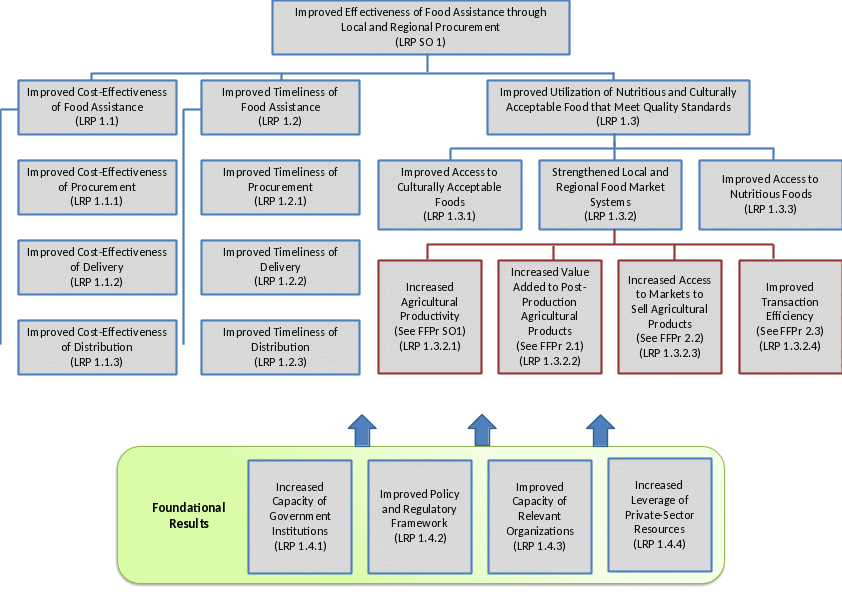
A Note on Foundational Results: These results can feed into one or more higher-level results. Causal relationships sometimes exist between foundational results.
APPENDIX E – Local and Regional Procurement Standard Indicator
LRP INDICATOR 1: Number of individuals directly benefiting from USDA-funded interventions |
|||||
DEFINITION: This is an output indicator measuring the number of individuals directly participating in USDA‐funded interventions. The individuals must be engaged with a project activity or come into direct contact with a set of interventions (goods or services) provided by the project. This may include, for example, farmers and others receiving training, inputs, or students benefiting from food procured and school meals provided by the project.
Individuals merely contacted or involved in an activity through brief attendance (non‐recurring participation) does not count under this indicator.
This indicator only tracks direct beneficiaries reached with direct USDA assistance (funded in part or in whole by USDA). Individuals should not be double counted. Individuals may receive multiple interventions in one fiscal year but should only be counted upon first receipt of project interventions. For example, if one individual participates in multiple USDA-sponsored training courses or benefits from multiples meals provided in a given fiscal year, they will only be counted one time in that fiscal year. Individuals participating in USDA-sponsored training courses or receiving meals in multiple fiscal years may be counted once in each fiscal year. |
|||||
RATIONALE: Tracks access to services and beneficiaries directly linked to the project activities. |
|||||
INDICATOR CHARACTERISTICS |
|||||
UNIT OF MEASURE: Number: Individuals |
INDICATOR LEVEL: Output |
DIRECTION OF CHANGE: Higher is better |
FREQUENCY OF REPORTING: Biannually covering the periods: October 1 – March 31 and April 1 – September 30 |
||
DISAGGREGATION: Gender: Male/Female (required) New/Continuing (required):
|
|||||
DATA SOURCE: WHO COLLECTS DATA FOR THIS INDICATOR: Data will be collected by Program Participants.
HOW SHOULD IT BE COLLECTED: Data will be collected from program participant beneficiary tracking records and reports. |
|||||
MEASUREMENT NOTES: This indicator provides a unique count of total project beneficiaries. Only direct beneficiaries should be counted. Indirect beneficiaries should not be counted under this indicator. Indirect beneficiaries should be counted in LRP Indicator 2. Individual beneficiaries should come into direct contact or receipt of an intervention or set of interventions. |
|||||
DATA ENTRY IN FAIS: The indicator title must be entered into the relevant performance reporting section of FAIS VERBATIM to allow for the information to be collected correctly.
Indicator-specific disaggregation guidance: Enter the indicator in FAIS for each required/applicable disaggregation. In this case male, female, new, and continuing. Identify in parentheses the disaggregation at the end of the indicator title. For example:
|
|||||
RELATIONSHIP TO THE FEED THE FUTURE (FtF) and FOOD FOR PEACE INDICATORS |
|||||
FtF or FFP INDICATOR: No |
FtF WHOLE OF GOVERNMENT INDICATOR: n/a
|
DEFINITIONAL AND MEASUREMENT NOTES: Food for Peace and Feed the Future define an indirect beneficiary similar to the USDA definition of direct beneficiary. FFP and FtF, note “An individual is a direct beneficiary if s/he comes into direct contact with the set of interventions (goods or services) provided by the project. The intervention needs to be significant, meaning that if the individual is merely contacted or touched by a project through brief attendance at a meeting or gathering, s/he should not be counted as beneficiary. Individuals who receive training or benefit from project-supported technical assistance or service provision are considered direct beneficiaries, as are those who receive a ration or another type of good.” |
|||
LRP INDICATOR 2: Number of individuals benefiting indirectly from USDA-funded interventions |
|||||
DEFINITION: This is an output indicator measuring the number of individuals indirectly benefitting from USDA-funded interventions. The individuals will not be directly engaged with a project activity or come into direct contact with a set of interventions (goods or services) provided by the project. This may include for example family members of farmers trained.
Individuals should not be double counted. Individuals may benefit from multiple interventions in one fiscal year but should only be counted once per fiscal year. If an individual is already counted as a direct beneficiary, the individual should not also be counted as an indirect beneficiary if they are indirectly benefitting from other project interventions. For example, if a farmer is counted as a direct beneficiary after directly participating in a training course, the farmer should not also be counted as an indirect beneficiary if another family member participates in a different training course. |
|||||
RATIONALE: Tracks indirect impact of project on community or area of intervention. |
|||||
INDICATOR CHARACTERISTICS |
|||||
UNIT OF MEASURE: Number: Individuals |
INDICATOR LEVEL: Output |
DIRECTION OF CHANGE: Higher is better |
FREQUENCY OF REPORTING: Biannually covering the periods: October 1 – March 31 and April 1 – September 30 |
||
DISAGGREGATION:
|
|||||
DATA SOURCE: WHO COLLECTS DATA FOR THIS INDICATOR: Data will be collected by Program Participants.
HOW SHOULD IT BE COLLECTED: Data will be collected from program participant beneficiary tracking records and reports. |
|||||
MEASUREMENT NOTES: Only indirect beneficiaries should be counted under this indicator. Individual beneficiaries should not come into direct contact or receipt of an intervention or set of interventions, but should indirectly benefit from one or more of the project’s interventions. |
|||||
DATA ENTRY IN FAIS: The indicator title must be entered into the relevant performance reporting section of FAIS VERBATIM to allow for the information to be collected correctly.
Indicator-specific disaggregation guidance: None |
|||||
RELATIONSHIP TO THE FEED THE FUTURE (FtF) and FOOD FOR PEACE INDICATORS |
|||||
FtF or FFP INDICATOR: No |
FtF WHOLE OF GOVERNMENT INDICATOR: n/a
|
DEFINITIONAL AND MEASUREMENT NOTES: Food for Peace and Feed the Future define an indirect beneficiary similar to USDA definition of indirect beneficiary. FFP and FtF, note “An indirect beneficiary, on the other hand, does not necessarily have direct contact with the project but still benefits, such as the population who uses a new road constructed by the project or the individuals who hear a radio message but don’t receive any other training or counseling from the project.” |
|||
LRP INDICATOR 3: Value of sales by project beneficiaries |
|||||
DEFINITION: This indicator will collect the value (in US dollars) of sales of commodities by all project beneficiaries procured through USDA LRP program. This includes all sales by direct project beneficiaries of commodity(ies), not just farm-gate sales.
The actual number reported for the indicator will be the value of sales of a product (crop, animal or fish) by direct project beneficiaries in the reporting period. Only count sales in the reporting period attributable to USDA purchases or investment.
USDA will use the data reported for this indicator to calculate the value of incremental sales for reporting to the Feed the Future Initiative. The value of incremental sales indicates the value (in USD) of the total amount of agricultural products sold by targeted beneficiaries relative to a base year and is calculated as the total value of sales of a product (crop, animal or fish) during the reporting year minus the total value of sales in the base year. Please note that the value of incremental sales indicator cannot be calculated without a value for baseline year’s sales. If data on the total value of sales of the value chain commodity by direct beneficiaries prior to USDA activity implementation is not available, do not leave the baseline blank or enter ‘0.’ Use the earliest reporting year sales actual as the baseline year sales. This will result in some underestimation of the total value of incremental sales achieved by the USDA project, but this is preferable to being unable to calculate incremental sales at all.
If a direct beneficiary sample is used to collect sales data, sample survey estimates must be extrapolated to total beneficiary estimated values to accurately reflect total sales by the activity’s direct beneficiaries. |
|||||
RATIONALE: Value (in US dollars) of sales at the farm and enterprise level of commodities is a measure of the competitiveness of those beneficiaries receiving USDA assistance. This measurement also helps track access to markets and progress toward commercialization by farmers and enterprises receiving USDA assistance. |
|||||
INDICATOR CHARACTERISTICS |
|||||
UNIT OF MEASURE: U.S. Dollar |
INDICATOR LEVEL: Outcome |
DIRECTION OF CHANGE: Higher is better |
FREQUENCY OF REPORTING: Biannually covering the periods: October 1 – March 31 and April 1 – September 30 |
||
DISAGGREGATION: Commodity Type
|
|||||
DATA SOURCE: WHO COLLECTS DATA FOR THIS INDICATOR: Data will be collected by Program Participants.
HOW SHOULD IT BE COLLECTED: Data will be collected by project records, firm/farm records. |
|||||
MEASUREMENT NOTES: Collect data only at the project-level, attributed to USDA assistance. Data should only be collected from direct project beneficiaries. These beneficiaries should be reported in Indicator 1.
Convert local currency to USD at the average market foreign exchange rate for the reporting period. Report exchange rate in comments report submission.
Note that the volume (in metric tons) of sales will be reported in indicator 4. There should be a correlation between the value of sales reported for this indicator and the volume (in metric tons) of sales reported in indicator 4. |
|||||
DATA ENTRY IN FAIS: The indicator title must be entered into the relevant performance reporting section of FAIS VERBATIM to allow for the information to be collected correctly.
Indicator-specific disaggregation guidance: Enter the indicator in FAIS for each required/applicable disaggregation. In this case commodity type. Identify in parentheses the disaggregation at the end of the indicator title.
Repeat as necessary |
|||||
RELATIONSHIP TO THE FEED THE FUTURE (FtF) and FOOD FOR PEACE INDICATORS |
|||||
FtF or FFP INDICATOR: Yes [FtF 4.5.2-23 and FFP 16] |
FtF WHOLE OF GOVERNMENT INDICATOR: Yes
|
DEFINITIONAL AND MEASUREMENT NOTES: FtF collects this data at the farm level based on purchases from smallholder farmers while LRP will collect this data at all levels (farm and enterprise-level) based on value of sales by all targeted beneficiaries.
As this is an FtF Whole of Government indicator, FtF has produced additional guidance on the measurement of this indicator. Please refer to this guidance for additional information: Feed the Future Agricultural Indicators Guide (http://agrilinks.org/library/feed-the-future-ag-indicators-guide). |
|||
LRP INDICATOR 4: Volume of commodities (metric tons) sold by project beneficiaries |
|||||
DEFINITION: This indicator will collect the volume (as calculated in gross metric tons (MT)) of sales of commodities by project beneficiaries procured through USDA LRP program. This includes the volume of all sales of commodity(ies), not just the volume of farm-gate sales.
The actual number reported for the indicator will be the gross volume of sales of a product (crop, animal or fish) by direct project beneficiaries in the reporting period. Only count the gross volume of sales in the reporting period attributable to USDA purchases or investment.
USDA will use the data reported for this indicator, as well as the data reported on the value of incremental sales, when reporting on the Feed the Future Initiative. Please note that the value of incremental sales indicator cannot be calculated without a value for the baseline year’s sales. If data on the total volume of sales of the value chain commodity by direct beneficiaries prior to USDA activity implementation is not available, do not leave the baseline blank or enter ‘0.’ Use the earliest reporting year sales volume actual as the baseline year sales.
If a direct beneficiary sample is used to collect sales data, sample survey estimates must be extrapolated to total beneficiary estimated values before entry into FAIS to accurately reflect total sales by the activity’s direct beneficiaries. |
|||||
RATIONALE: Volume (in MT) of sales at the farm and enterprise level of commodities is a measure of the competitiveness of those beneficiaries receiving USDA assistance. This measurement also helps track supply, access to markets and progress toward commercialization by farmers and enterprises receiving USDA assistance. |
|||||
INDICATOR CHARACTERISTICS |
|||||
UNIT OF MEASURE: Metric Tons |
INDICATOR LEVEL: Outcome |
DIRECTION OF CHANGE: Higher is better |
FREQUENCY OF REPORTING: Biannually covering the periods: October 1 – March 31 and April 1 – September 30 |
||
DISAGGREGATION: Commodity Type
|
|||||
DATA SOURCE: WHO COLLECTS DATA FOR THIS INDICATOR: Data will be collected by Program Participants.
HOW SHOULD IT BE COLLECTED: Data will be collected by project records, firm/farm records. |
|||||
MEASUREMENT NOTES: Collect data only at the project-level, attributed to USDA assistance. Data should only be collected from direct project beneficiaries. These beneficiaries should be reported in Indicator 1.
Volume (in metric tons) of purchases should be directly related to value of sales measured in Indicator 3. Volume of purchases reported at baseline and for the reporting years should be the volume that was sold and reported as sales in Indicator 3. |
|||||
DATA ENTRY IN FAIS: The indicator title must be entered into the relevant performance reporting section of FAIS VERBATIM to allow for the information to be collected correctly.
Indicator-specific disaggregation guidance: Enter the indicator in FAIS for each required/applicable disaggregation. In this case commodity type. Identify in parentheses the disaggregation at the end of the indicator title. For example:
Repeat as necessary |
|||||
RELATIONSHIP TO THE FEED THE FUTURE (FtF) and FOOD FOR PEACE INDICATORS |
|||||
FtF and FFP INDICATOR: Yes [FtF 4.5.2-23 and FFP 16] |
FtF WHOLE OF GOVERNMENT INDICATOR: Yes
|
DEFINITIONAL AND MEASUREMENT NOTES: FtF and FFP collect this information as part of the Value of Incremental Sales indicator. In order to capture this data in USDA’s database system, a separate indicator on volume has been developed. |
|||
LRP INDICATOR 5: Number of public-private partnerships formed as a result of USDA assistance |
|||||
DEFINITION: The number of public-private partnerships in agriculture or nutrition formed during the reporting year due to USDA intervention (i.e. agricultural or nutrition activity, as described below.) Private partnerships can be long or short in duration (length is not a criteria for measurement.) Partnerships with multiple partners should only be counted once. A public-private alliance (partnership) is considered formed when there is a clear agreement, usually written, to work together to achieve a common objective. There must be either a cash or in-kind significant contribution to the effort by both the public and private entity. A private entity can be a for-profit entity, an NGO using private funds, a private company, a community group, or a state-owned enterprise which seeks to make a profit (even if unsuccessfully). A public entity can be a donor-funded program participant, a national or sub-national government, or state-owned enterprises which are non-profit.
A project may form more than one partnership with the same entity, but this is likely to be rare. In counting partnerships, we are not counting transactions with a partner entity; we are counting the number of partnerships formed during the reporting year. Public-private partnerships counted should be only those formed during the current reporting year. Any partnership that was formed in a previous year should not be included.
An agricultural activity is any activity related to the supply of agricultural inputs, production methods, agricultural processing or transportation. A nutritional activity includes any activity focused on attempting to improve the nutritional content of agricultural products as provided to consumers, develop improved nutritional products, increase support for nutrition service delivery, etc.
Formal partnerships between schools and producers, cooperatives or other private sector entities for the purpose of sustainably support school meals programs should be counted as a nutrition focused partnership. |
|||||
RATIONALE: The assumption of this indicator is that if more partnerships are formed it is likely that there will be more investment in agriculture or nutrition-related activities, which ultimately contributes to agriculture sector growth. The improvement in growth will increase the incomes of all, but because the focus of project work is on the vulnerable (women, children and the poor) there will also be a reduction in poverty. |
|||||
INDICATOR CHARACTERISTICS |
|||||
UNIT OF MEASURE: Number: Partnerships |
INDICATOR LEVEL: Output |
DIRECTION OF CHANGE: Higher is better |
FREQUENCY OF REPORTING: Biannually covering the periods: October 1 – March 31 and April 1 – September 30 |
||
DISAGGREGATION: Type of partnership (refer to the primary focus of the partnership if applicable):
|
|||||
DATA SOURCE: WHO WILL COLLECTS DATA FOR THIS INDICATOR: Data will be collected by Program Participants.
HOW SHOULD IT BE COLLECTED: Data will be collected at the project-level, through project records of activities and capacity building carried out by the project, observation and analysis of the host government legal status of the various policies being addressed. Policies, legislation, regulations should be submitted to USDA and attached in project reports. |
|||||
MEASUREMENT NOTES: Only count partnerships that are attributable to USDA investment.
Each partnership’s formation should only ever be reported once in order to add the total number of partnerships across years. |
|||||
DATA ENTRY IN FAIS: The indicator title must be entered into the relevant performance reporting section of FAIS VERBATIM to allow for the information to be collected correctly.
Indicator-specific disaggregation guidance: Enter the indicator in FAIS for each required/applicable disaggregation. In this case partnership type. Identify in parentheses the disaggregation at the end of the indicator title. For example:
|
|||||
RELATIONSHIP TO THE FEED THE FUTURE (FtF) and FOOD FOR PEACE INDICATORS |
|||||
FtF or FFP INDICATOR: Yes [FtF 4.5.2-12] |
FtF WHOLE OF GOVERNMENT INDICATOR: No |
DEFINITIONAL AND MEASUREMENT NOTES: None |
|||
LRP INDICATOR 6: Value of public and private sector investments leveraged as a result of USDA assistance |
|||||
DEFINITION: Investment is defined as any use of public or private sector resources intended to increase future production output or income, to improve the sustainable use of agricultural-related natural resources (soil, water, etc.), to improve water or land management, or anywhere along the food, feed and fiber system and natural resources management.
“Private sector” includes any investment from a private actor, including for example for-profit companies, corporate investment banks, etc. “Public sector” includes any investments provided by public actors, for example, other donor agencies including USG (i.e. MCC, USAID, OPIC), local or national host-country government.
“Leveraged as a result of USDA assistance” indicates that the new investment was directly encouraged or facilitated by the activities funded or resources provided by USDA. New investment means investment made during the reporting year. |
|||||
RATIONALE: Increased investment is essential to inclusive economic growth in the agricultural sector. Public and private sector investment is key to achieving long-term impact in improvements in food security, agricultural sustainability and expanded trade. Public and private sector investments should be coordinated and complimentary. Private sector investment is critical because it indicates that the investment is perceived by private agents as providing a positive financial return and therefore is likely to lead to sustainable increases in agricultural production and expanded trade. Public sector investments can be used to pilot programs, test innovation, and scale-up effective programs. |
|||||
INDICATOR CHARACTERISTICS |
|||||
UNIT OF MEASURE: U.S. Dollar |
INDICATOR LEVEL: Output |
DIRECTION OF CHANGE: Higher is better |
FREQUENCY OF REPORTING: Biannually covering the periods: October 1 – March 31 and April 1 – September 30 |
||
DISAGGREGATION: Type of partnership (refer to the primary focus of the partnership if applicable):
|
|||||
DATA SOURCE: WHO COLLECTS DATA FOR THIS INDICATOR: Data will be collected by Program Participants.
HOW SHOULD IT BE COLLECTED: Data will be collected by project records. |
|||||
MEASUREMENT NOTES: Convert local currency to US dollars at the average market foreign exchange rate for the reporting period. Report exchange rate in indicator narrative in FAIS. |
|||||
DATA ENTRY IN FAIS: The indicator title must be entered into the relevant performance reporting section of FAIS VERBATIM to allow for the information to be collected correctly.
Indicator-specific disaggregation guidance: Enter the indicator in FAIS for each required/applicable disaggregation. In this case public and private. Identify in parentheses the disaggregation at the end of the indicator title. For example:
|
|||||
RELATIONSHIP TO THE FEED THE FUTURE (FtF) and FOOD FOR PEACE INDICATORS |
|||||
FtF and FFP INDICATOR: Yes [FtF 4.5.2-38] |
FtF WHOLE OF GOVERNMENT INDICATOR: No
|
DEFINITIONAL AND MEASUREMENT NOTES: USDA measures public and private sector investments whereas FtF only measures private sector investments. |
|||
LRP INDICATOR 8: Number of policies, regulations and/or administrative procedures in each of the following stages of development as a result of USDA assistance |
|||||
DEFINITION: Number of enabling environment policies/regulations/administrative procedures in the areas of agricultural resource, food, market standards & regulation, public investment, education, nutrition, natural resource or water management and climate change adaptation/mitigation as it related to agriculture that:
|
|||||
RATIONALE: This indicator measures the number of policies/regulations/administrative procedures in the various stages of progress towards an enhanced enabling environment for agriculture whose sub-elements are specific policy sectors. It includes the development, implementation and enforcement of policies and regulations that support the achievement of one or more results in the LRP framework focused on improving the utilization of nutritious and culturally acceptable foods. |
|||||
INDICATOR CHARACTERISTICS |
|||||
UNIT OF MEASURE: Number: policies, regulations, and/or administrative procedures and supplementary narrative |
INDICATOR LEVEL: Stages 1 & 2: Output Stages 3, 4 & 5: Outcome |
DIRECTION OF CHANGE: Although this set of five indicators tracks individual policies through the stages, one should see the aggregates of these indicators, over time, change in certain ways. One should expect the value of the indicators measuring the earlier stages to decline and the indicators measuring the later stages of progress to increase as the enabling environment is strengthened (i.e. move from analysis to adoption and implementation of reforms) |
FREQUENCY OF REPORTING: Biannually covering the periods: October 1-March 31 and April 1-September 30 |
||
DISAGGREGATION: Stage: (1-5) |
|||||
DATA SOURCE: WHO COLLECTS DATA FOR THIS INDICATOR: Data will be collected by Program Participants.
HOW SHOULD IT BE COLLECTED: Data will be collected at the project-level, through project records of activities and capacity building carried out by the project, observation and analysis of the host government legal status of the various policies being addressed. Policies, legislation, regulations should be submitted to USDA and attached in biannual project reports. |
|||||
MEASUREMENT NOTES: Only count policies specifically addressed with USDA assistance.
This indicator tracks the policy, regulation, or administrative procedure. Multiple project participants working in the same country or region (with regard to regional policies) may report the same policy, regulation, or administrative procedure as long as the program participant participated in the process and provided assistance to the development, drafting, formation of the law or policy. |
|||||
RELATIONSHIP TO THE FEED THE FUTURE (FtF) and FOOD FOR PEACE INDICATORS |
|||||
FtF or FFP INDICATOR: Yes [FtF 4.5.1-24] |
FtF WHOLE OF GOVERNMENT INDICATOR: No
|
DEFINITIONAL AND MEASURMENT NOTES: Feed the Future focuses only on policies, regulations, and administrative requirements that focus on agriculture and nutrition, whereas the LRP indicator includes education policies, regulations, and administrative requirements given the program’s significant linkages to school feeding. |
|||
LRP INDICATOR 9: Quantity of commodity procured (MT) as a result of USDA assistance (by commodity and source country) |
|||||
DEFINITION: This indicator will collect the quantity of commodities procured (in metric tons (MT) through USDA local and regional procurement program. This includes the quantity of all procured commodity(ies) as a result of USDA investment during the reporting period. |
|||||
RATIONALE: Quantity (in MT) of procured commodities at the local and regional level indicates the amount of food provided to direct beneficiaries and is an indication of the availability of local foods for those beneficiaries receiving USDA assistance. |
|||||
INDICATOR CHARACTERISTICS |
|||||
UNIT OF MEASURE: Metric Tons |
INDICATOR LEVEL: Output |
DIRECTION OF CHANGE: Higher is better |
FREQUENCY OF REPORTING: Biannually covering the periods: October 1-March 31 and April 1-September 30 |
||
DISAGGREGATION: Source Country: Country where the commodity was procured. Commodity Type: Commodity procured. |
|||||
DATA SOURCE: WHO COLLECTS DATA FOR THIS INDICATOR: Data will be collected by Program Participants.
HOW SHOULD IT BE COLLECTED: Data will be collected by project procurement records. |
|||||
MEASUREMENT NOTES: Collect data only at the project-level, attributed to USDA assistance. There should be a direct link between quantity of commodities procured and the number of direct beneficiaries. Direct beneficiaries should include those beneficiaries receiving commodities through take-home rations, school meals or snacks, or direct distribution as a result of emergency assistance. These beneficiaries should be reported in Indicator 1.
Quantity (in metric tons) of procured commodities should also be directly related to value of procurements measured in Indicator 10. |
|||||
DATA ENTRY IN FAIS: The indicator title must be entered into the relevant performance reporting section of FAIS VERBATIM to allow for the information to be collected correctly.
Indicator-specific disaggregation guidance: Enter the indicator in FAIS for each required/applicable disaggregation. In this case commodity type and source country. Identify in parentheses the disaggregation at the end of the indicator title. For example:
Quantity of commodity procured (MT) as a result of USDA assistance (Black Beans, Guatemala) Quantity of commodity procured (MT) as a result of USDA assistance (Black Beans, Honduras) Quantity of commodity procured (MT) as a result of USDA assistance (Fortified Rice, Honduras)
Repeat as necessary. |
|||||
RELATIONSHIP TO THE FEED THE FUTURE (FtF) and FOOD FOR PEACE INDICATORS |
|||||
FtF or FFP INDICATOR: FFP LRP Actuals] |
FtF WHOLE OF GOVERNMENT INDICATOR: n/a
|
DEFINITIONAL AND MEASURMENT NOTES: FFP requires reporting on Local and Regional Procurement activities through the Food for Peace Management Information System (FFPMIS) on a quarterly basis. |
|||
LRP INDICATOR 10: Cost of commodity procured as a result of USDA assistance (by commodity and source country) |
|||||
DEFINITION: This indicator will collect the cost (in US dollars) of procured commodities by commodity type and source country.
The costs reported for the indicator is the actual cost of the procured commodities during the reporting period. Costs of procured commodities excludes all freight costs. Freight costs (ocean, inland, and internal) reported in indicator 12. |
|||||
RATIONALE: Value (in US dollars) of procured commodities is a measure of the LRP program’s impacts on the local or regional market the country or region receiving USDA assistance. This measurement also helps track access to markets and availability of commodities in the beneficiary areas. |
|||||
INDICATOR CHARACTERISTICS |
|||||
UNIT OF MEASURE: US Dollars |
INDICATOR LEVEL: Output |
DIRECTION OF CHANGE: Lower is better |
FREQUENCY OF REPORTING: Biannually covering the periods: October 1-March 31 and April 1-September 30 |
||
DISAGGREGATION: Source Country: Country where the commodity was procured. Commodity Type: Commodity procured. |
|||||
DATA SOURCE: WHO COLLECTS DATA FOR THIS INDICATOR: Data will be collected by Program Participants.
HOW SHOULD IT BE COLLECTED: Data will be collected by project records, firm/farm records. |
|||||
MEASUREMENT NOTES: Collect data only at the project-level, attributed to USDA assistance. There should be a direct link between cost of commodities procured and the number of direct beneficiaries. Direct beneficiaries should include those beneficiaries receiving commodities through take-home rations, school meals or snacks, or direct distribution as a result of emergency assistance. Data should only be collected from direct project beneficiaries. These beneficiaries should be reported in Indicator 1.
Convert local currency to USD at the average market foreign exchange rate for the reporting period. Report exchange rate in comments in FAIS.
Note that the quantity (in metric tons) of commodities procured will be reported in Indicator 9. There should be a direct link between the cost of procured commodities reported for this Indicator and the volume (in metric tons) of purchases reported in Indicator 9. Data for indicators 9 and 10 must be reported so that USDA can calculate the cost per metric ton of commodities procured. |
|||||
DATA ENTRY IN FAIS: The indicator title must be entered into the relevant performance reporting section of FAIS VERBATIM to allow for the information to be collected correctly.
Indicator-specific disaggregation guidance: Enter the indicator in FAIS for each required/applicable disaggregation. In this case commodity type and source country. Identify in parentheses the disaggregation at the end of the indicator title. For example:
Cost of commodity procured as a result of USDA assistance (Black Beans, Guatemala) Cost of commodity procured as a result of USDA assistance (Black Beans, Honduras) Cost of commodity procured as a result of USDA assistance (Fortified Rice, Honduras)
Repeat as necessary. |
|||||
RELATIONSHIP TO THE FEED THE FUTURE (FtF) and FOOD FOR PEACE INDICATORS |
|||||
FtF or FFP INDICATOR: Yes [FFP LRP Actuals] |
FtF WHOLE OF GOVERNMENT INDICATOR: n/a
|
DEFINITIONAL AND MEASURMENT NOTES: FFP requires reporting on Local and Regional Procurement activities through the Food for Peace Management Information System (FFPMIS) on a quarterly basis. |
|||
LRP INDICATOR 11: Number of people trained in disaster preparedness as a result of USDA assistance |
|||||
DEFINITION: Disaster preparedness includes: risk identification, analysis, prioritization, and reduction activities; the design and implementation of regional, national, local, or community level hazard reduction policies and plans; early warning systems, as appropriate; and identification of roles and responsibilities in preventing, responding to, and recovering from disasters and subsequent food crises.
Training refers to new training or retraining of individuals and assumes that training is conducted according to national or international standards, when these exist. Trainings must have specific learning objectives, a course outline or curriculum, and expected knowledge, skills and/or competencies to be gained by participants. Only participants who complete a full training course should be counted. If a training course covers more than one topic, individuals should only be counted once for that training course. If a training course is conducted in more than one session/training event, only individuals who complete the full course should be counted; do not sum the participants for each training event. If individuals are retrained within the reporting period, having received training prior to the project or reporting period, they should be included in the count. Do not count sensitization meetings or one-off information meetings.
Individuals include agricultural producers, processers, national or local government employees, policy makers, researchers, school administrators, teachers, other school workers, community leaders, parents, health professionals, students, NGO staff, and others who are engaged in the food, nutrition, education, emergency response, and natural resources management.
In-country and offshore training are included. Delivery mechanisms can include a variety of extension methods as well as technical assistance activities.
Disaster means an event or a series of events that creates a need for emergency food assistance by threatening or resulting in significantly decreased availability of, or access to, food or the erosion of the ability of populations to meet food needs. Disasters include, but are not limited to, natural events such as floods, earthquakes, and drought; crop failure; disease; civil strife and war; and economic turmoil. Disasters can be characterized as slow or rapid-onset. The situation caused by a disaster is a “food crisis”.
Emergency response means any activity that is designed to meet the urgent food and nutritional needs of those affected by acute or transitory food insecurity as a result of a disaster. |
|||||
RATIONALE: Enhanced human capacity for planning for and responding to disasters and food crises, is expected to lead to improved national and food security, increased efficiency and effectiveness of disaster preparedness and emergency response, program and policy formulation and/or implementation, and is key to transformational development. |
|||||
INDICATOR CHARACTERISTICS |
|||||
UNIT OF MEASURE: Number: Individuals |
INDICATOR LEVEL: Output |
DIRECTION OF CHANGE: Higher is better |
FREQUENCY OF REPORTING: Biannually covering the periods: October 1-March 31 and April 1-September 30 |
||
DISAGGREGATION: Gender: Male/Female (required) |
|||||
DATA SOURCE: WHO COLLECTS DATA FOR THIS INDICATOR: Data will be collected by Program Participants.
HOW SHOULD IT BE COLLECTED: Data will be collected from program participant training records, reports, or surveys. Program participants should keep detailed training lists for all training sessions. |
|||||
MEASUREMENT NOTES: This indicator is required only if the project is designed to provide an emergency response to food crises and disasters.
Count only those individuals targeted by USDA programs.
Individuals should not be double counted in a given fiscal year. For example, if one individual participates in multiple project-sponsored training courses in a given fiscal year, they should only be counted one time in that fiscal year. Individuals participating in project-sponsored training courses in multiple fiscal years may be counted once in each fiscal year. |
|||||
DATA ENTRY IN FAIS: The indicator title must be entered into the relevant performance reporting section of FAIS VERBATIM to allow for the information to be collected correctly.
Enter the indicator in FAIS for each required/applicable disaggregation. In this case, male and female. Identify in parentheses the disaggregation at the end of the indicator title. For example:
|
|||||
RELATIONSHIP TO THE FEED THE FUTURE (FtF) and FOOD FOR PEACE INDICATORS |
|||||
FtF or FFP INDICATOR: Yes [FFP 31] |
FtF WHOLE OF GOVERNMENT INDICATOR: n/a |
DEFINITIONAL AND MEASURMENT NOTES: This is also a Foreign Assistance indicator 5.2.1-2 (see: http://www.state.gov/f/indicators/) |
|||
LRP INDICATOR 12: Cost of transport, storage and handling of commodity procured as a result of USDA assistance (by commodity) |
|||
DEFINITION: This indicator will collect the cost (in US dollars) of transport, storage and handling for procured commodities by commodity type.
Costs should reflect all necessary costs for procured commodities. Cost should include storage, warehousing and commodity distribution costs; internal transport via rail, truck or barge transportation; commodity monitoring in storage and at distribution sites; vehicle procurement; in-country operational costs, and others, for the duration of a program. Cost should also include commodity quality and safety testing. |
|||
RATIONALE: Cost of transport, storage and handling of commodities procured provides key information in the estimation of total LRP costs (combined with commodity costs) and is a measure of the LRP program’s impacts on the local or regional transport markets in the country or region receiving USDA assistance. This measurement also helps track access and barriers to markets as it relates to the availability of commodities in the beneficiary areas. |
|||
INDICATOR CHARACTERISTICS |
|||
UNIT OF MEASURE: US Dollars |
INDICATOR LEVEL: Output |
DIRECTION OF CHANGE: Lower is better |
FREQUENCY OF REPORTING: Biannually covering the periods: October 1-March 31 and April 1-September 30 |
DISAGGREGATION: Commodity Type: Commodity procured. |
|||
DATA SOURCE: WHO COLLECTS DATA FOR THIS INDICATOR: Data will be collected by Program Participants.
HOW SHOULD IT BE COLLECTED: Data will be collected by project records, firm/farm records. |
|||
MEASUREMENT NOTES: Collect data only at the project-level, attributed to USDA assistance.
Convert local currency to USD at the average market foreign exchange rate for the reporting period. Report exchange rate in comments in FAIS.
Note that the quantity (in metric tons) of commodities procured will be reported in Indicator 9. There should be a direct link between the cost of freight of commodities procured reported for this indicator and the volume (in metric tons) of reported in Indicator 9. Data for indicators 9 and 12 must be reported so that USDA can calculate the freight cost per metric ton of commodities procured.
There are must be a direct link between the cost of the procured commodities in indicator 10 and costs of transport, storage and handling of commodities procured. The sum of indicators 10 and 12 should be the total cost associated with the procurement, transport and delivery of commodities. |
|||
DATA ENTRY IN FAIS: The indicator title must be entered into the relevant performance reporting section of FAIS VERBATIM to allow for the information to be collected correctly.
Indicator-specific disaggregation guidance: Enter the indicator in FAIS for each required/applicable disaggregation. In this case commodity type. Identify in parentheses the disaggregation at the end of the indicator title. For example:
Repeat as necessary.
|
|||
LRP INDICATOR 13: Number of social assistance beneficiaries participating in productive safety nets as a result of USDA assistance |
|||||
DEFINITION: The number of people participating in USDA-supported social assistance programming with productive components aimed at increasing community assets, household assets, or strengthening human capital.
Productive safety nets are programs that protect and strengthen food insecure households’ physical and human capital by providing regular resource transfers in exchange for time or labor. School feeding programs build human capital as it is used to encourage children’s attendance in school and help them benefit from the instruction received. School meals and especially take-home rations provided are the resources transferred to assist children in attending school and may offset the opportunity costs to households that may for example rely on their children’s income from work. Generally there are three kinds of activities that can provide the foundation of a “productive safety net” program. These are:
What sets productive safety nets apart from other social assistance programs is that the assistance—a predictable resource transfer—is provided in exchange for labor or to offset the opportunity cost of an investment of time. For this reason they are sometimes referred to as “conditional” safety net programs. Another difference is an expectation that, over time, individuals or households enrolled in a productive safety net program will “graduate” from that program. |
|||||
RATIONALE: Provides information on USDA assistance aimed at increasing self-sufficiency in vulnerable populations. USDA local and regional procurement programs supporting school feeding programs will provide safety nets to social assistance beneficiaries. School feeding programs build human capital as it is used to encourage children’s attendance in school and help them benefit from the instruction received. School feeding programs as a social safety net provide an explicit or implicit transfer to households of the value of the food distributed. The value of the transfers varies from school snacks to large take-home rations. |
|||||
INDICATOR CHARACTERISTICS |
|||||
UNIT OF MEASURE: Number: Individuals |
INDICATOR LEVEL: Output |
DIRECTION OF CHANGE: Higher is better |
FREQUENCY OF REPORTING: Biannually covering the periods: October 1-March 31 and April 1-September 30 |
||
DISAGGREGATION: Gender: Male, Female (required) New/Continuing (required):
|
|||||
DATA SOURCE: WHO COLLECTS DATA FOR THIS INICATOR: Data will be collected by program participants.
HOW SHOULD IT BE COLLECTED: Data will be collected from program participant administrative records and reports. Program participants should keep detailed lists of all program participants. |
|||||
MEASUREMENT NOTES: The key to qualifying as a social assistance beneficiary under this indicator is the receipt of a cash or in-kind resource transfer. A conditional cash or in-kind transfer “provides poor households with cash, food, or other benefits on condition that they keep children in school, attend health clinics, or make other desired behavioral changes.” Therefore, students that received school meals and/or take-home rations should be counted as social assistance beneficiaries for this indicator. If the take-home ration size is calculated taking household requirement into account (i.e. with the objective of providing support to the family rather than the individual) then all family members should be counted as direct beneficiaries under this indicator. Teachers, cooks and other school administrators that receive school meals as a form of payment for their services should not be counted as a beneficiary under this indicator.
To avoid double counting, persons should not be counted multiple times in the aggregate total in one fiscal year. For example, if a beneficiary (student) receives a school meal and a take home ration, they should be counted once per fiscal year in the total beneficiaries. |
|||||
DATA ENTRY IN FAIS: The indicator title must be entered into the relevant performance reporting section of FAIS VERBATIM to allow for the information to be collected correctly.
Indicator-specific disaggregation guidance: Enter the indicator in FAIS for each required/applicable disaggregation. In this case male, female, new, and continuing. Identify in parentheses the disaggregation at the end of the indicator title. For example:
|
|||||
RELATIONSHIP TO THE FEED THE FUTURE (FtF) and FOOD FOR PEACE INDICATORS |
|||||
FtF or FFP INDICATOR: Yes [FtF 3.3.3-15 and FFP 33] |
FtF WHOLE OF GOVERNMENT INDICATOR: No |
DEFINITIONAL AND MEASURMENT NOTES: The definition for the indicator was revised to include relevant examples for local and regional procurement and school meals programs . For example, FtF does not list nutrition or school-feeding related examples of productive safety nets. |
|||
LRP INDICATOR 14: Number of individuals who have received short-term agricultural sector productivity or food security training as a result of USDA assistance |
|||||
DEFINITION: The number of individuals to whom significant knowledge or skills have been imparted through interactions that are intentional, structured, and purposed for imparting knowledge or skills should be counted as training, through formal or informal means.
There is no pre-defined minimum or maximum length of time for the training; what is key is that the training reflects a planned, structured curriculum designed to strengthen capacities, and there is a reasonable expectation that the training recipient will acquire new knowledge or skills that s/he could translate into action. Count an individual only once, regardless of the number of trainings received during the reporting year and whether the trainings covered different topics. Do not count sensitization meetings or one-off information meetings. Short-term includes all non-degree seeking training.
Individuals include agricultural producers, ranchers, fisheries, and other primary sector producers who receive training in a variety of best practices in productivity, post-harvest management, linking to markets, etc. It also includes rural entrepreneurs, processors, managers and traders receiving training in application of new technologies, business management, linking to markets, etc., and extension specialists, researchers, inspectors, government employees, policy makers, and others who are engaged in the food, feed and fiber system and natural resources management.
In-country and offshore training are included. Delivery mechanisms can include a variety of extension methods as well as technical assistance activities. |
|||||
RATIONALE: Enhanced human capacity for increased agriculture productivity, improved food security, policy formulation and/or implementation, is key to transformational development. |
|||||
INDICATOR CHARACTERISTICS |
|||||
UNIT OF MEASURE: Number: Individuals |
INDICATOR LEVEL: Output |
DIRECTION OF CHANGE: Higher is better |
FREQUENCY OF REPORTING: Biannually covering the periods: October 1-March 31 and April 1-September 30 |
||
DISAGGREGATION: Gender: Male/Female (required) New/Continuing (required):
Type of individual (if applicable):
Note: While private sector firms are considered part of civil society more broadly, only count them under the Private Sector Firms and not the Civil Society disaggregate to avoid double counting. |
|||||
DATA SOURCE: WHO COLLECTS DATA FOR THIS INDICATOR: Data will be collected by Program Participants.
HOW SHOULD IT BE COLLECTED: Data will be collected from program participant training records, reports, or surveys. Program participants should keep detailed training lists for all training sessions. |
|||||
MEASUREMENT NOTES: Count only those individuals targeted by USDA programs.
This indicator is a comprehensive indicator that includes all USDA supported training.
This indicator is to measure individuals receiving training, for which the outcome, individuals applying new practices should be reported under Indicator 2 (Number of individuals who have applied new techniques or technologies as a result of USDA assistance). Groups applying new technology or practices should be reported under Indicator 7 (Number of private enterprises, producer organizations, water users associations, women’s groups, trade and business associations and community-based organizations that applied new techniques and technology as a result of USDA assistance).
Individuals should not be double counted in a given fiscal year. For example, if one individual participates in multiple project-sponsored training courses in a given fiscal year, they should only be counted one time in that fiscal year. Individuals participating in project-sponsored training courses in multiple fiscal years may be counted once in each fiscal year. |
|||||
DATA ENTRY IN FAIS: The indicator title must be entered into the relevant performance reporting section of FAIS VERBATIM to allow for the information to be collected correctly.
Indicator-specific disaggregation guidance: Enter the indicator in FAIS for each required/applicable disaggregation. In this case male, female, new, continuing, and individual type. Identify in parentheses the disaggregation at the end of the indicator title. For example:
|
|||||
RELATIONSHIP TO THE FEED THE FUTURE (FtF) and FOOD FOR PEACE INDICATORS |
|||||
FtF or FFP INDICATOR: Yes [FtF 4.5.2-7 and FFP 11] |
FtF WHOLE OF GOVERNMENT INDICATOR: Yes |
DEFINITIONAL AND MEASURMENT NOTES: FtF frequency of reporting is annually. |
|||
APPENDIX F – Priority Country Guidance
Target Area(s): Cap Haitian, Port-au-Prince, and St. Marc
Country Context
Haiti is classified as a low-income country with total population of nearly 10 M (2014)ii. In 2013, the country had three percent GDP growth while 78 percent of the country survived on less than $2 a day and over 50 percent on less than $1 a day. Haiti’s gross national income is $1,720 with gross domestic product (GDP) at $18.54 billion (2014 est.). The unemployment rate in the formal sector is 41 percent. Almost two-thirds of Haitian households, or 4.7 million people, live in rural areas where agriculture is the main economic activity and source of income.iii In rural areas, 88 percent of individuals live below the poverty line and basic services are practically non-existent.
Among children under five years of age, nearly a quarter suffer from chronic undernutritioniv.To improve nutrition and food security, the government of Haiti (GoH) launched Aba Grangou, a national strategic framework to halve the proportion of people suffering from hunger by the end of 2016 and to eradicate hunger and malnutrition by 2025. According to a 2012 survey of households’ living conditions, enrollment in primary school is at 74 percent.
Haiti continues to recover from the massive earthquake in 2010, which intensified existing challenges and created massive reconstruction needs in one of the world’s poorest nations. Poverty and food insecurity have placed the highest burden on young children and women in terms of undernutrition and micronutrient deficiencies.v Nutrition outcomes are affected by health care system constraints, especially the shortages of health workers, lack of materials, and low skill levels. More than 80 percent of households have access to safe water and only 25 percent benefit from adequate sanitation.vi
As Haiti enter its third consecutive year of drought, intensified by the global El Nino weather phenomenon, food prices have risen, harvests have failed, the number of people considered “severely food insecure” has doubled, and acute shortages of water have negatively impacted ongoing relief efforts. The 2015 and 2016 spring harvests, which normally cover 60 percent of total agricultural production, have worsened conditions and caused the situation to be reclassified from “stress” to “crisis” levels.vii
Agricultural Context
Agriculture is central to the Haitian economy, with 60 percent of the Haitian population depending on it for their livelihood, and agriculture accounts for 25 percent of GDP, down from 40 percent in 1990.viii Although agriculture is an important sector of Haiti’s economy, the country fails to produce enough food and imports more than 50 percent for its population’s needs. It imports 80 percent of its main staple: rice. The agriculture sector is challenged by decades of underinvestment in infrastructure, poor natural resource management, limited governance, and the toll of natural disasters and environmental degradationix.
In recent years there has been a shift toward direct local and regional procurement of commodities from local farmers and farming cooperatives in an effort to rebuild the private sector in Haiti to spur long-term growth.x The main food crops grown for domestic consumption are maize, rice, sorghum, beans, peanuts, sweet potatoes, banana, plantains, avocados, pineapples, watermelons, almonds, coconut, okra, tomatoes, and breadfruit.xi
Beginning in 2013, the USAID-funded Kore Lavi, an agricultural safety net program, has worked to improve access to locally produced food among vulnerable households. This funding, approximately US $80 million running through FY 2017 has assisted 109,790 beneficiaries and 358 farmer groups and vendors. This program is focused on providing households with monthly voucher-based transfers to buy locally produced foods. Over 18,000 households have gained access to locally produced foods through electronic and paper vouchers.xii Additionally, the World Food Programme (WFP) has been involved in purchasing rice, corn, pulses (12,040 MT) from small Haitian producers in recent years as a part of its Home Grown School Feeding (HGSF) program. Concentrations of partners (Brazilian Corporation, International Development Bank, and European Union) have started a working group to provide technical and financial assistance to develop a coordinated plan around local and regional purchases for international donorsxiii. The French Development Agency (AFD) has partnered with the GoH since 2005 in the local procurement of rice and other commodities from local farmers in an attempt to stimulate local production.
Programming Priorities
The objectives of the USDA LRP program is to strengthen the ability of local and regional farmers, community farmer groups, farmer cooperatives and associations, processors, and agribusinesses to provide high-quality commodities in support of school feeding programs and responses to food crises and disasters; to increase capacity of organizations and governments to procure commodities in support of school feeding programs and responses to food crises and disasters; and to ensure the expedited provision of safe and quality foods to populations affected by food crises and disasters.
Agreements do not need to cover all targeted areas in Haiti, but need to provide a strong justification(s) for selecting a specific region(s). If agreements intend to use a specific locally grown commodity (i.e. peanuts) as a supplement to an existing McGovern Dole (MGD) ration please follow the solicitation guidance on how the program and/or ration will incorporate strategies to improve the nutritional status of children and families and improve access to diverse, nutritional and quality foods.
II. Lao People Democratic Republic (Laos)
Target Area(s): Savannakhet, (Outomphone, Atsaphone, Palanxay, Vilabouly, Phin, Xepon, Nong districts), Oudomxay, Luangnamtha, Saravane and Attapeu Provinces
Country Context
Lao People Democratic Republic’s (Laos) colonial past, and the legacy of protracted conflicts has the highest unexploded ordnance per capita in the world.xiv As a landlocked, least-developed and food-deficit country of 6.8 million people, it is one of the USDA-FAS test growing economies in Southeast Asia. In 1997, Laos became a member of Association of Southeast Asian Nations (ASEAN) and in 2013 the World Trade Organization (WTO).xv Increasing its integration into the regional and global economy, Laos will host ASEAN in September of 2016. Extreme poverty still exists in rural areas where chronic malnutrition persists, with up to 58 percent of children under five in the northern highlands stuntedxvi, and 27 percent severely underweight nationwidexvii.
Agricultural Context
Twenty four percent of Laos’ GDP is composed of the agriculture sector. The primary agricultural products include sweet potatoes, vegetables, corn, coffee, sugarcane, tobacco, cotton, tea, peanuts, rice; cassava (manioc), water buffalo, pigs, cattle, poultry.xviii The WFP in Laos indirectly strengthens the local food markets by focusing on areas where farmers produce a surplus, to enhance productivity and link farmers to markets.xix The Asian Development Bank (ADB) has provided support to the Lao Government and worked closely with other development partners to support improvement in procurement, project monitoring, and reporting and audit policies and practices through greater harmonization, alignment, and improvement of country systems.xx
Programming Priorities
The objectives of the USDA LRP program are to strengthen its food markets; to increase the capacity of the country’s public and private sectors to efficiently source and procure commodities in support of school feeding programs, and to respond to food crises and disasters; and to ensure that safe and quality foods are efficiently delivered to populations affected by food crises and disasters. Strong proposals should demonstrate how to improve agricultural linkages, procurement practices and systems, between local smallholder farmers and public and private food agricultural markets. USDA-FAS has two active MGD programs in Laos, thus linkages to these programs through the LRP program can set up a path for sustainability where the modalities for local procurement are strengthened and the Lao Government is able to expand their own School Meals program through capacity building provided by LRP.xxi
Mozambique
Target Area(s): Beira Corridor
Country Context
Mozambique has a population of 26 million with more than half the population living below the poverty line.xxii One-third of the population is chronically food-insecure, and 43percent of children five and under remain alarmingly malnourished. In recent years Mozambique was seeing steady economic progress; however 2016 has resulted in a sudden slowdown for economic growth. This is in part because Mozambique is in the midst of a debt crisis because a state owned company has defaulted on their loan payment. This has hit the currency hard and it has depreciated sharply.xxiii
Agricultural Context
Mozambique’s agriculture sector is characterized by roughly 80percent of the population engaged in farming and fishing and contributes to about half of Mozambique’s GDP. Of the cultivated land, roughly 80percent is used for cultivating staple crops for self-consumption. This includes cassava, corn, rice, sorghum, and pulses. However, due to low crop yields and limited market access, food availability remains low. Mozambique’s low agriculture productivity is in part due to the lack of appropriate technologies and support. The northern regions of Mozambique tend to see higher agriculture yields. The soil tends to be more fertile with more abundant rain fall. In the southern regions of Mozambique, the poor soil, limited rain, and proneness to natural disasters leave it a more vulnerable area for agriculture production.
Programming Priorities
The objectives of the USDA LRP program is to strengthen the ability of local and regional farmers, community farmer groups, farmer cooperatives and associations, processors, and agribusinesses to provide high-quality commodities in support of school feeding programs and responses to food crises and disasters; to increase capacity of organizations and governments to procure commodities in support of school feeding programs and responses to food crises and disasters; and to ensure the expedited provision of safe and quality foods to populations affected by food crises and disasters. USDA-FAS has two active MGD programs in Mozambique and combined, these two programs are serving more than 140,000 students with daily school meals. In addition, USDA-FAS also implements two FFPr programs focusing on the cashew and dairy value chain sector. These programs are agriculture development programs focused on expanding trade for agriculture products.
Applications do not need to cover all targeted areas in Mozambique, but need to provide a strong justification(s) for selecting a specific region(s). If Applicants intend to use a specific locally grown commodity as a supplement to an existing MGD ration please follow the solicitation guidance on how the project and/or ration will incorporate strategies to improve the nutritional status of children and families and improve access to diverse, nutritional, and quality food.
Rwanda
Target Area(s): Southern and Western provinces.
Country Context
Despite considerable progress since the tragedy of the genocide in 1994, poverty remains widespread, and 39.1percent of Rwandan households, live below poverty line. In its 2014 International Food Insecurity Assessment, USDA estimated that four million Rwandans, or a third of the population, were food insecure. Food insecurity in Rwanda is also a long-term problem that is contributed to by political instability in the Great Lakes region. In March 2007, Rwanda became the first country to sign the Comprehensive Africa Agriculture Development Program (CAADP), Africa Union’s food policy framework for agriculture transformation, wealth creation, food security and nutrition. Rural areas have the highest percentage of poor or extreme poor with the Southern and Western provinces having the highest rates of poverty in Rwanda.xxiv
Agricultural Overview
Agriculture represents 32.5percent of Rwanda’s $8 billion GDP and employs 90 percent of its labor force. However, these same figures also demonstrate that agricultural productivity is extremely low. Indeed, the labor force that makes its living from agriculture is classified as subsistence farmers, and over 60 percent falls below the poverty line. Since 2007, Rwanda’s annual agriculture sector growth has averaged over six percent in real terms, beating CAADP’s six percent growth target, and, for the first time since 1994, production during the second harvest of 2009 was estimated to be sufficient to cover the country’s aggregate food requirements.xxv Rwanda is also a focus country for the Feed the Future initiative. Export crops such as tea, coffee, and pyrethrum, as well as domestically important crops such as bananas, beans, maize, sorghum, potatoes, and livestock products, lead foreign currency and domestic agriculture earnings, respectively. However shortages of land and water, insufficient and poor-quality feed, are major constraints in Rwanda’s agricultural sector.xxvi
Programming Priorities
The objectives of the USDA LRP program is to strengthen the ability of local and regional farmers, community farmer groups, farmer cooperatives and associations, processors, and agribusinesses to provide high-quality commodities in support of school feeding programs and responses to food crises and disasters; to increase capacity of organizations and governments to procure commodities in support of school feeding programs and responses to food crises and disasters; and to ensure the expedited provision of safe and quality foods to populations affected by food crises and disasters. In FY 2015, USDA-FAS funded a $25 million five-year MGD project with WFP to support the Government of Rwanda’s home-grown school feeding (HGSF) programming in four most food insecure districts of Rwanda. The current FY 2015 MGD program is already benefitting from local procurement provided by other donors, such as maize and beans produced by local farmers and procured through WFP’s Purchase for Progress (P4P) program. A successful LRP program should build upon the lessons learned under P4P and add value by building the capacity of not only smallholder farmers and famer cooperatives, but also processors and agribusinesses to enable them meet the increased demand for agriculture commodities. .
Applications do not need to cover all targeted areas in Rwanda, but need to provide a strong justification(s) for selecting a specific region(s). If proposals intend to use a specific locally grown commodity as a supplement to an existing MGD ration please follow the solicitation guidance on how the project and/or ration will incorporate strategies to improve the nutritional status of children and families and improve access to diverse, nutritional and quality food. Proposals should also explain how the project will reduce short-term food insecurity in food crises and disasters, while ensuring the expedited provision of safe and quality foods to populations affected by food crises and disasters.
APPENDIX G - Instructions for Submitting Proposals in the Food Aid Information System
The Food Aid Information System is an integrated information system that the Food Assistance Division of the USDA’s Foreign Agricultural Service manages and administers its food aid programs and interacts with its strategic food aid partners, both within and outside the U.S. government. The Proposal Management process includes the solicitation of food aid proposals, with proposal submission by Program Participants (PP); and proposal evaluation, scoring, and approval operated by FAD.
These guidelines are intended to assist the preparer in submitting a food aid proposal in the Local and Regional Procurement Program as required by 7 C.F.R. Sec. 1599.13. All proposals will be submitted through FAIS. Participants are required to monitor their own progress toward creating and recording data into their proposal. It is important for all Program Participants to submit proposals within the appropriate deadline by completing all applicable sections and verifying all numbers. If applicants have any questions, please seek assistance and send an email to [email protected]. Below, applicants will find a step-by-step guidance for submitting the proposal in FAIS.
The following instructions use hypothetical examples and are not indicative of one particular country, program, or PVO. It is intended for instructional purposes only. Appropriate screenshots have been included in the manual to aid the user in understanding the functional navigation. A brief orientation of the layout and design of the FAIS interface is provided below.
Important: Applicants should always save their work! If there is no activity by the user, FAIS will time out after approximately 25 minutes.
SECTION 1: REGISTERING FOR AN eAUTHENTICATION ACCOUNT IN FAIS
An eAuthentication account is the primary way for Program Participants to interact with USDA websites. This account gives applicants the ability to identify oneself to the USDA via the User ID and password, and it allows access to FAIS as well as a wide range of other applications across the many USDA agencies and their services. Note: If applicants already have an eAuthentication account and are associated with a particular Program Participant or Private Voluntary Organization (PVO), he or she may proceed to login to FAIS.
To register, go to https://identitymanager.eems.usda.gov/registration/index.aspx
Click on Register for a Level 1 Account. Applicants do not need to register for Level 2 Access, nor an Internal Account. Additionally, there is no need to come to the USDA to confirm the account.


Once applicants fill out the necessary information, including a username and password, he or she will receive an e-mail from USDA-FAS confirming the creation of the account.
Once applicants have their eAuthentication account established with the username and password, they should go to the FAIS website: https://www.eauth.usda.gov/Login/login.aspx


After applicants login, they will be required to complete a one-time registration in FAIS. The system displays “Create New FAIS Account” screen, which will display the username. Please select Program Participant as the organization type. All other selections for for U.S. government personnel only. For Level 1 applicants, the PIN and Confirm PIN fields will be enabled as part of your eAuthentication, and you must have it to login to FAIS. The Pin should be a minimum of six digits..
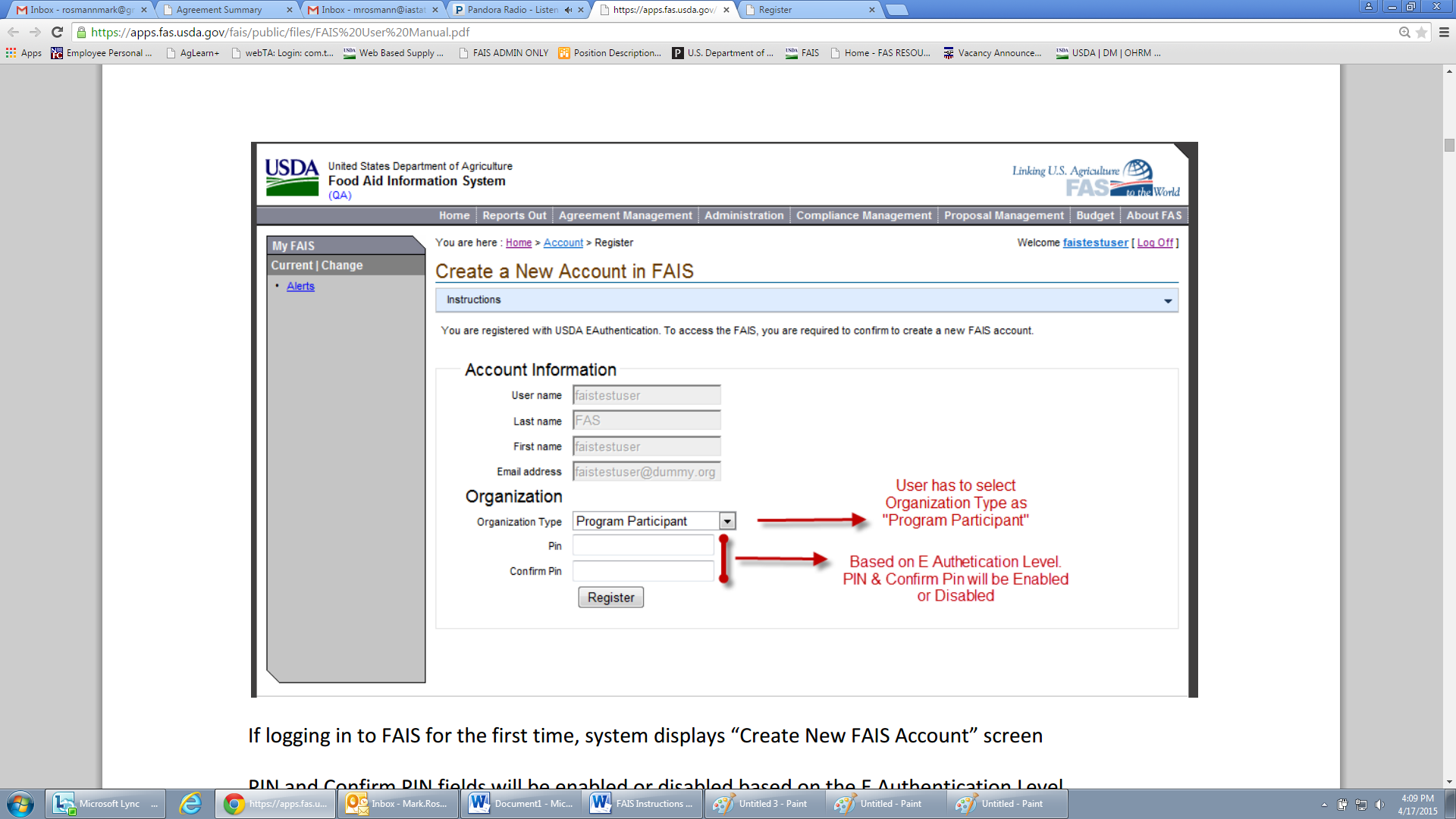
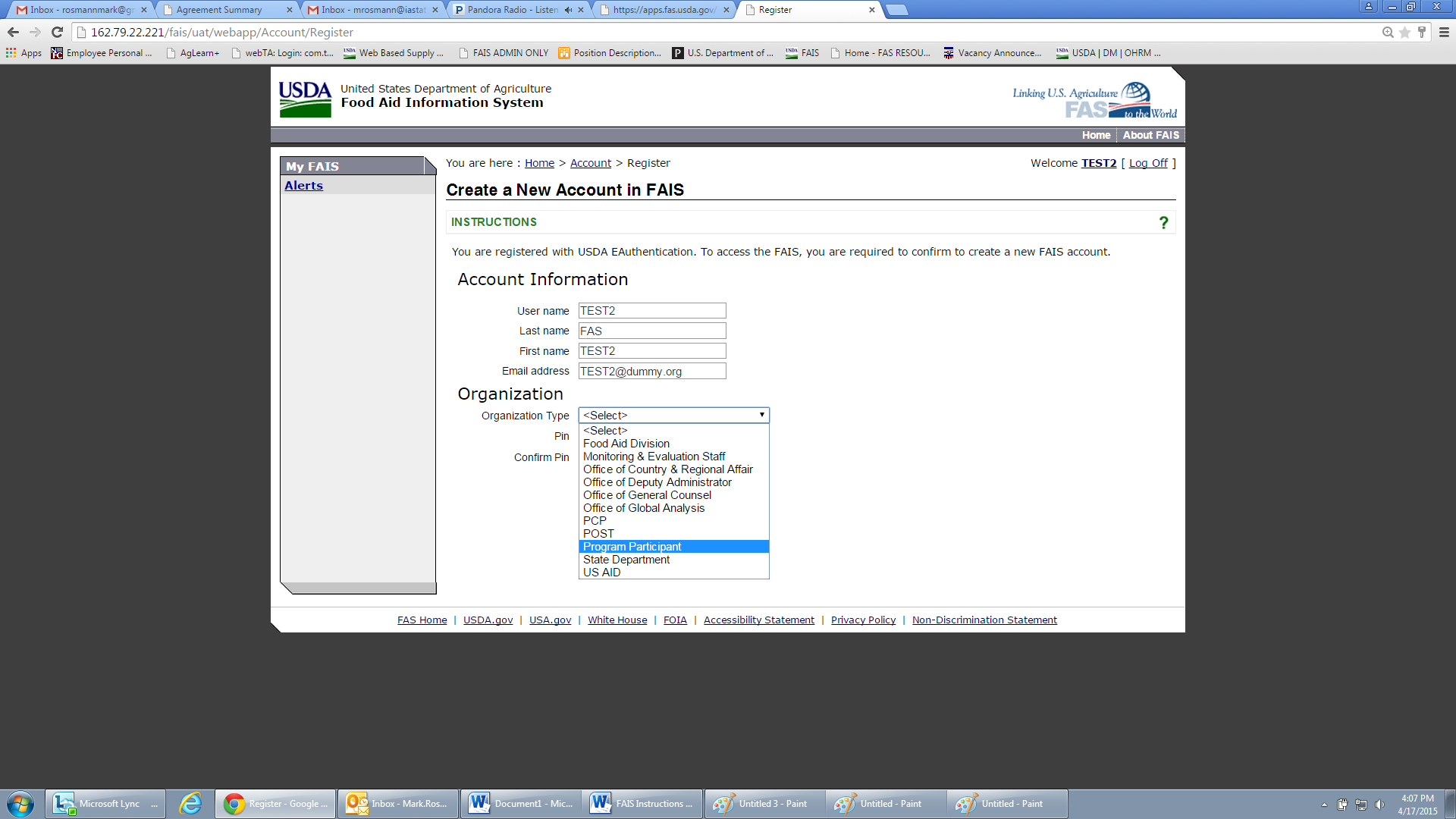

Next, applicants will be brought to the FAIS User Registration page. The eAuthentication details will be automatically generated in the cells. In the following Organization Details page, applicants must complete the following information:

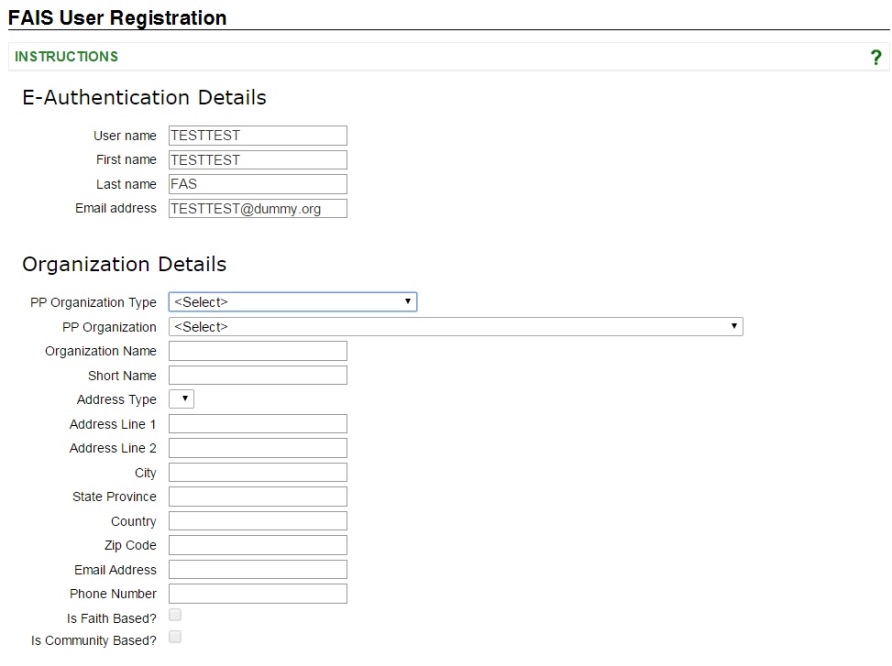
Select PP Organization from the drop-down list. If applicants are associated with a foreign government, or the World Food Program, select Government or World Food Program respectively. All other program participants, including PVOs, NGOs, etc. must register as a Program Participant
Select Organization – This list will be automatically generated based on the PP Organization Type selection.
S
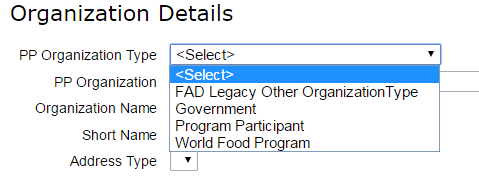 elect
Address Type –
After a proposal creator selects the address type, either Main
or Branch,
the field will be automatically populated with the organization’s
address
elect
Address Type –
After a proposal creator selects the address type, either Main
or Branch,
the field will be automatically populated with the organization’s
address
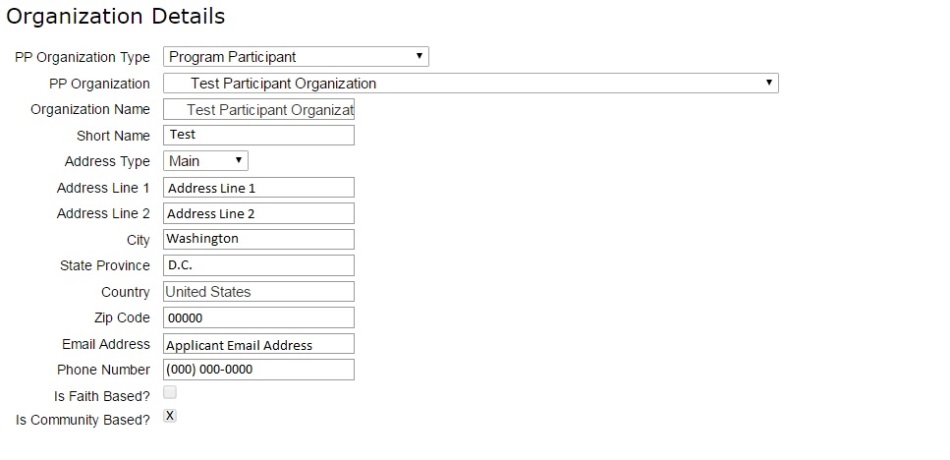
Requested Roles: For creating and producing proposals, the minimum FAIS permission levels required are Program Participant Proposal Contributor or Program Participant Proposal Creator. For those persons who are Program Administrators, they must also select the Program Participant Administrator box. Applicants may also request other FAIS permissions depending on the organization’s needs. For these requests, please detail these requests in the comments section. The level of permissions requested will be authorized by the FAD staff.

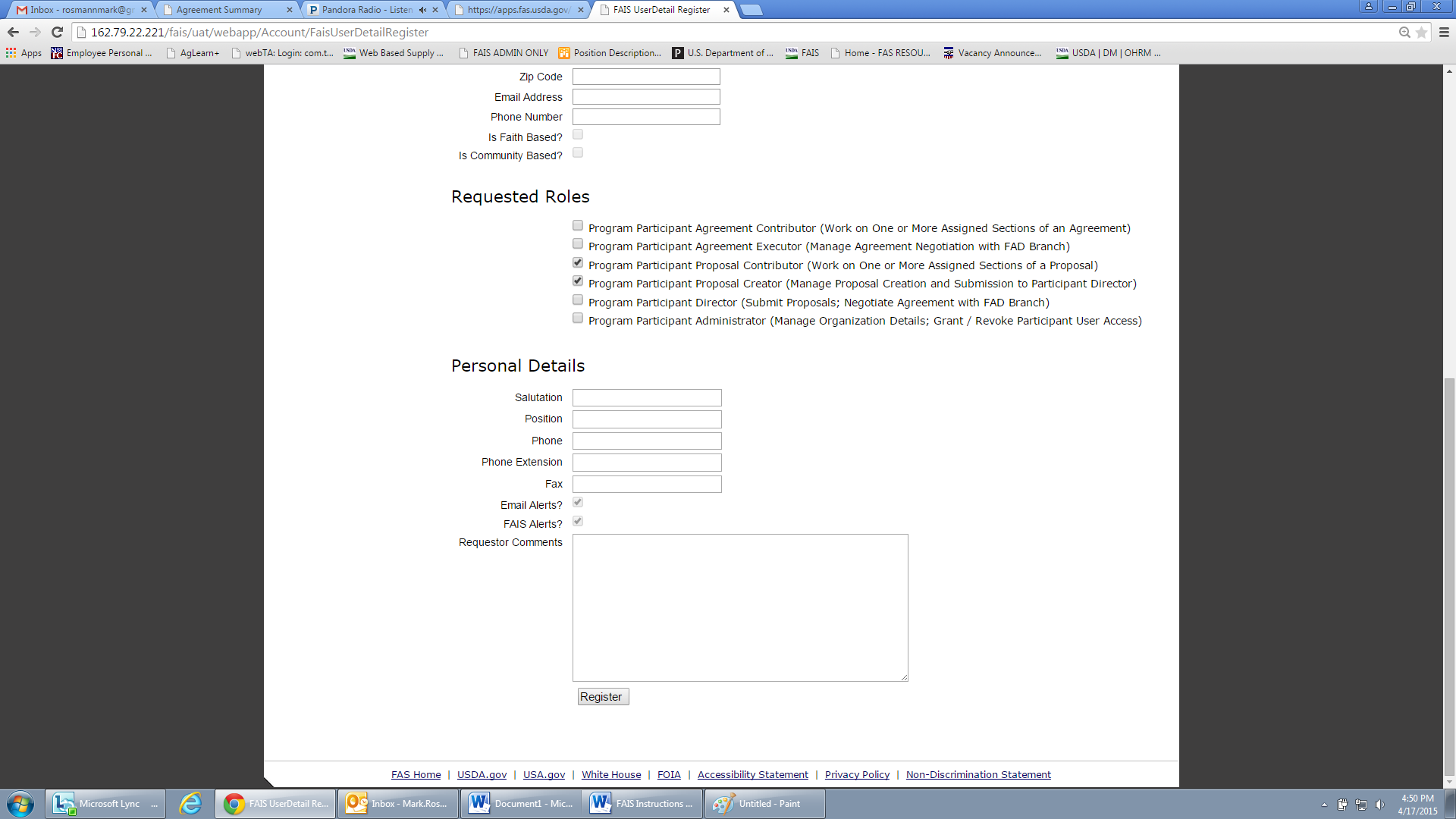
Next, refer to the following cells for the Personal Details section:
Title: Mr./Mrs./Ms. etc.; Mandatory
Position: Designation in the organization, e.g. Manager, Program Analyst; Mandatory
Phone Number: Mandatory
Phone Extension: Not Mandatory
Fax: Not Mandatory
Email Alerts: Check this box if e-mail alerts are preferred whenever any workflow action (i.e. submit, request modification) are sought on any process in FAIS; Encouraged
FAIS Alerts: Check this box if system alerts are preferred whenever any workflow action (i.e. submit, request modification) are sought on any process in FAIS; Encouraged
Requested Comments: Please add comments that details which requested roles wanted for the FAIS account; Not Mandatory
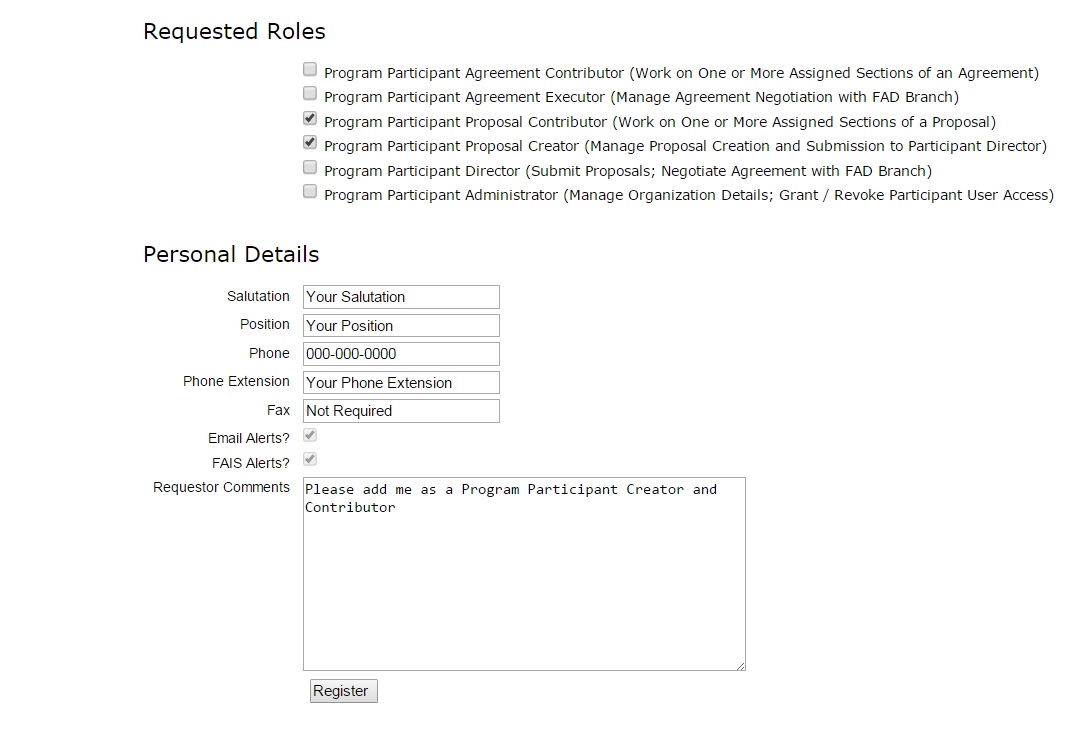
For Users with Unregistered Organizations
If the applicant’s organization is not yet registered, please download and fill out the Organization Registration Form, located on the FAIS homepage. Once completed, please attach the file in an Email and send to [email protected] with the subject line: Request to Register New Organization. A FAD Analyst will create the organization record in FAIS, and will notify the applicant once completed so they may select their organization.
Activiation of the Account
After successfully registers, the applicant will see the following message below regarding the activation of the account. FAD will also receive a notification that a new user has registered, and will approve the account.

Once approved, applicants will be able to login with their respective username and password and will be taken to the FAIS homepage.
FAIS Homepage
Once the applicant is logged in, he or she is taken to the FAIS homepage. Here, users will find links pertaining to the food aid solicitation, this training manual for Program Participants as well as other relevant documents. Please refer to the links and save the files as necessary.


A sitemap index with links is provided horizontally across the top of each page below the menu bar. These links will help in navigating through the hierarchies of each element and to keep track of locations within FAIS. The homepage consists of the following column headings:
Home – This link takes the applicant to the FAIS homepage
Proposal – All proposal and solicitation actions can be found here. This section is explained in greater detail below
Agreement – Database of every agreement associated to the organization
Compliance – Links to the database of the organization’s Monitoring and Evaluation (M&E) reports and other compliance-related actions
About FAIS – Information regarding FAIS including new system enhancements and data releases
In addition, brief instructions are provided on each screen in a green box as shown below. The instructions describe the mechanics of viewing and editing the screens and defined the data fields. Important business rules that must be followed are also included, where appropriate.


Important: In FAIS, the system displays a list of validation errors (if any) in red if there are issues with the data the applicant submits. FAIS will not commit the workflow action until the user fixes all validation errors. An example error message:
![]()
SECTION 2: CREATING A PROPOSAL IN FAIS
To begin creating the organization’s food aid proposal, click on the Solicitation icon that is located under the Proposal tab. The next screen displays the list of solicitations. If the current solicitation year is not displayed, the applicant can find the current program solicitations by searching by Fiscal Year and Program Type.


Start and End Dates: Period for accepting proposals against that solicitation
A
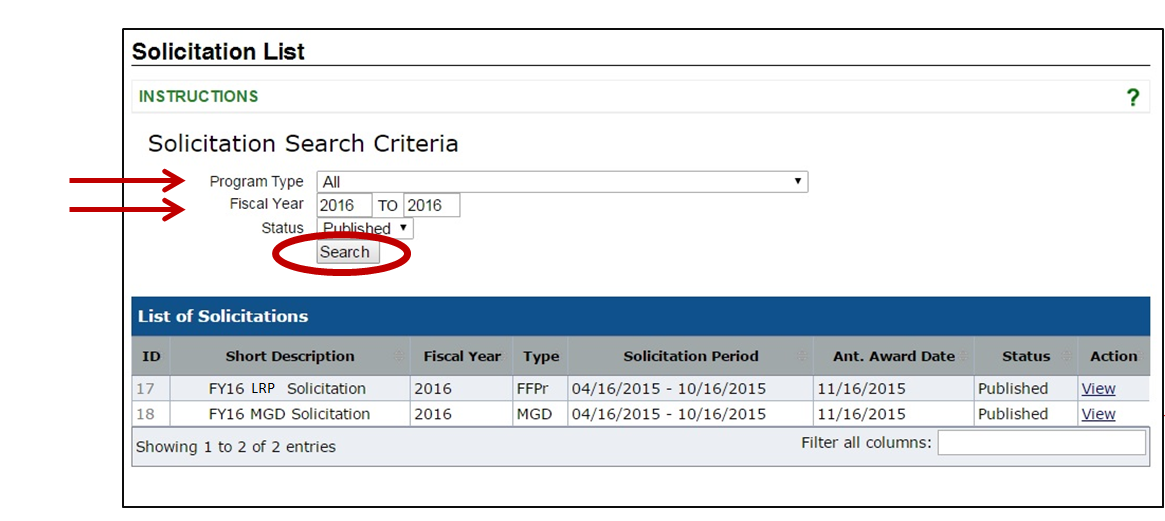 nticipated
Award Date:
A proposal submitted against a solicitation should specify a project
start date after the Anticipated Award Date
nticipated
Award Date:
A proposal submitted against a solicitation should specify a project
start date after the Anticipated Award Date
Click on the View link for the Local and Regional Procurement solicitation for which applicants will create a proposal. This is found under the Action column.
The following page allows both a Program Participant Director and Program Participant Proposal Creator to view a solicitation and to create a proposal for that solicitation. If applicants have Proposal Contributor permission levels only, they cannot create a proposal. In this example, the 2016 Local and Regional Procurement solicitation has been selected. The solicitation information listed below will be based on the award type. Click Create Online Proposal to generate a proposal template which the proposal creator will submit once completed.
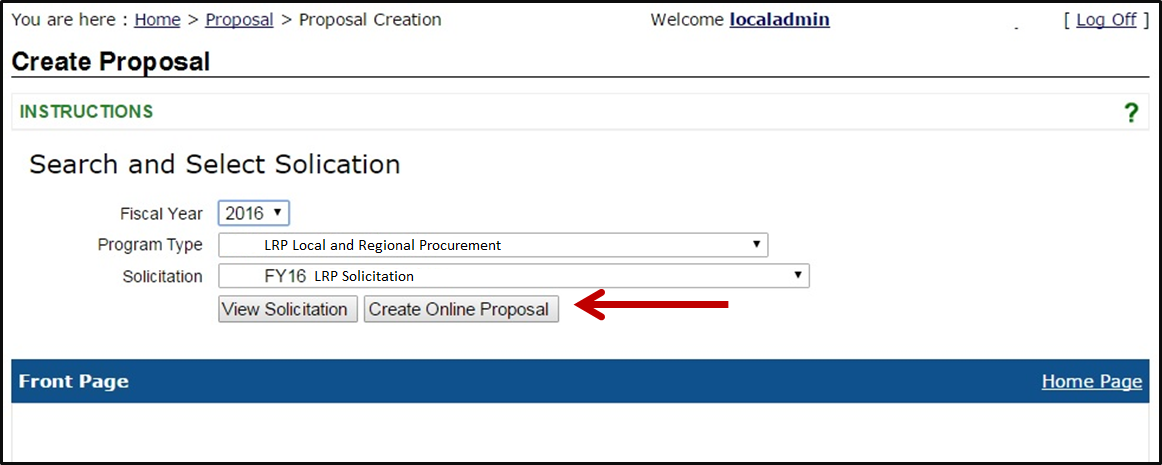
Once created, the proposal record is archived as In Progress in the FAIS system. After the applicant logs off, he or she can return to the proposal and work on it at any time. To find it, click on the Proposal tab located in the drop-down menu and select Proposal.


Applicants can then search for each created proposal affiliated with the organization. Click on the Proposal # to access the proposal and continue the submission process.

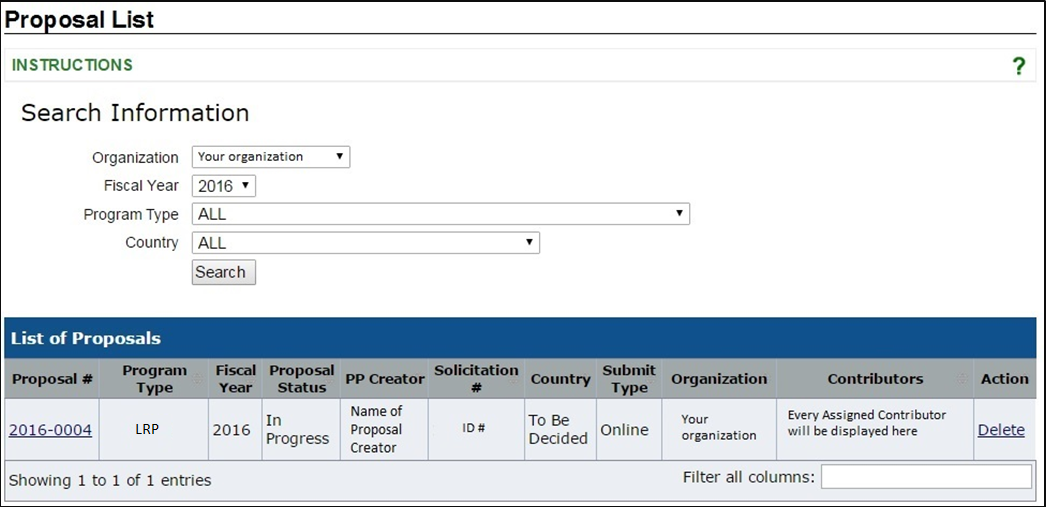

M y
FAIS
y
FAIS
A left panel titled My FAIS displays information describing the applicant’s proposal:
The Alerts link displays a database of past FAIS-program actions that transpired to the organization
Proposal # - Proposal identification automatically generated in FAIS
Organization – The name of the organization submitting the proposal
Solicitation ID – This is program number associated with the proposal
Fiscal Year – Proposal year
Status – All unsubmitted proposals will be labeled In Progress. This status will change once the proposal is submitted in FAIS
Country – This section will be labeled with the country or region and is entered in the Introduction section of the proposal
Data Navigation
This section provides links to the various sections necessary to complete the proposal. All other functions are arranged as menu items under several menus, access to which is governed by FAIS Roles. Each proposal section is highlighted in greater detail throughout this document. In Data Navigation, the following links are displayed:
Print Proposal – This is the display to which the proposal will be viewed by the reviewers, all information, including links to attachments will be displayed
D
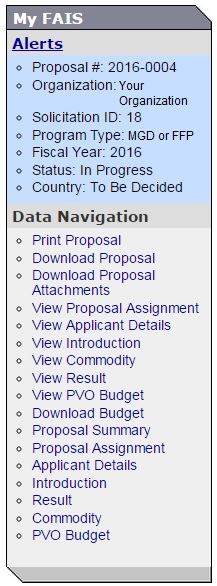 ownload
Proposal
– This function downloads the entire proposal as a HTML file.
In viewing the proposal, it is recommended to use the Print
Proposal function
instead
ownload
Proposal
– This function downloads the entire proposal as a HTML file.
In viewing the proposal, it is recommended to use the Print
Proposal function
insteadDownload Proposal Attachments – This downloads all uploaded documents into a single zip-file


LRP
View Proposal Assignment – This page displays a read-only view of the proposal assignments; i.e., the Proposal Creator and the Proposal Contributor assigned to each proposal section. Applicants cannot make any changes in any of the View links

1
2
3
4
5
6
7
8
9
10
11
12
13
14
15
16
17
View Applicant Details - Shows the applicant details in a read-only mode.
View Introduction – Shows the Introduction in a read-only mode.
View Commodity - Shows the Commodity section in a read-only mode
View Result – Shows the results, activities, and the mapping sections in a read-only mode

View PVO Budget - This page shows the Budget narrative in a read-only mode
Download Budget – This function was utilized for previous years’ budget proposals and is no longer used in FAIS. Refer to the budget guidelines for more information
The following links require data entry:
Proposal Summary – This is the homepage of the specific proposal where applicants are able to upload attachments and submit for review
Proposal Assignment – The page where roles are assigned to each of the proposal sections
Applicant Details - This page where primary applicants of the organization are assigned as contacts for the proposal
Introduction –Where program dates are selected in addition to country determination key personnel
Results – This page is for entering the Results, Activities, and Activity Mapping.
Commodity – This page is for submitting detailed commodity logistics
PVO Budget – Displays the section to submit the budget narrative
There are multiple sections in each link which require data entry in addition to uploading required attachments. These sections are detailed below.
SECTION 3: PROPOSAL SUMMARY
This section is the homepage of the applicant’s proposal. This page displays:
Proposal Information - Basic proposal information related to the organization
Proposal Section Details – Staff assigned as the PP Creator (Proposal Manager) and the various section Contributors (Authors). Only one PP Creator may be assigned to a proposal, and one Contributor may be assigned to a given section. One person may be assigned multiple sections, or as a PP Creator and PP Contributor
Proposal Workflow History – Shows each proposal review event
Workflow Actions – Shows the actions that can be executed based on the proposal status
Attachments – Link for uploading all of the proposal attachments (Refer to the Attachments portion of this document)

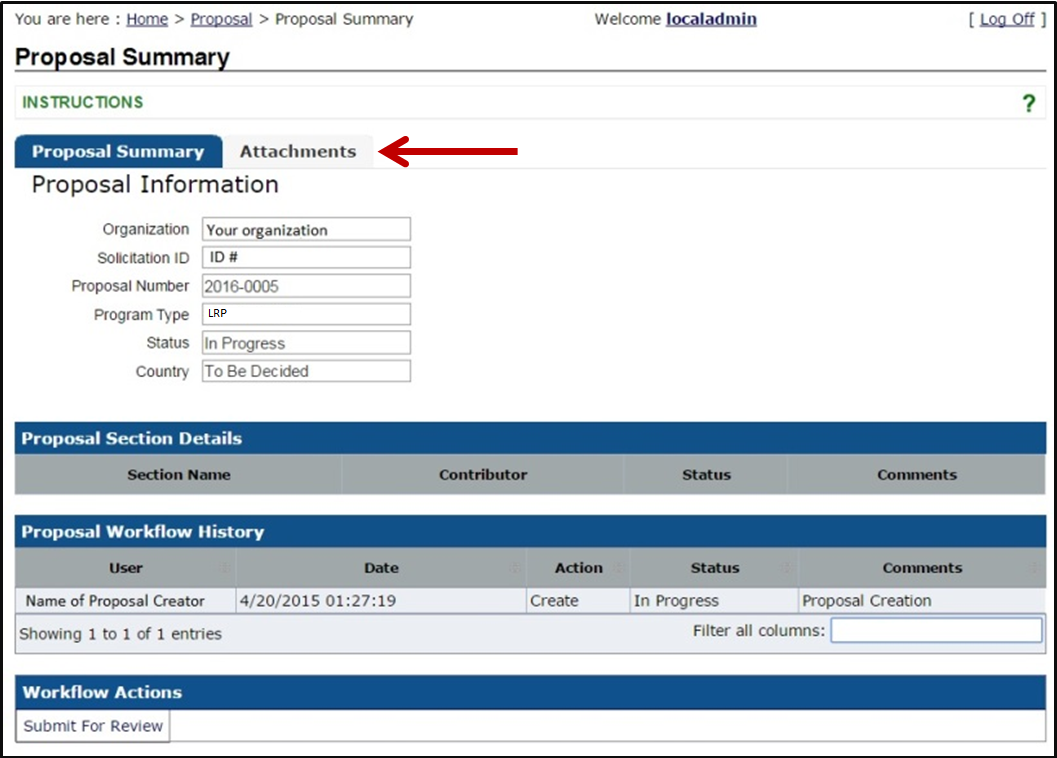
All proposal assignments will be displayed in this section, including changes to proposal contributor contacts and any workflow history that occurred, when a section is submitted for review.
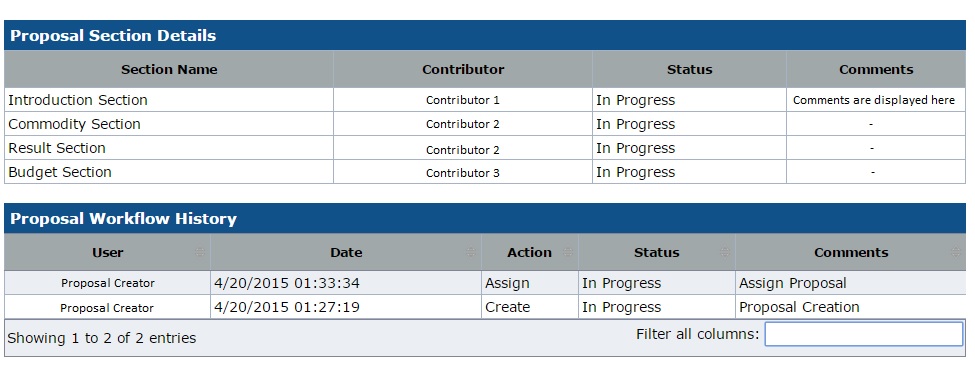
Important: FAIS will prevent the proposal from being submitted if all sections (Applicant Details, Introduction, Commodity, Results, Budget, and all attachments) are not reviewed and approved by the proposal creator. During the review process, each proposal section must have a status of Submitted for Review for the proposal creator to submit.
Proposal Assignment
After the proposal is created, the applicant will be immediately brought to the Proposal Assignment page. This section is used to assign the roles for the proposal and manage each particular section. These roles include:
Proposal Creator: The person in the organization assigned as the overall proposal manager. This person will have edit capabilities to all proposal sections and will be the first level reviewer for the various proposal sections if these sections are assigned to other staff members. In order for a person to be assigned this role, that person must be given this role in their FAIS registration profile. This role can be changed at any time.
Proposal Contributor: A staff member who is assigned to write a given section. A section contributor will be given edit capability only to the section(s) to which the person is assigned and has a read-only capability to all other sections. Note: This person may also be the Proposal Creator and PP Director if there is only one person responsible for producing the proposal.
I
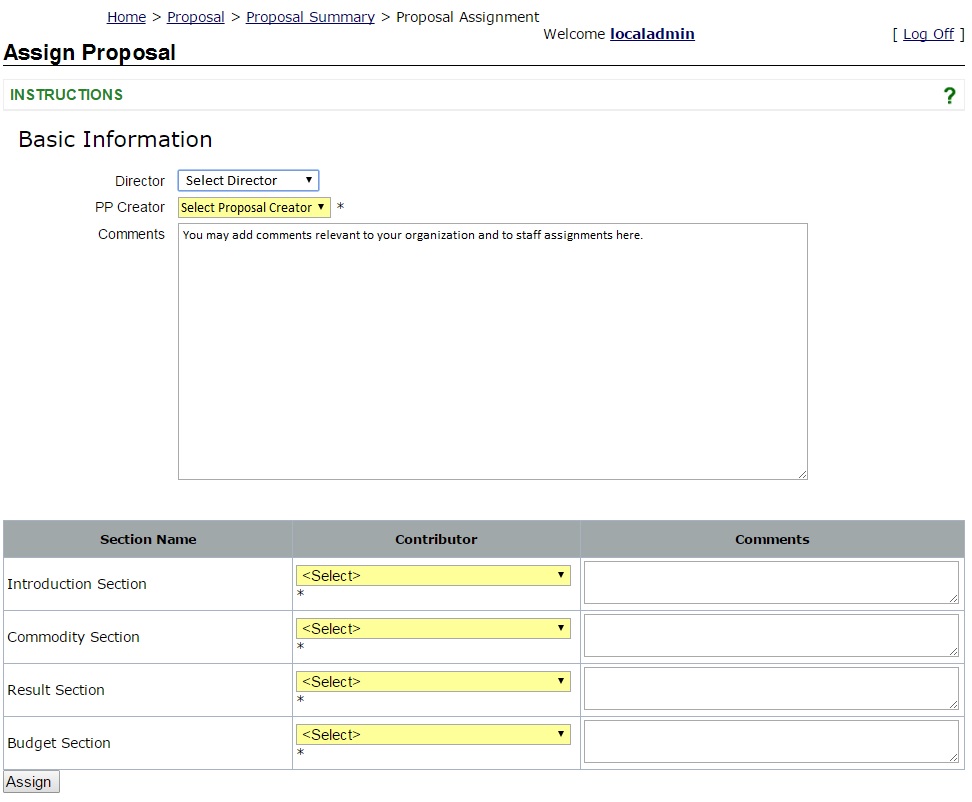 n
addition, there is a Comments
field that is used to convey any instructions to the persons assigned
by the proposal.
n
addition, there is a Comments
field that is used to convey any instructions to the persons assigned
by the proposal.


The proposal contains four major sections that require an assigned contributor. The sections can be assigned to persons in the applicant’s organization if they are registered in FAIS, and they have their own workflow and statuses as mentioned in the table below. The same person may be selected as contributor for all sections. Each field must have completed with an assigned individual. After the applicant clicks Assign, an automated mail is sent out to the contributors assigned to the section. This applies only to contributors who opted for email alerts when they registered.

Important: In each section (Introduction, Commodity, Results, and Budget), the assigned contributor has the decision to click on Submit for Review, which is located under Workflow Actions. This will send an e-mail alert to the Proposal Creator who will then have access to review the section and make any edits. The proposal creator can then request a modification of that section if necessary.

The applicant may also add comments regarding any actions or updates regarding the section in question. These comments should be for the organization team members only.
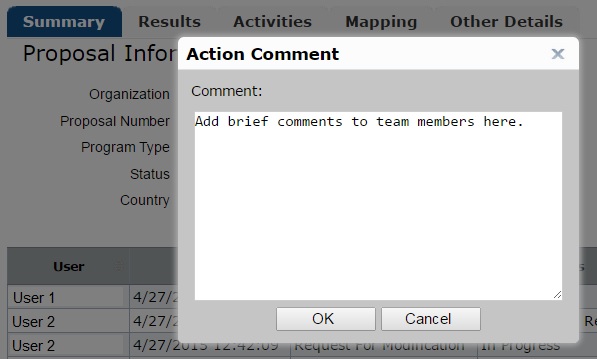
SECTION 4: PROPOSAL APPLICANT DETAILS
This page displays the list of people assigned as the contact for the applicant’s proposal. Both a Proposal Creator and PP Director are given the ability to specify each contact by clicking Create New Proposal Contact link.
Important: This is a mandatory section and the list of persons is different than the list of PP Creator and PP Contributors. The persons listed do not necessarily play a part in the proposal development nor require an account in FAIS.
To begin, click on Create New Proposal Contact.

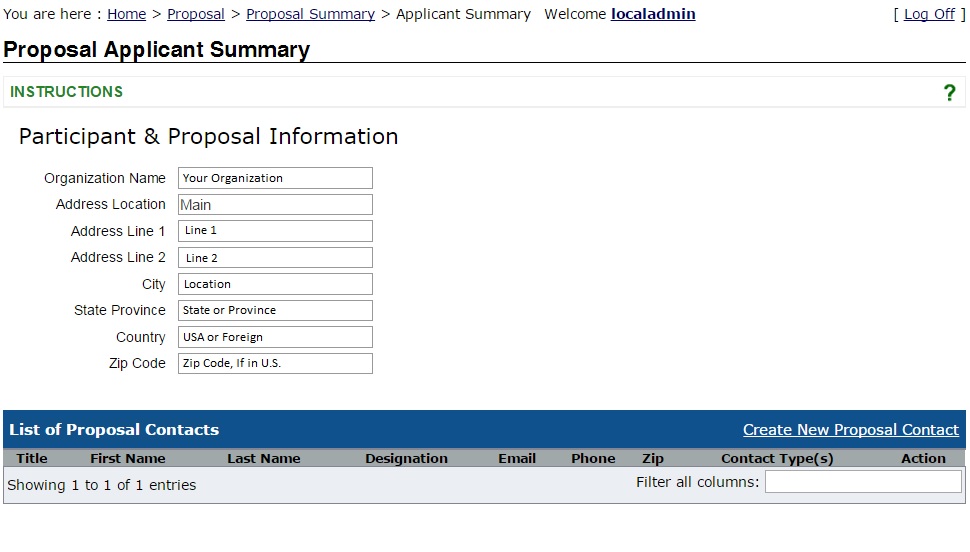
There are five types of required contacts. Applicants must assign a contact type to all individuals or FAIS will reject the proposal when submitted. A single person may be assigned multiple roles by selecting one person from the drop-down menu and checking multiple checkboxes. The contact types are:
U.S. Contact: The organization’s primary proposal contact located within the United States
Legal Signatory: The organization’s proposal contact with the legal authority to sign proposal documents
Donation Country: The organization’s contact in the proposed project country
Organization HQ: The organization’s proposal contact at the headquarters or main office of operations
Applicant: The organization’s proposal contact who is able to address proposal questions or issues. This is typically the Proposal Director or PP Creator
When a person is selected from the drop-down menu, the person's contact information will be populated from their FAIS registration profile. Only the person's phone number and fax number will be editable for the purposes of this proposal; i.e., the new information will not be stored permanently in the person's registration profile information.
Applicants
may select from a drop-down list of all Participant Contacts who are
registered with the organization in FAIS, or create a new contact.


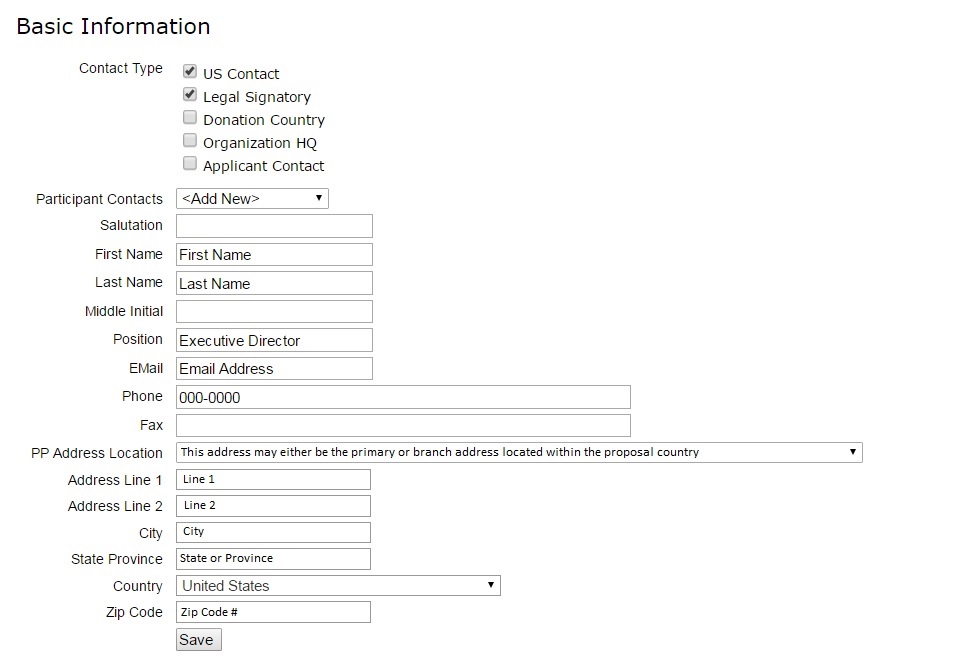
Reminder: All listed contact types must be included in the proposal. The created records will be displayed on the Applicant Summary page.

The following sections details each of the four primary sections required to submit a proposal in FAIS. Refer to the proposal solicitation for specific guidance regarding content.
SECTION 5: INTRODUCTION
Introduction Summary
The Introduction Summary page displays summary information and a workflow history about the introduction section, e.g., section submissions and requests for modification. This page also allows for submission of the section for review using the Workflow Actions section. Two required subsections exist here and are displayed as tabs:
Introduction Details (Country Selection)
Key Personnel (Program Administration List)

To begin, click on the Introduction link, and the system will display the Introduction Details page. Applicants will be able to edit the following details:
Country - Please refer to the solicitation for the list of priority countries and regions. Every country, territory, and region is listed alphabetically
Anticipated Start Date – This date must not be prior to the Anticipated Award Date stated in the solicitation
Anticipated Completion Date – This is the tentative date which the program will end
Anticipated Monetization Date – This section is for only required for programs with monetized commodities and is not required for LRP.
Check box for a Continuation of a Previous Program – Normally reserved for proposals that are extensions of existing projects. Please leave unchecked for LRP.
Click Save to record the details for this section.


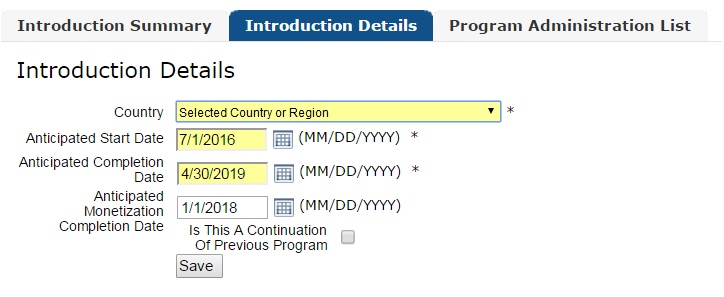
Key Personnel
This page lists the project staff participating in project administration roles. Applicant should highlight the technical and management experience of the Chief of Party or Country Director and the proposed management structure of the project which outlines the appropriate positions. Refer to Organizational Capacity and Staffing for instructions regarding the list of project personnel. In addition, applicants may submit as an attachment an organizational chart detailing the list of key positions.
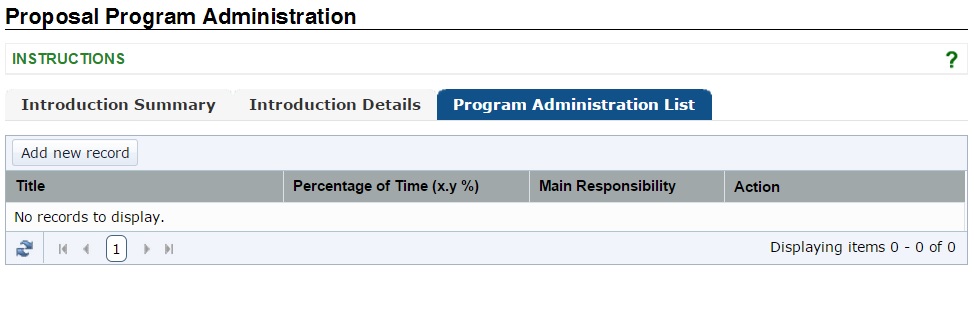
To create a new entry, click on the Add New Record button. Enter the values for each field; e.g., <Executive Director, 100%, corporate support>, in the table and press the Insert button.


 Use
the Edit
button to enter new values for an existing entry, then click Update.
Use the Delete
button to delete an entry from the table. Applicants should not use
more than 128 characters for responsibility description.
Use
the Edit
button to enter new values for an existing entry, then click Update.
Use the Delete
button to delete an entry from the table. Applicants should not use
more than 128 characters for responsibility description.

W
![]() hen
complete, including all other sections of the introduction section,
return to the Introduction
Summary
tab and click on Submit
for Review.
hen
complete, including all other sections of the introduction section,
return to the Introduction
Summary
tab and click on Submit
for Review.

If there are no submission errors or omissions, a green box will be displayed stating that all data sections have been recorded.
![]()
SECTION 6: RESULTS
USDA-FAS has developed program-level results frameworks for the Local and Regional Procurement Program. However, the Results Framework will not be required to be filled out in FAIS. Instead, the Results Framework will be uploaded as an attachment in FAIS. However, there are other sections that are essential to the proposal and must be completed by the applicant.
Proposal Result Summary
In the Results Summary page, there are two tabs out of four that require data entry. These sections are the following:
Activities
Other Details
The Results and Mapping sections will not be required to be completed for LRP, as these sections only apply to McGovern-Dole and Food for Progress proposals.





Activities
As
part of the proposal application (see – Activities) the
applicant must provide, a complete list of activities, and are
required to provide short narratives related to this section which
will be detailed below.
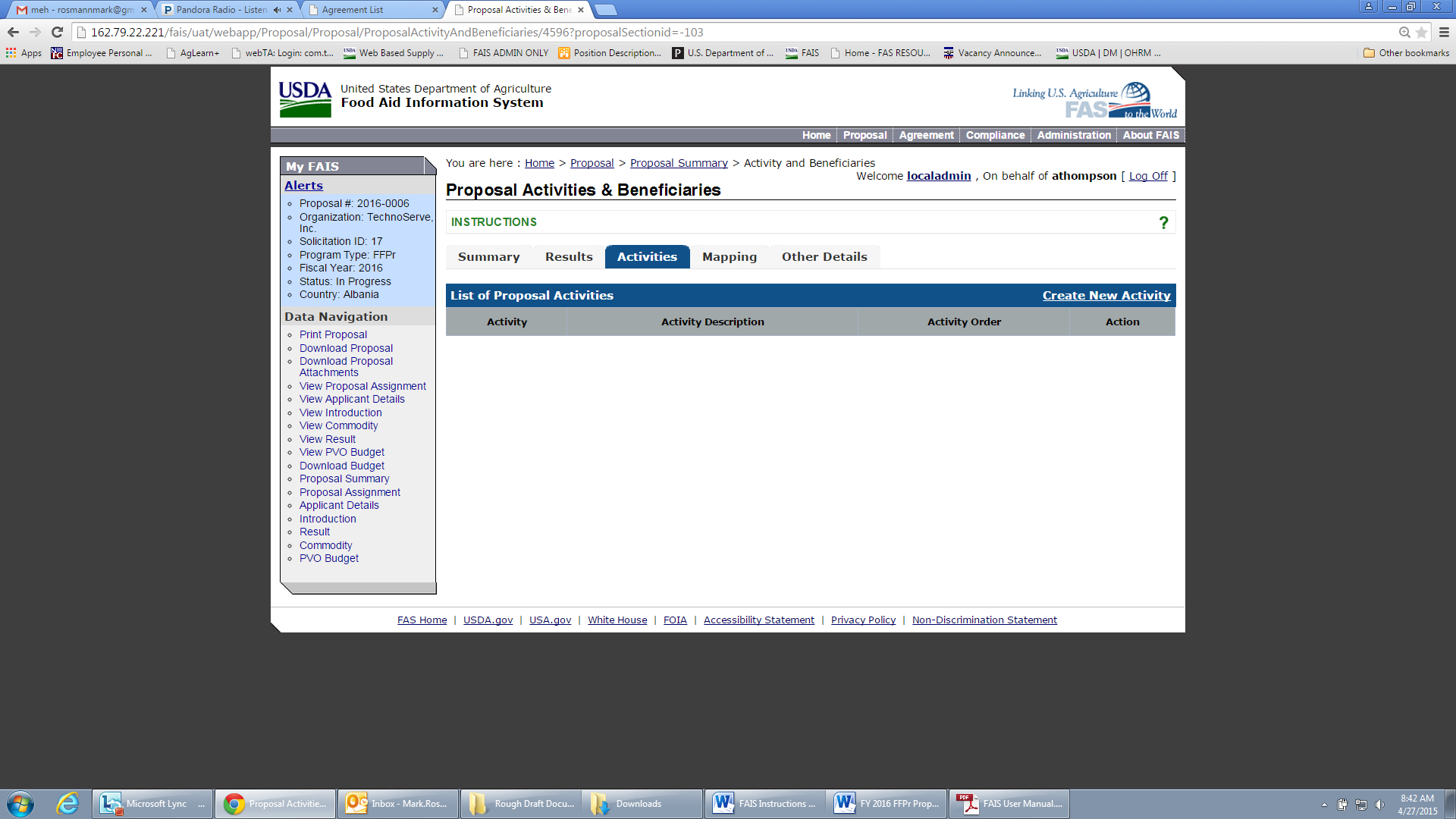
To add an activity, click the Create New Activity link located on the activities table.
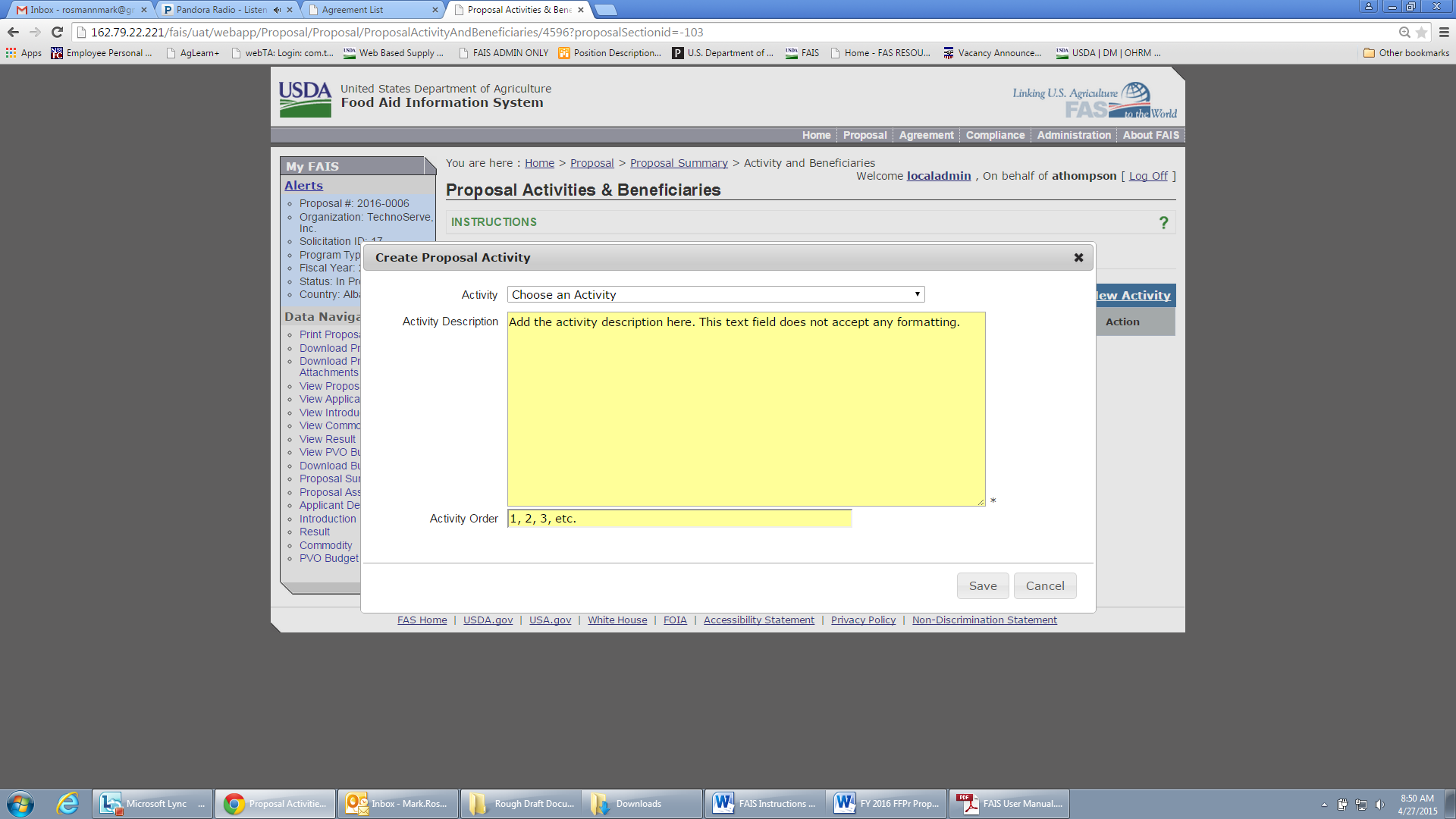
Refer to the list of activities found in the drop down list. Applicants may produce a custom activity by selecting Custom Title, which will produce a cell where the new activity can be recorded.

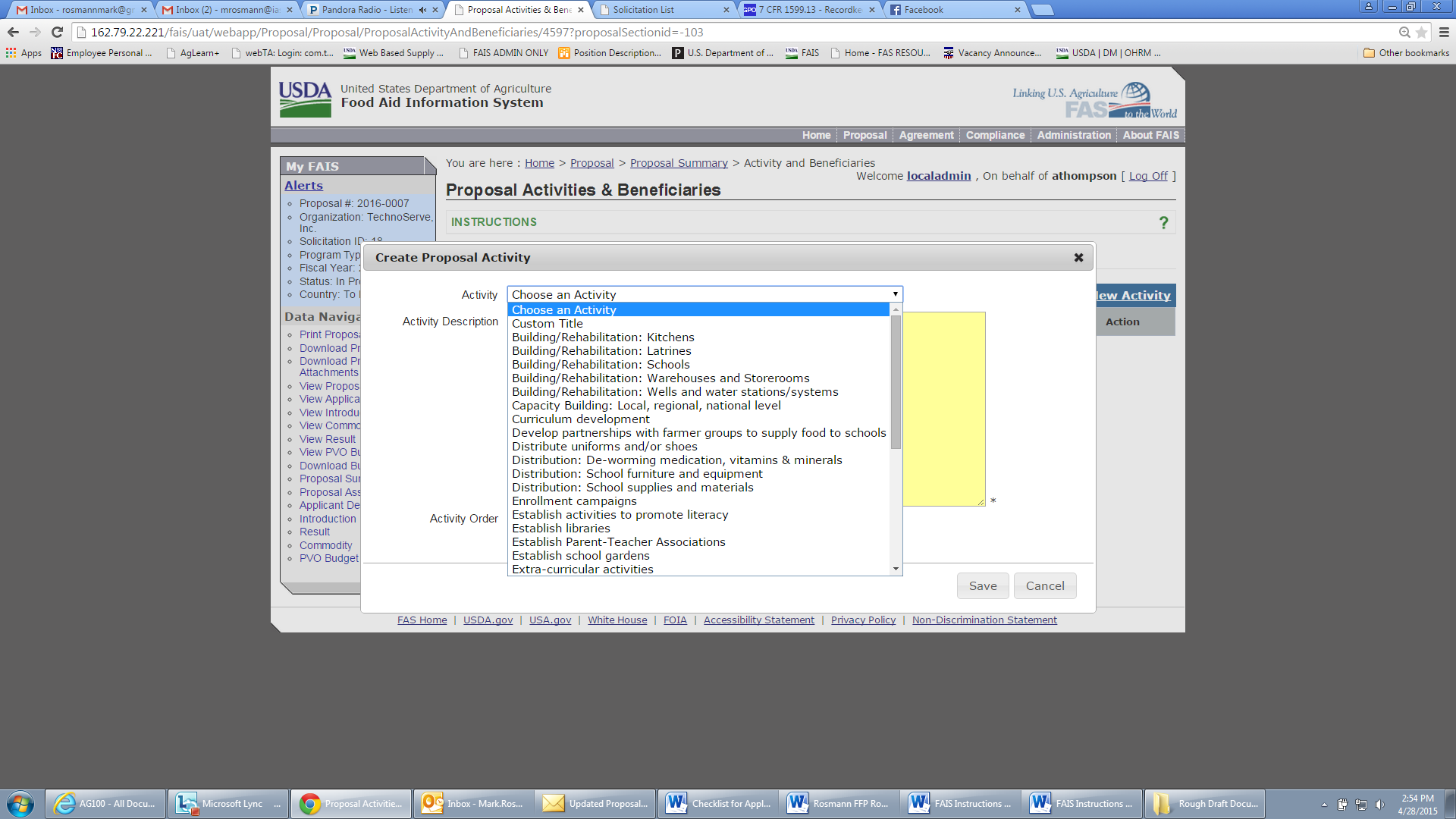
The field character limits for these cells are: Custom Title (64 characters), and Activity Description (16,384 characters). The text boxes do not allow for any formatting.

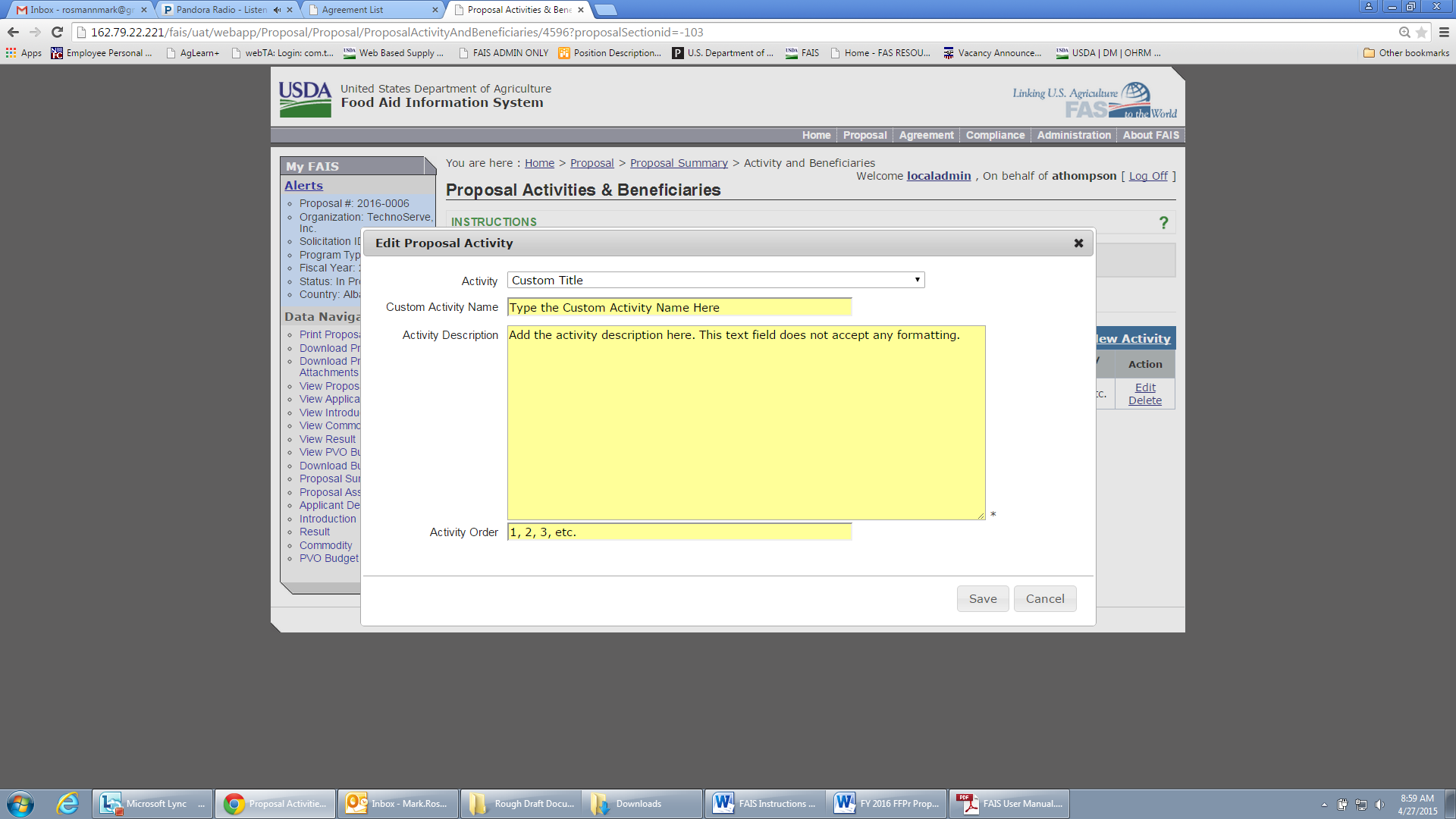
Use the Activity Order cell to sort the activities in the table, as desired. Enter whole numbers for Activity Order and the list of activities will display in ascending order of the numbers entered. Click Save to record the activity into the table. Applicants may edit or delete each activity where necessary.


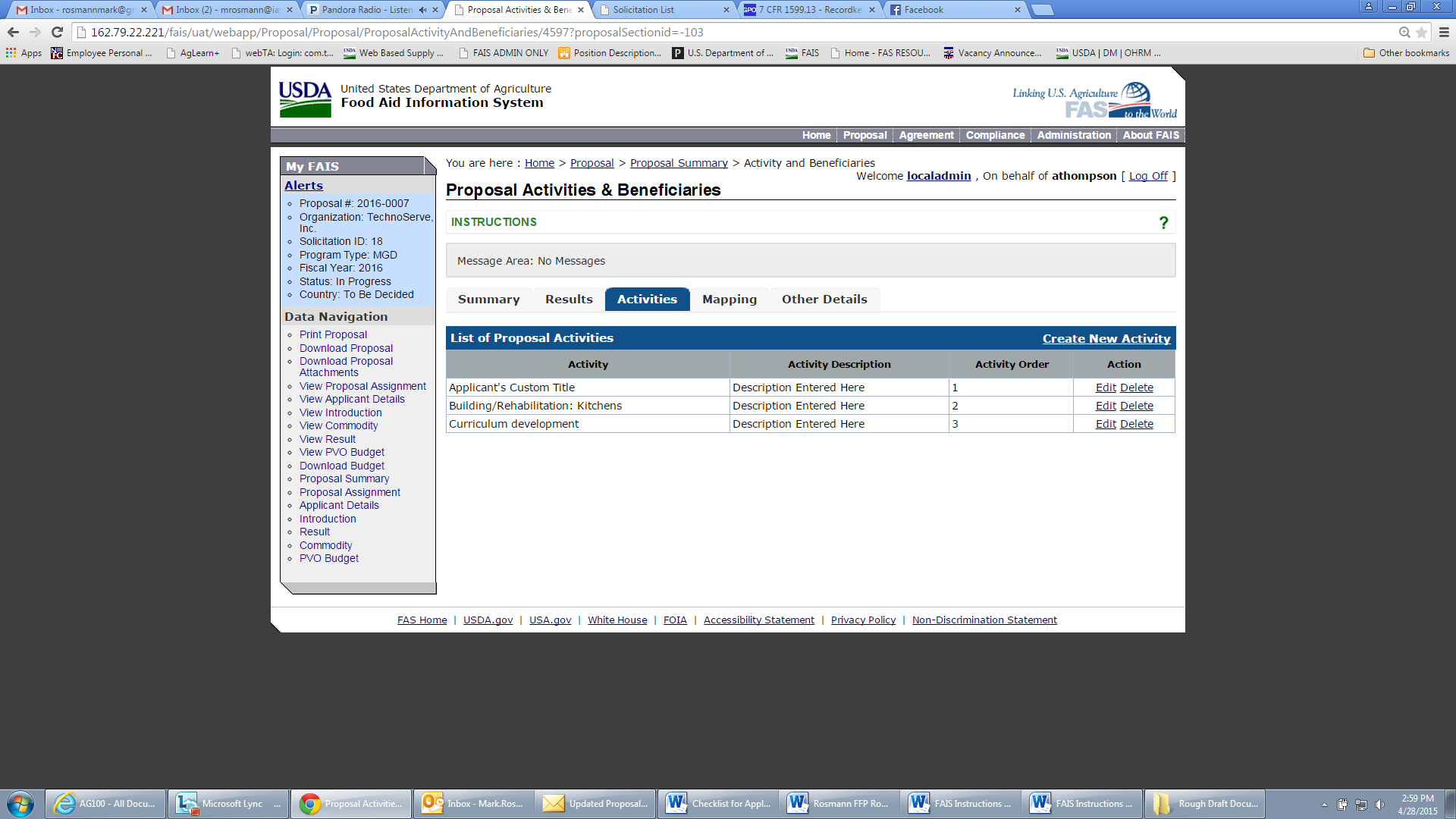
Other Details
The final tab of the Results section includes the submission of information regarding the following:
Cash or Non-cash Contributions
Sub-recipients
Government and Non-Governmental Agencies
Method of Educating the Public
Method of Choosing Beneficiaries
Target Geographic Area (Illustrative maps can be uploaded in FAIS as an attachment)
All applicants must complete the Other Details section regarding the results entered in their proposal. Note: All fields are mandatory; please refer to Part IV Section B – Other Details for detailed instructions.
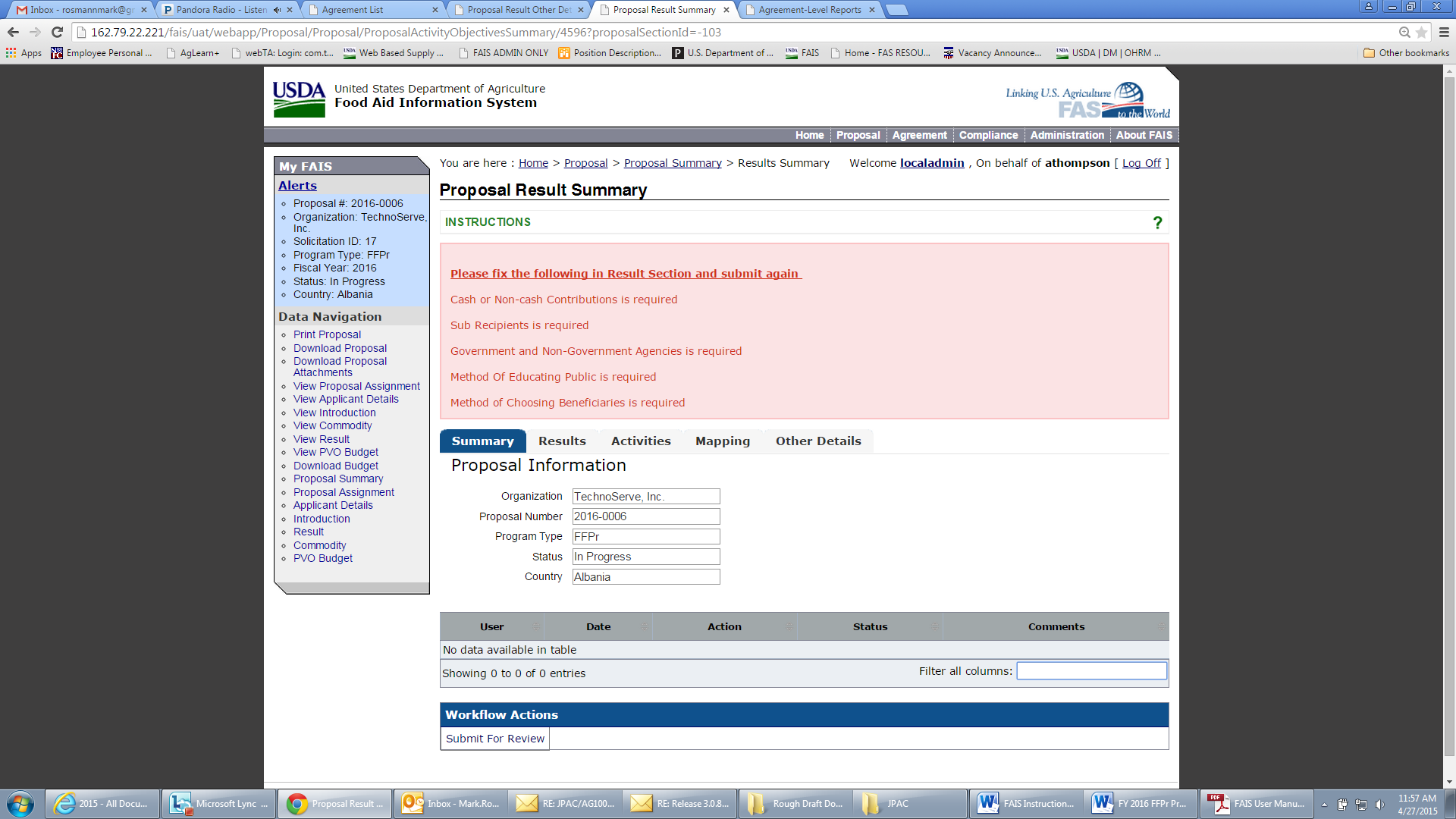

Once each section is completed, return to the Results Summary tab and click on Submit for Review, located under the Workflow Actions display. If there are no submission errors or omissions, a green box will be displayed stating that all data sections have been recorded.

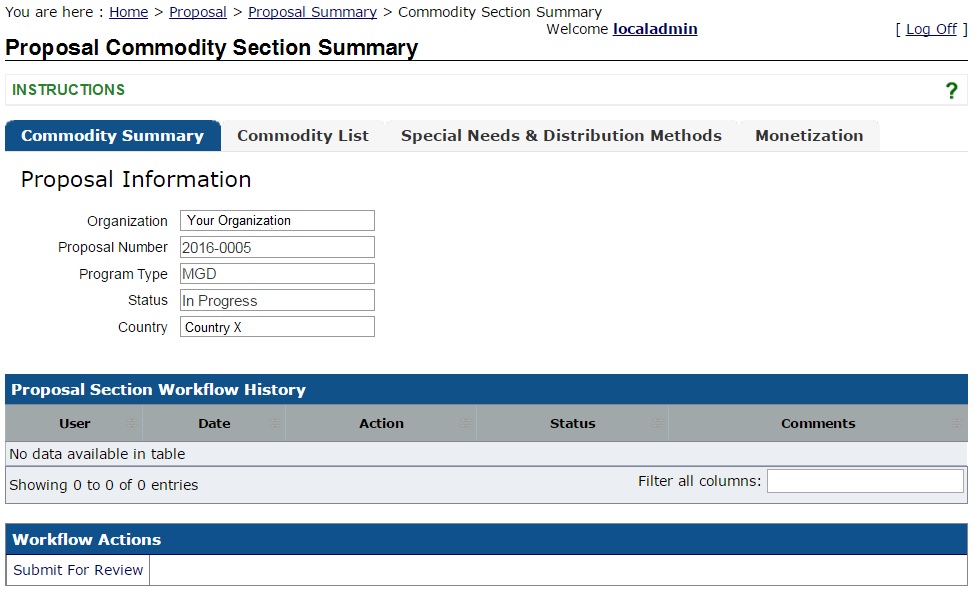
![]()
SECTION 7: COMMODITY
Commodity Summary
The Commodity Summary page displays summary information about the proposal, and the history for the Commodity section; e.g., section submissions and requests for modification. This page also allows the applicant to submit for review using the Workflow Actions section. This section is normally required for Food for Progress and McGovern-Dole proposals. Therefore, only one section is required, the Special Needs & Distribution Methods tab. The Commodity List and Monetization tabs are not required for LRP.
Special Needs & Distribution Methods





Commodity List
This page is not required for submission. All selected commodities must be listed and uploaded as a separate attachment in the proposal. Important: Refer to Commodity List, for specific guidance on Commodity sections.
Special Needs and Distribution Methods
In the Special Needs and Distribution Method tab, please refer to Special Needs & Distribution Methods, for specific guidance on the requirements of this section. Each text section has a 5,000 maximum character limit in FAIS. In FAIS, the user is required to enter detailed information for the following fields:
Transportation and Storage
Processing or Repackaging
Duty Free Entry
Economic Impact
Ration Justification
Select Save to record the entered data. The text boxes utilize a rich-text field (RTF), and this section should have an appropriate format that does not detract from the text language.

Monetization
For LRP, this section is not required and applies only to Food for Progress or McGovern-Dole programs that monetize commodities.
Once the commodity section is completed, return to the Commodity Summary tab and click on Submit for Review, located under the Workflow Actions display. If there are no submission errors or omissions, a green box will be displayed stating that all data sections have been recorded.
![]()


SECTION 8: BUDGET
PVO Budget Summary
Applicants must submit a budget summary corresponding to the example table provided in the Budget Summary example of this solicitation as an attachment. A budget narrative, either copied into the appropriate FAIS section or uploaded as an attachment, must accompany this summary.
PVO Budget Narrative
If submitting directly in FAIS, applicants are required to submit the budget narrative in the RTF box provided. Applicants can access this section by clicking on the Budget Narrative tab. Graphics are not recommended to be pasted into this section, although tables may be included; be sure to check if the cells are formatted properly as it is reviewed. Please refer to specific guidance in Appendix A that details how the budget narrative should be structured.


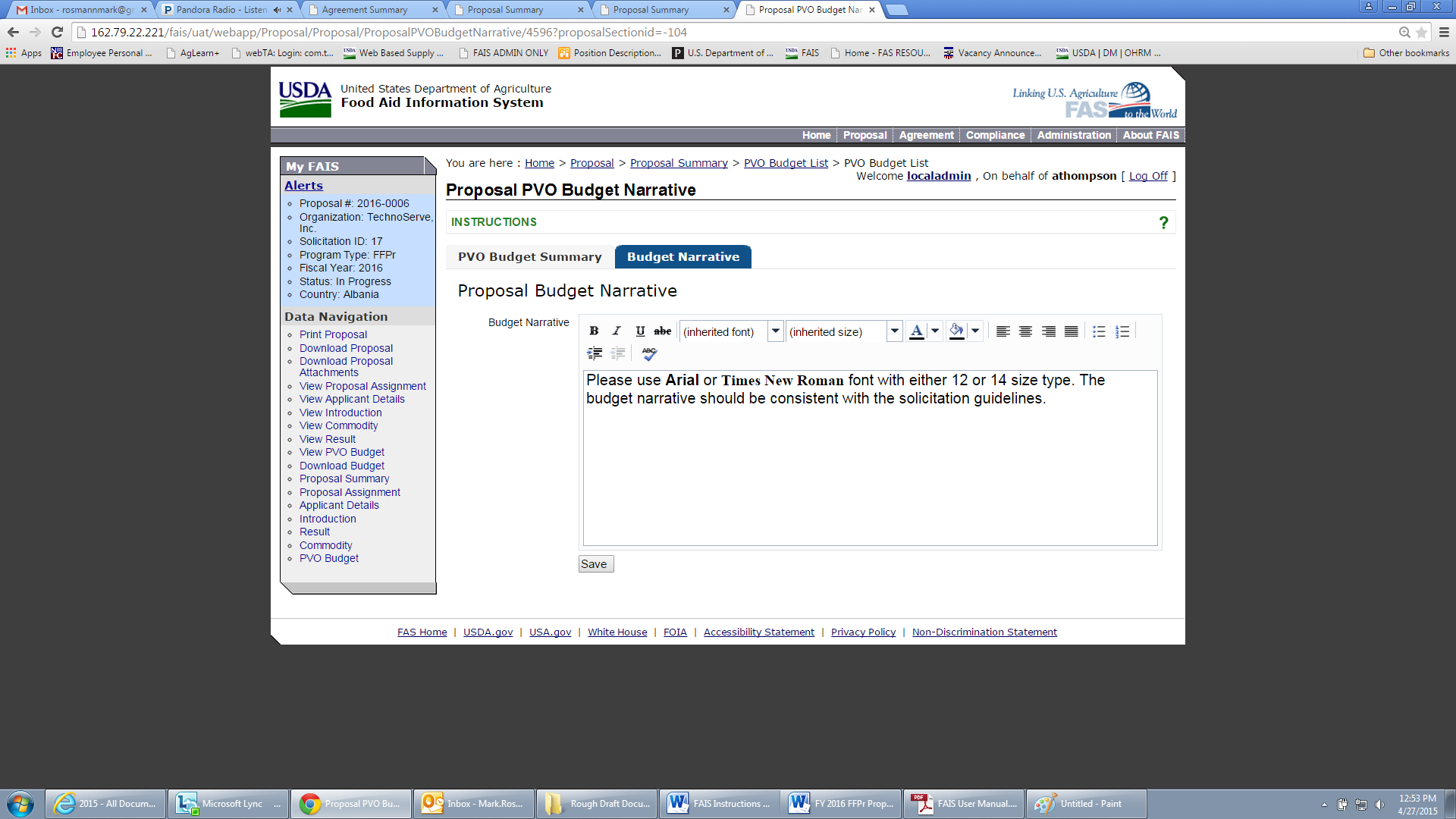
Once complete, click Save, and the following message will appear on the screen.
![]()
When the applicant is finished with the budget narrative, return to the Budget Summary Page and click Submit For Review.

![]()
SECTION 9: ATTACHMENTS
Use this tab to attach all documents necessary for the proposal. A drop-down list of all required attachments is to upload is displayed. Any documents not in the list below, but supports the proposal can be uploaded here and should be labeled as Generic. Important: The applicant’s proposal will be rejected in FAIS if any File Types in the drop-down list are omitted (Excluding Generic). Each file type should be selected and included in the proposal. To access this section, click on the Attachments tab that is located in Proposal Summary.

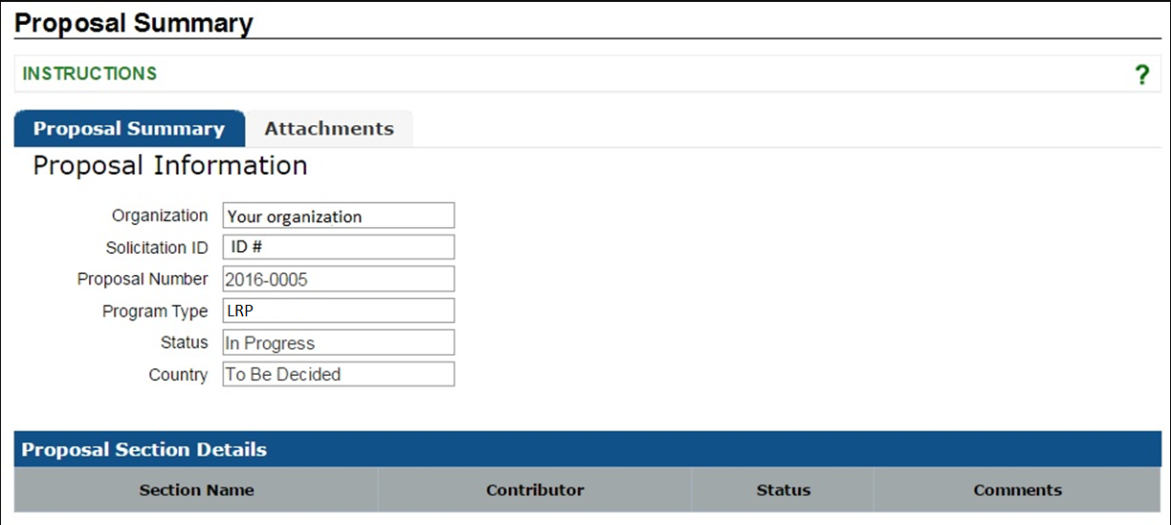
The attachments required to upload in the proposal are the following:
Budget Summary
Detailed Budget
Performance Indicators
Introduction and Impact Analysis
Financial Statement
Curriculum Vitae (CV)
Past Performance Records
AD-3030
Project Framework
SF-424
NICRA Agreement
Generic (Results Framework, Commodity Selection and Management Narrative, Letter of Support, References)
Note: The Results Framework, the Commodity Selection and Management Narrative must be uploaded as attachments. These can be labeled as ‘Generic’ when uploading the files. Refer to the solicitation guidance for more information on each required attachment. An Evaluation Plan is not required for submission.
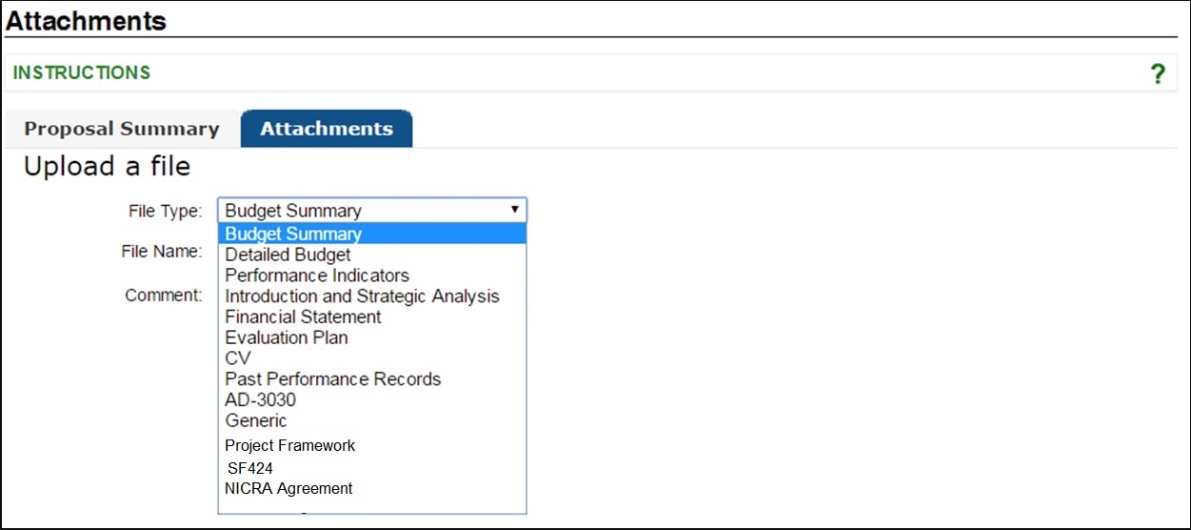

To attach a document:
Select the File Type from the drop down list
Select the desired file to upload by selecting Browse
Add comments or a label describing the file type, this can be the title of the document or a detailed description
Select Upload to upload the document. Once complete, the document will be listed in the table below
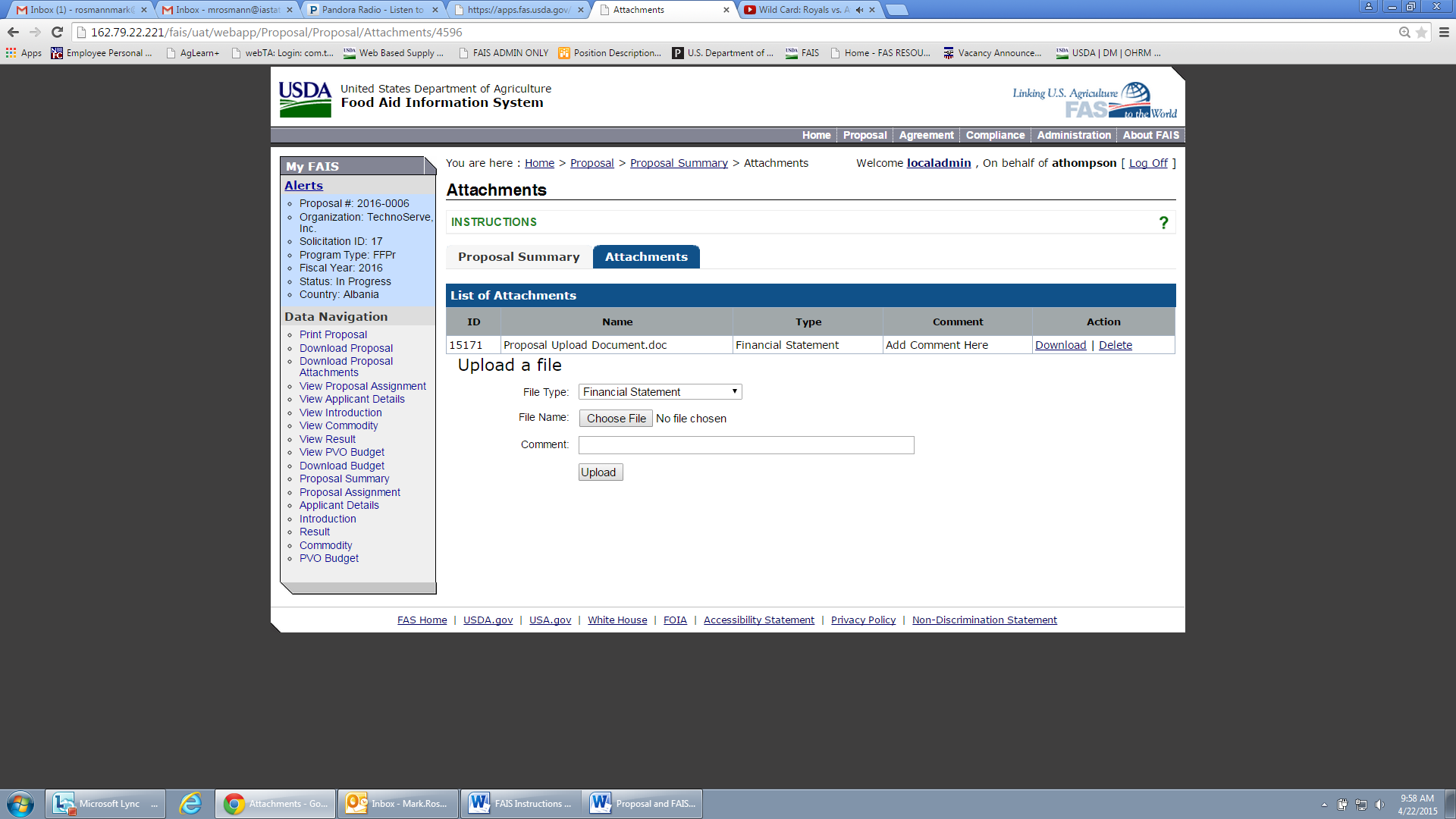
To delete any document uploaded, click the Delete icon.
SECTION 10: SUBMITTING THE PROPOSAL
Once each section (Introduction, Commodity, Results, and PVO Budget) are complete and submitted for review, and all required attachments are uploaded, the food aid proposal is ready to submit in FAIS. Applicants should ensure that each section has been submitted for review. Click on the Submit for Review icon listed under Workflow Actions.


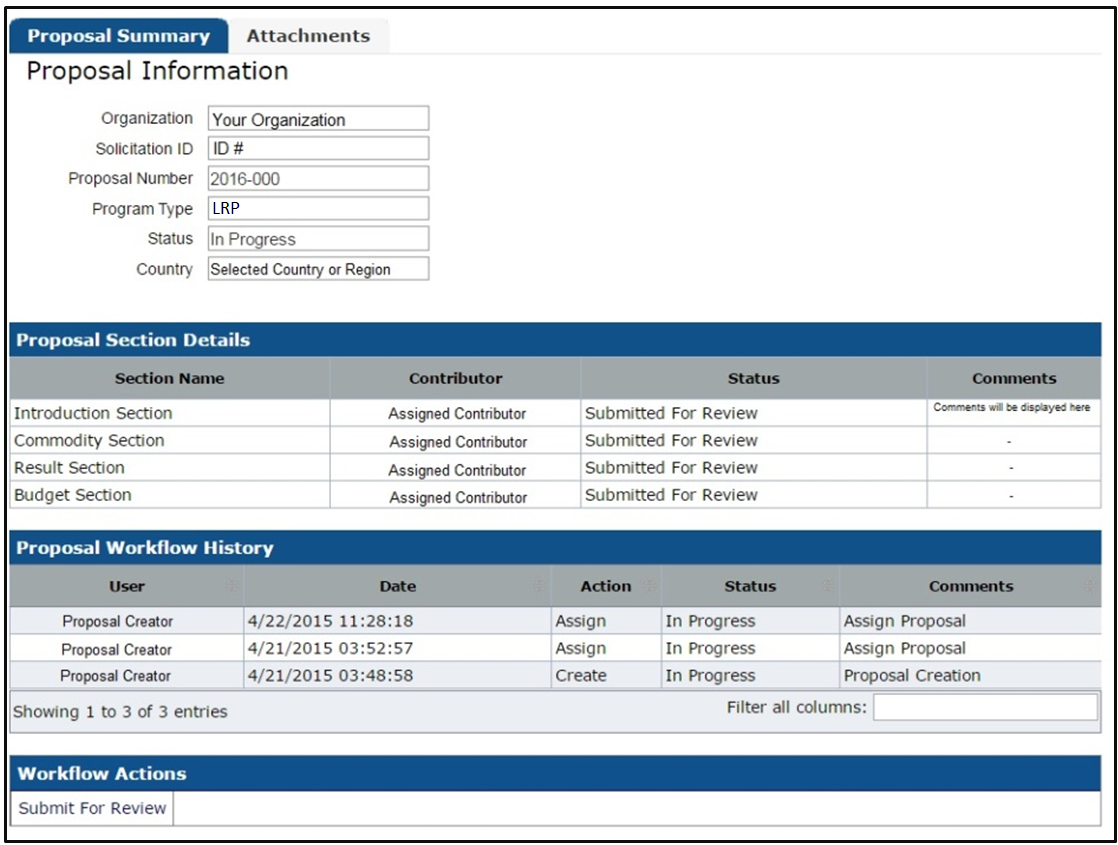
If FAIS detects any incomplete data, the system will reject the submission and a red message box(s) will list all absences.
Attachments and Applicant Contacts - Check if every required attachment is uploaded with the appropriate File Type label. For applicant contacts, make sure that every required contact type is included. If one is missing the system will reject the proposal.
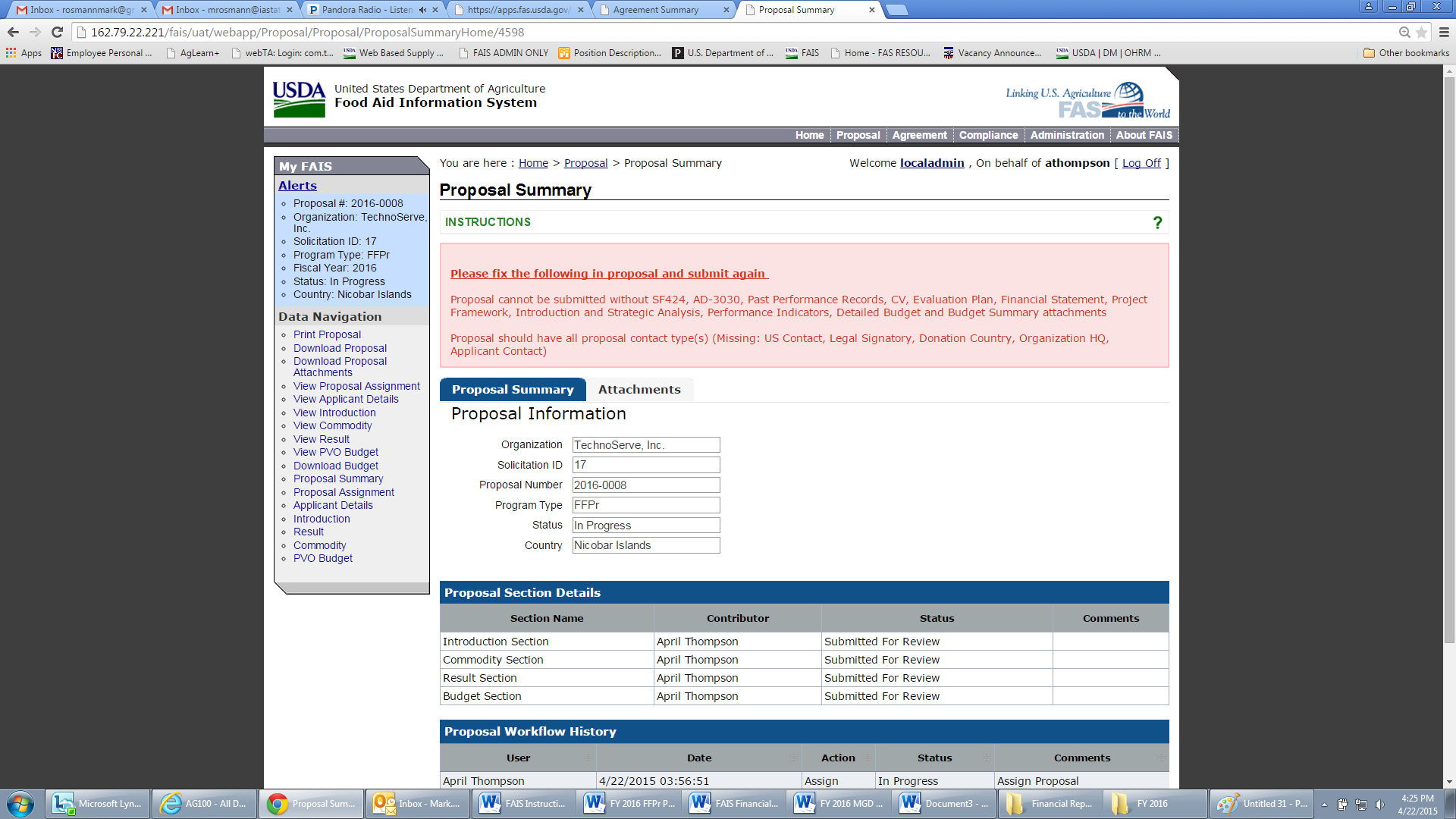
Introduction – If the monetization completion date cell is blank or falls outside of the start and end dates, and/or the Program Administration list is incomplete
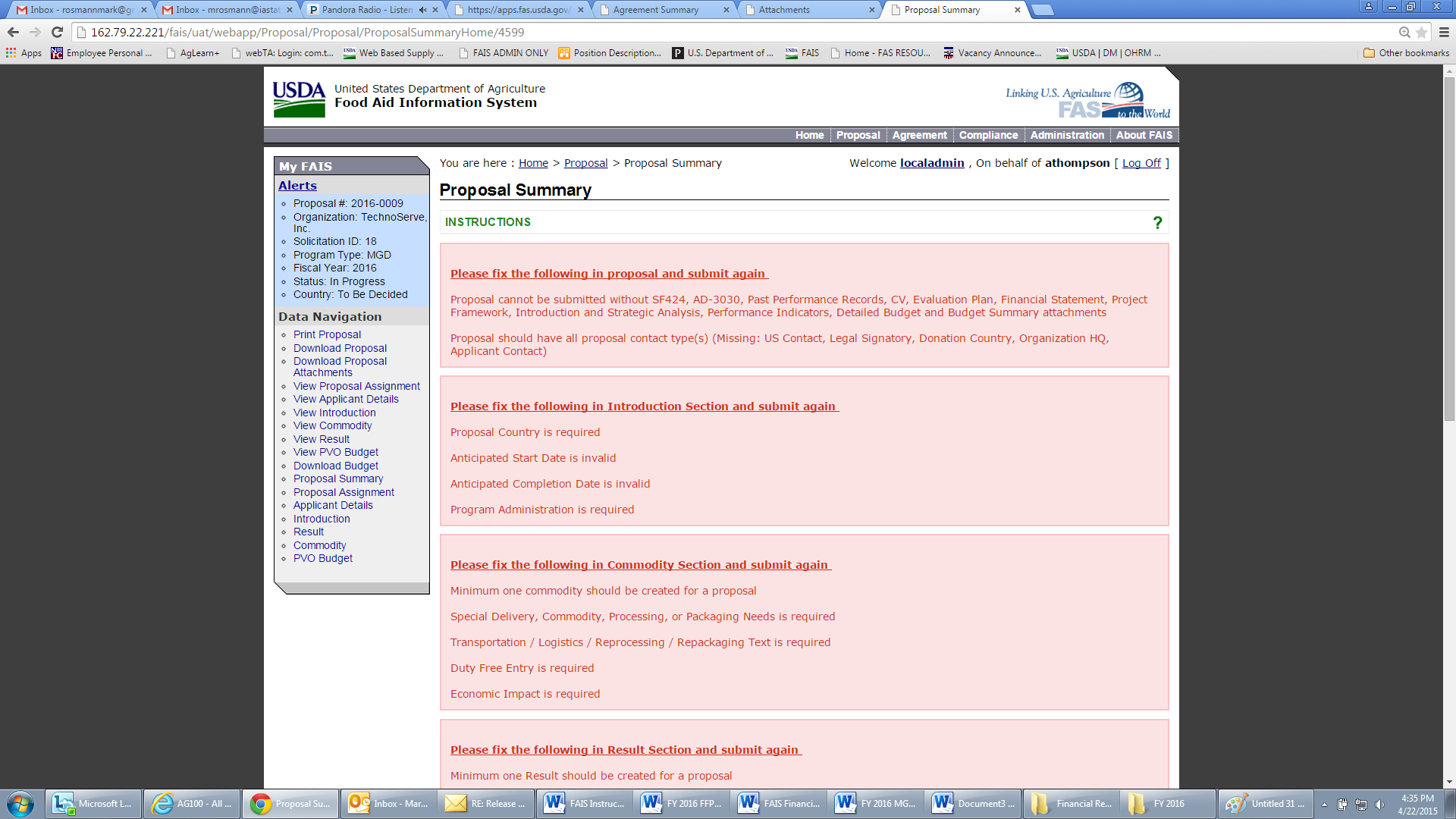
Commodity – If any section is left omitted, the following errors are displayed in either screenshots. In addition, make sure the Commodity Delivery to U.S. Port is included and falls within the proposal start and end dates


Results – Regarding the results section, the following errors are displayed:

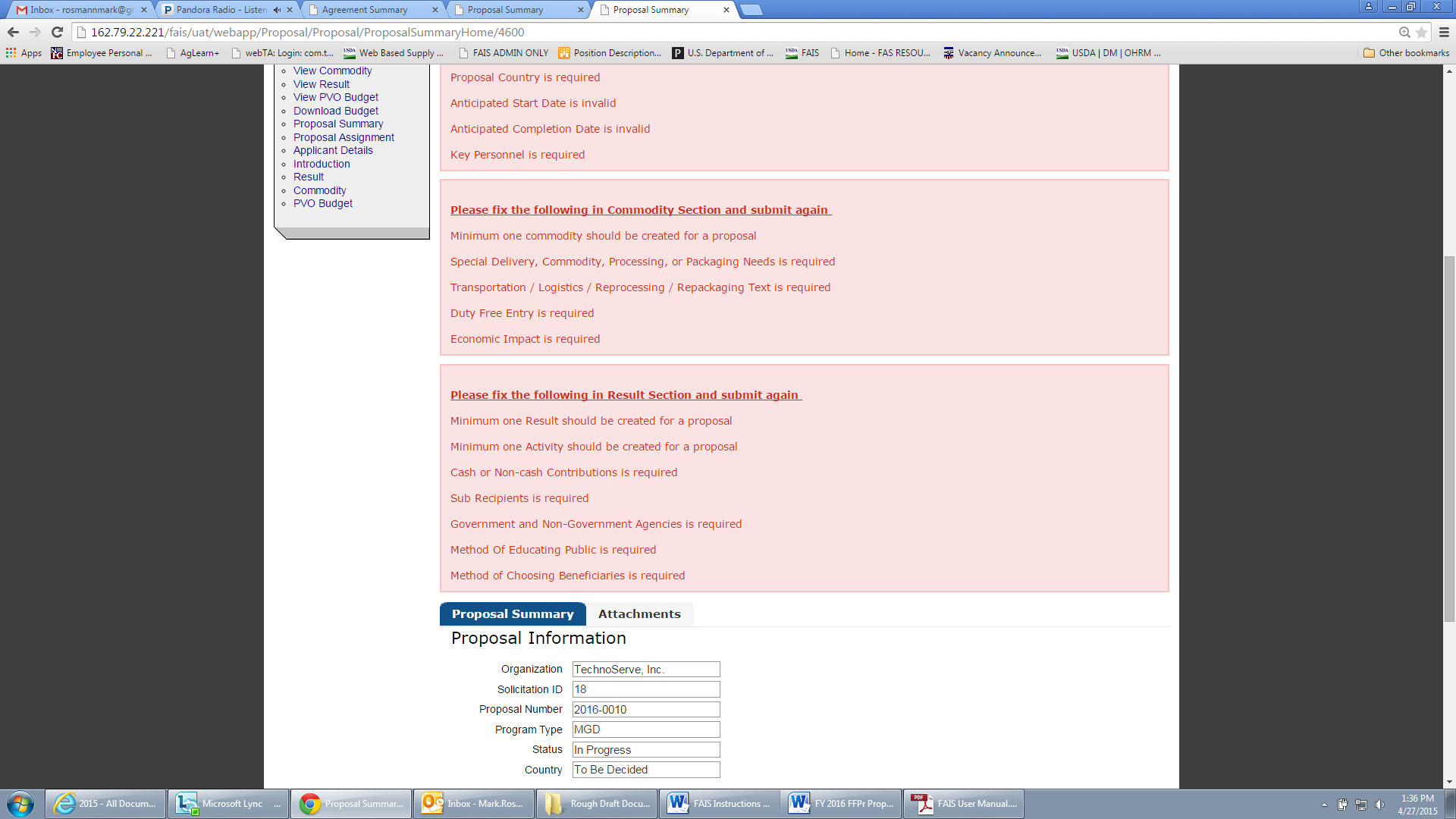
If there are errors with the submission date, the following message will appear. However, this will not prevent the submission of the proposal from occurring.
![]()
Once all errors have been resolved, click Submit for Review. If successful, and no submission errors exist, the Proposal Creator will be given the next options for final submission. Both the Proposal Creator and Director will then have the following available options:

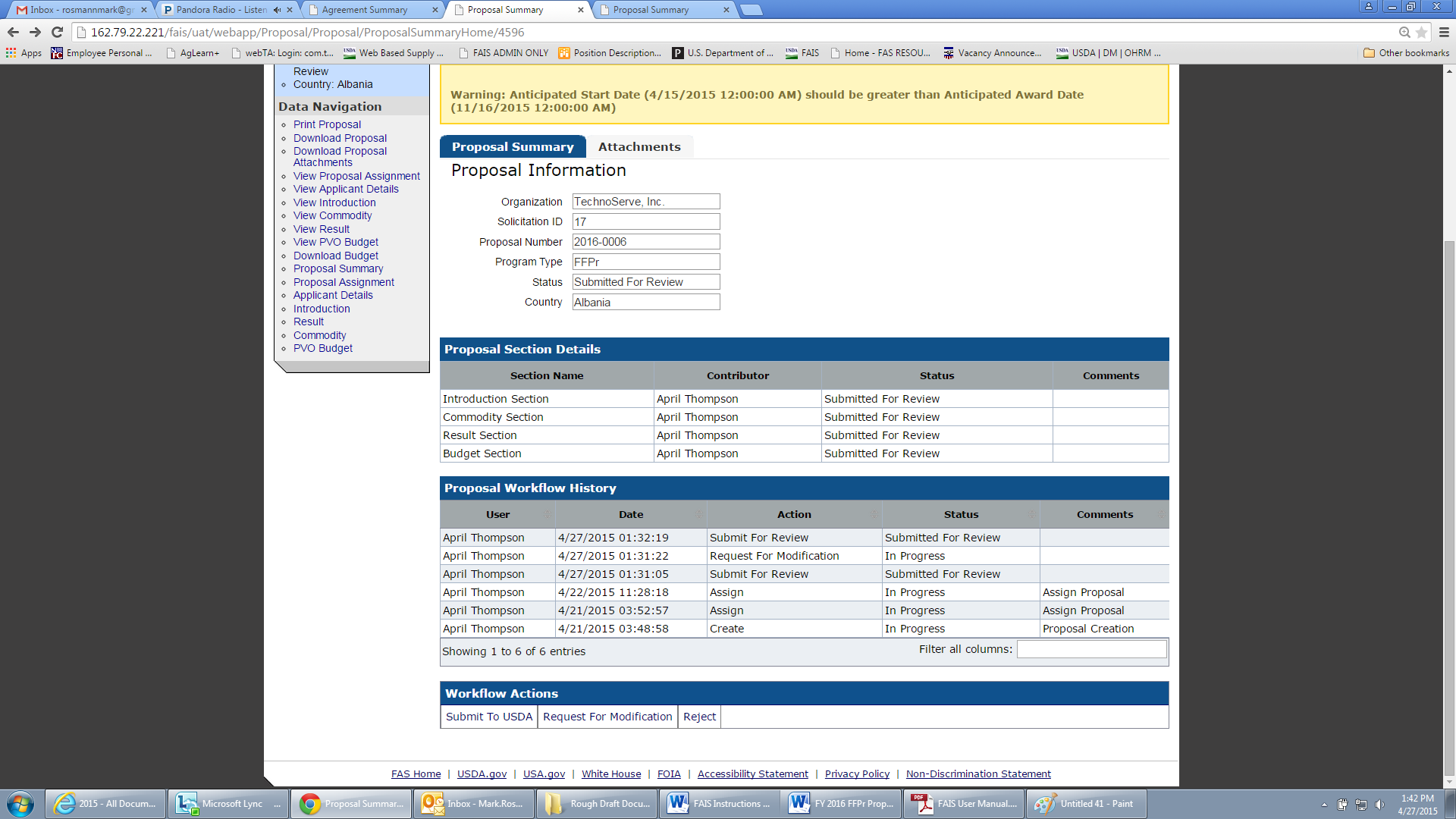
Submit to USDA – This is the final step in submitting the proposal, the proposal creator or director may unsubmit a report if necessary
Request for Modification – If there any changes that need to be made in the proposal, a request will be made and FAIS will generate an e-mail to all assigned contributors. Each section should be submitted and approved by the Proposal Creator or Director
Reject – Proposal submission to FAIS is cancelled. Important: Applicants cannot return to a canceled proposal and can only view the data that was recorded. Proposals are only canceled by the Proposal Creator or Director and should be done only if the organization is certain that the proposal will be abandoned
If the proposal is canceled, the following message will appear:
![]()
If the proposal is submitted successfully, the following message will appear:
![]()
Applicants may return to the Proposal List, and the proposal status for the proposal will be listed as Submitted. Note: Applicants cannot delete any submitted proposals and the link is made inactive.



Prior to the submission deadline, if applicants must return to the proposal and make any revisions, click on the Withdraw link located under Workflow Actions, located in the Proposal Summary page. After the proposal is withdrawn, the applicant has access to make changes to all sections of the proposal. The applicant must submit the proposal using the same links as mentioned earlier.
LRP



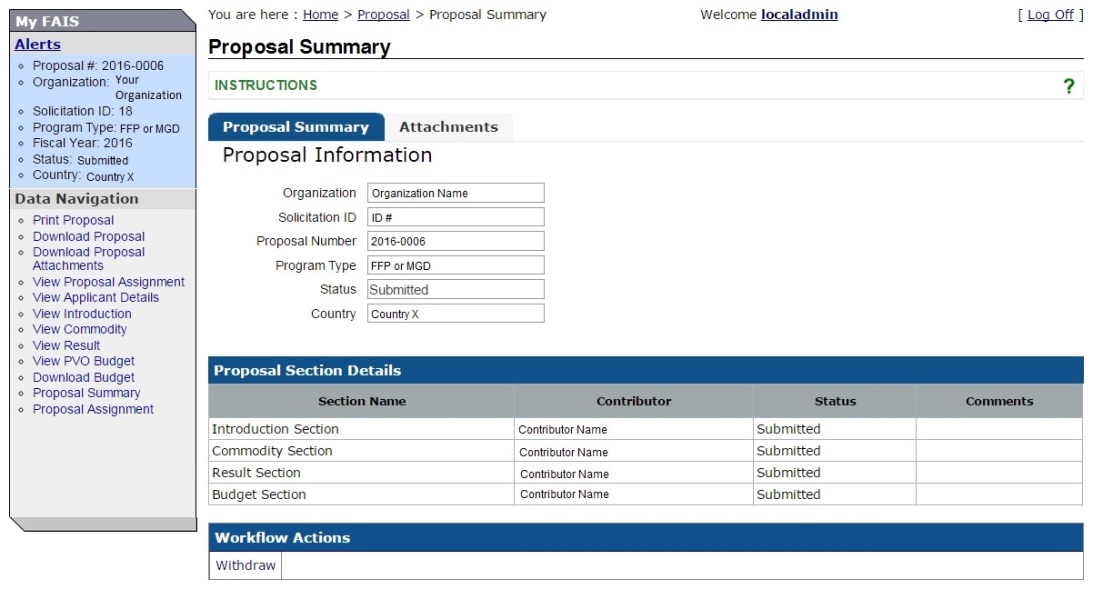
If the award letter is accepted by the PVO applicant, a draft agreement is generated in FAIS. Applicants may consult their USDA-FAS Analyst for more information and instructions regarding this process.
ii http://data.worldbank.org/country/haiti
iii https://www.feedthefuture.gov/sites/default/files/resource/files/HaitiFeedtheFutureMultiYearStrategy_Public_FINAL.pdf
iv https://www.cia.gov/library/publications/the-world-factbook/geos/ha.html
v https://www.usaid.gov/haiti/global-health
vi http://www.wfp.org/countries/haiti/food-security
vii http://www.fao.org/countryprofiles/index/en/?iso3=HTI
viii https://www.usaid.gov/haiti/global-health
ix http://www.wfp.org/countries/haiti/food-security
x http://www.wfp.org/countries/haiti/food-security
xi http://www.fao.org/countryprofiles/index/en/?iso3=HTI
xii http://www.care.org/sites/default/files/documents/Kore-Lavi-Brief.pdf
xiii http://www.haitilibre.com/en/news-13499-haiti-agriculture-purchase-of-more-than-12-000-tons-of-local-products.html
xiv http://www.adb.org/sites/default/files/linked-documents/cps-lao-2012-2016-ssa-07.pdf
xv https://www.cia.gov/library/publications/the-world-factbook/geos/print/country/countrypdf_la.pdf
xvi https://www.wfp.org/countries/lao
xvii http://www.worldbank.org/en/country/lao
xviii https://www.cia.gov/library/publications/the-world-factbook/geos/print/country/countrypdf_la.pdf
xix https://www.wfp.org/countries/lao
xx http://www.adb.org/sites/default/files/linked-documents/cps-lao-2012-2016-ssa-07.pdf
xxi https://www.wfp.org/countries/lao
xxii https://www.cia.gov/library/publications/the-world-factbook/geos/mz.html
xxiii http://www.focus-economics.com/country-indicator/mozambique/gdp-per-capita-USD
xxiv National Institute of Statistics Rwanda, Enquête Intégrale sur les Conditions de Vie de Ménage (EICV 4) 2013-2014, 2015.
xxv Feed the Future: Rwanda 2011-2015 Multi-Year Strategy
xxvi OCRA Rwanda Country Profile
| File Type | application/vnd.openxmlformats-officedocument.wordprocessingml.document |
| Author | Rumery, Molly - FAS |
| File Modified | 0000-00-00 |
| File Created | 2021-01-23 |
© 2025 OMB.report | Privacy Policy